Research and Consultancy Project pdf
VerifiedAdded on 2021/02/19
|38
|17489
|19
AI Summary
Contribute Materials
Your contribution can guide someone’s learning journey. Share your
documents today.

Research and Consultancy
Project
Project
Secure Best Marks with AI Grader
Need help grading? Try our AI Grader for instant feedback on your assignments.
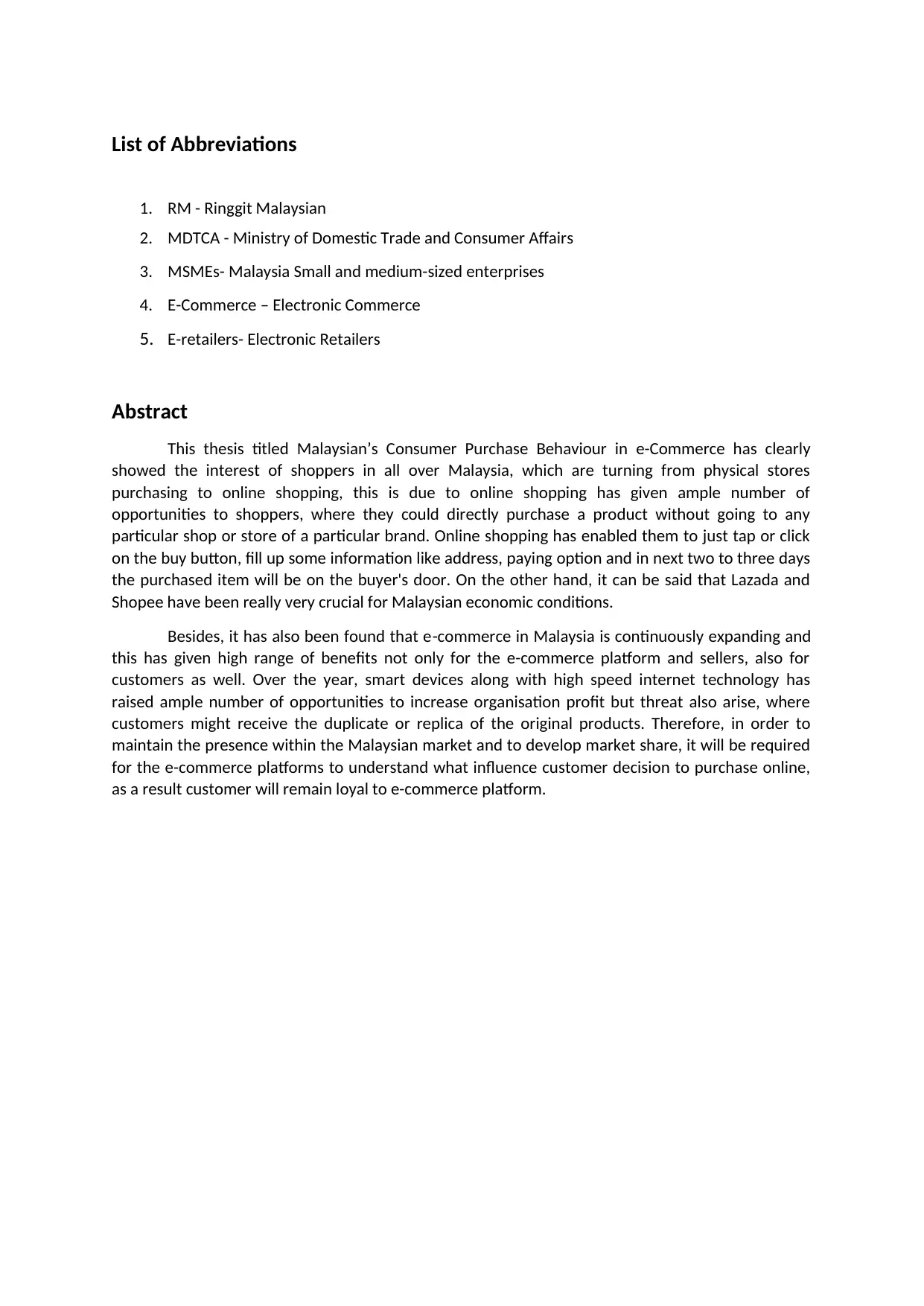
List of Abbreviations
1. RM - Ringgit Malaysian
2. MDTCA - Ministry of Domestic Trade and Consumer Affairs
3. MSMEs- Malaysia Small and medium-sized enterprises
4. E-Commerce – Electronic Commerce
5. E-retailers- Electronic Retailers
Abstract
This thesis titled Malaysian’s Consumer Purchase Behaviour in e-Commerce has clearly
showed the interest of shoppers in all over Malaysia, which are turning from physical stores
purchasing to online shopping, this is due to online shopping has given ample number of
opportunities to shoppers, where they could directly purchase a product without going to any
particular shop or store of a particular brand. Online shopping has enabled them to just tap or click
on the buy button, fill up some information like address, paying option and in next two to three days
the purchased item will be on the buyer's door. On the other hand, it can be said that Lazada and
Shopee have been really very crucial for Malaysian economic conditions.
Besides, it has also been found that e-commerce in Malaysia is continuously expanding and
this has given high range of benefits not only for the e-commerce platform and sellers, also for
customers as well. Over the year, smart devices along with high speed internet technology has
raised ample number of opportunities to increase organisation profit but threat also arise, where
customers might receive the duplicate or replica of the original products. Therefore, in order to
maintain the presence within the Malaysian market and to develop market share, it will be required
for the e-commerce platforms to understand what influence customer decision to purchase online,
as a result customer will remain loyal to e-commerce platform.
1. RM - Ringgit Malaysian
2. MDTCA - Ministry of Domestic Trade and Consumer Affairs
3. MSMEs- Malaysia Small and medium-sized enterprises
4. E-Commerce – Electronic Commerce
5. E-retailers- Electronic Retailers
Abstract
This thesis titled Malaysian’s Consumer Purchase Behaviour in e-Commerce has clearly
showed the interest of shoppers in all over Malaysia, which are turning from physical stores
purchasing to online shopping, this is due to online shopping has given ample number of
opportunities to shoppers, where they could directly purchase a product without going to any
particular shop or store of a particular brand. Online shopping has enabled them to just tap or click
on the buy button, fill up some information like address, paying option and in next two to three days
the purchased item will be on the buyer's door. On the other hand, it can be said that Lazada and
Shopee have been really very crucial for Malaysian economic conditions.
Besides, it has also been found that e-commerce in Malaysia is continuously expanding and
this has given high range of benefits not only for the e-commerce platform and sellers, also for
customers as well. Over the year, smart devices along with high speed internet technology has
raised ample number of opportunities to increase organisation profit but threat also arise, where
customers might receive the duplicate or replica of the original products. Therefore, in order to
maintain the presence within the Malaysian market and to develop market share, it will be required
for the e-commerce platforms to understand what influence customer decision to purchase online,
as a result customer will remain loyal to e-commerce platform.
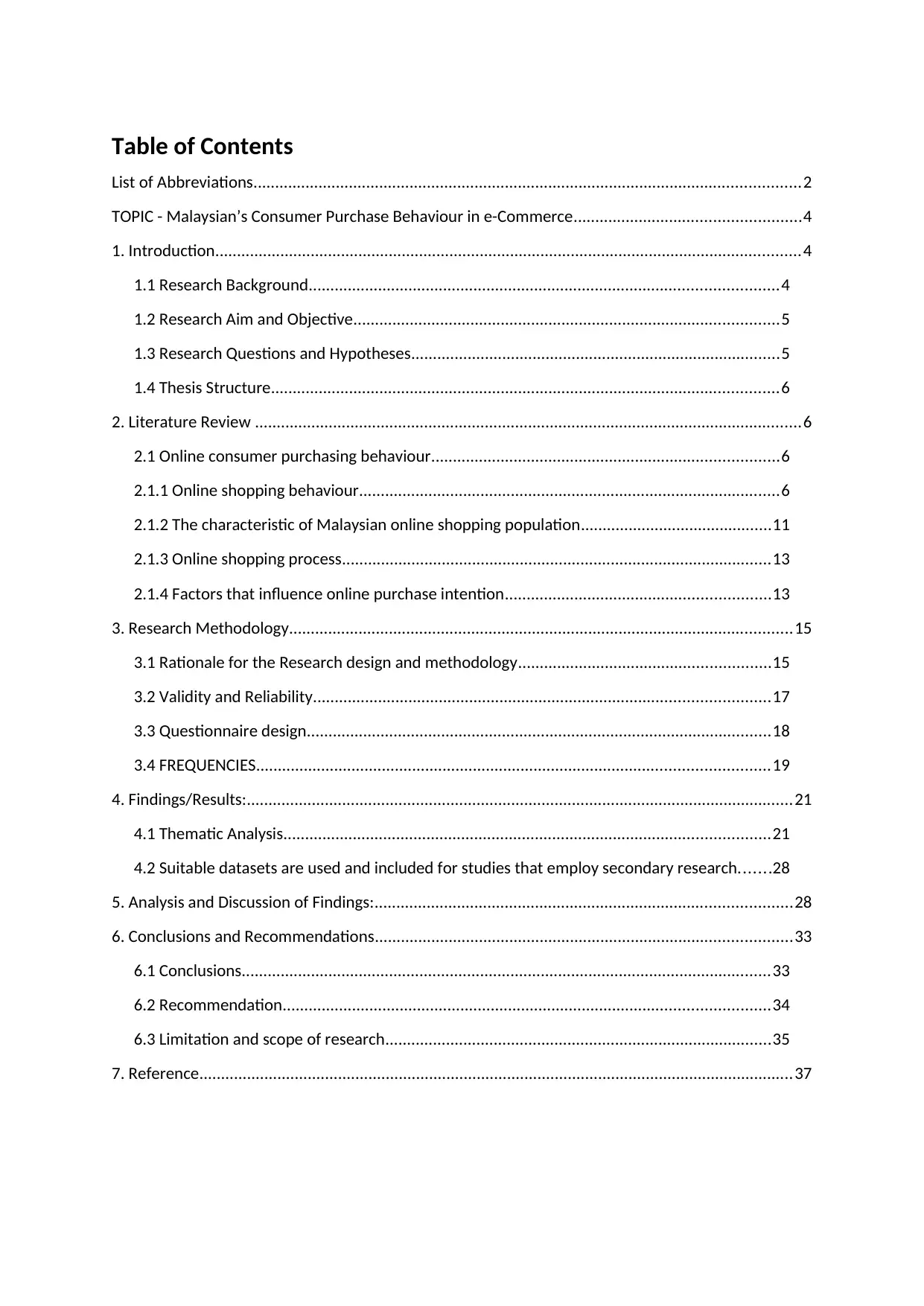
Table of Contents
List of Abbreviations..............................................................................................................................2
TOPIC - Malaysian’s Consumer Purchase Behaviour in e-Commerce....................................................4
1. Introduction.......................................................................................................................................4
1.1 Research Background............................................................................................................4
1.2 Research Aim and Objective..................................................................................................5
1.3 Research Questions and Hypotheses.....................................................................................5
1.4 Thesis Structure.....................................................................................................................6
2. Literature Review ..............................................................................................................................6
2.1 Online consumer purchasing behaviour................................................................................6
2.1.1 Online shopping behaviour.................................................................................................6
2.1.2 The characteristic of Malaysian online shopping population............................................11
2.1.3 Online shopping process...................................................................................................13
2.1.4 Factors that influence online purchase intention.............................................................13
3. Research Methodology....................................................................................................................15
3.1 Rationale for the Research design and methodology..........................................................15
3.2 Validity and Reliability.........................................................................................................17
3.3 Questionnaire design...........................................................................................................18
3.4 FREQUENCIES......................................................................................................................19
4. Findings/Results:..............................................................................................................................21
4.1 Thematic Analysis................................................................................................................21
4.2 Suitable datasets are used and included for studies that employ secondary research.......28
5. Analysis and Discussion of Findings:................................................................................................28
6. Conclusions and Recommendations................................................................................................33
6.1 Conclusions..........................................................................................................................33
6.2 Recommendation................................................................................................................34
6.3 Limitation and scope of research.........................................................................................35
7. Reference.........................................................................................................................................37
List of Abbreviations..............................................................................................................................2
TOPIC - Malaysian’s Consumer Purchase Behaviour in e-Commerce....................................................4
1. Introduction.......................................................................................................................................4
1.1 Research Background............................................................................................................4
1.2 Research Aim and Objective..................................................................................................5
1.3 Research Questions and Hypotheses.....................................................................................5
1.4 Thesis Structure.....................................................................................................................6
2. Literature Review ..............................................................................................................................6
2.1 Online consumer purchasing behaviour................................................................................6
2.1.1 Online shopping behaviour.................................................................................................6
2.1.2 The characteristic of Malaysian online shopping population............................................11
2.1.3 Online shopping process...................................................................................................13
2.1.4 Factors that influence online purchase intention.............................................................13
3. Research Methodology....................................................................................................................15
3.1 Rationale for the Research design and methodology..........................................................15
3.2 Validity and Reliability.........................................................................................................17
3.3 Questionnaire design...........................................................................................................18
3.4 FREQUENCIES......................................................................................................................19
4. Findings/Results:..............................................................................................................................21
4.1 Thematic Analysis................................................................................................................21
4.2 Suitable datasets are used and included for studies that employ secondary research.......28
5. Analysis and Discussion of Findings:................................................................................................28
6. Conclusions and Recommendations................................................................................................33
6.1 Conclusions..........................................................................................................................33
6.2 Recommendation................................................................................................................34
6.3 Limitation and scope of research.........................................................................................35
7. Reference.........................................................................................................................................37
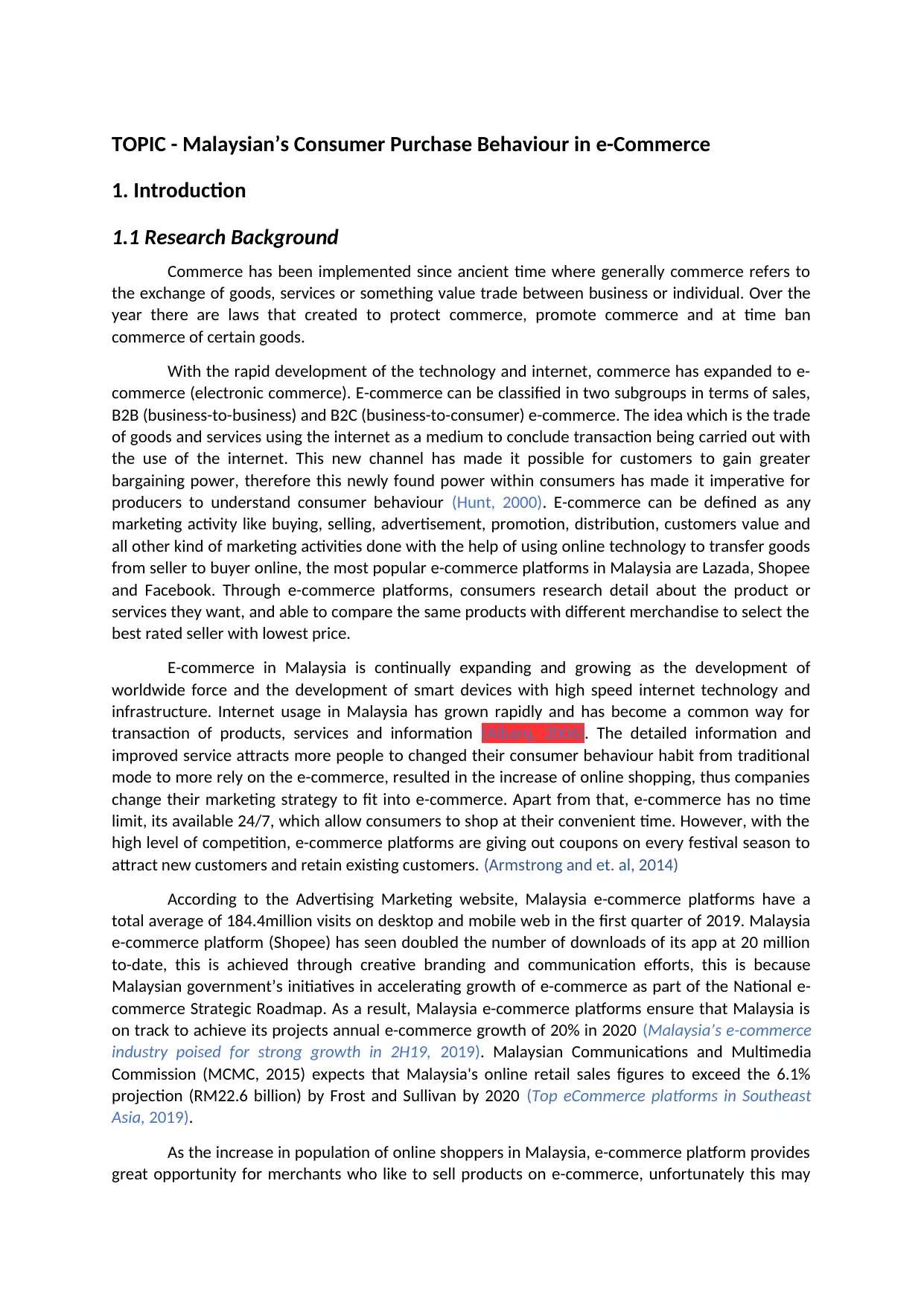
TOPIC - Malaysian’s Consumer Purchase Behaviour in e-Commerce
1. Introduction
1.1 Research Background
Commerce has been implemented since ancient time where generally commerce refers to
the exchange of goods, services or something value trade between business or individual. Over the
year there are laws that created to protect commerce, promote commerce and at time ban
commerce of certain goods.
With the rapid development of the technology and internet, commerce has expanded to e-
commerce (electronic commerce). E-commerce can be classified in two subgroups in terms of sales,
B2B (business-to-business) and B2C (business-to-consumer) e-commerce. The idea which is the trade
of goods and services using the internet as a medium to conclude transaction being carried out with
the use of the internet. This new channel has made it possible for customers to gain greater
bargaining power, therefore this newly found power within consumers has made it imperative for
producers to understand consumer behaviour (Hunt, 2000). E-commerce can be defined as any
marketing activity like buying, selling, advertisement, promotion, distribution, customers value and
all other kind of marketing activities done with the help of using online technology to transfer goods
from seller to buyer online, the most popular e-commerce platforms in Malaysia are Lazada, Shopee
and Facebook. Through e-commerce platforms, consumers research detail about the product or
services they want, and able to compare the same products with different merchandise to select the
best rated seller with lowest price.
E-commerce in Malaysia is continually expanding and growing as the development of
worldwide force and the development of smart devices with high speed internet technology and
infrastructure. Internet usage in Malaysia has grown rapidly and has become a common way for
transaction of products, services and information (Albarq, 2006). The detailed information and
improved service attracts more people to changed their consumer behaviour habit from traditional
mode to more rely on the e-commerce, resulted in the increase of online shopping, thus companies
change their marketing strategy to fit into e-commerce. Apart from that, e-commerce has no time
limit, its available 24/7, which allow consumers to shop at their convenient time. However, with the
high level of competition, e-commerce platforms are giving out coupons on every festival season to
attract new customers and retain existing customers. (Armstrong and et. al, 2014)
According to the Advertising Marketing website, Malaysia e-commerce platforms have a
total average of 184.4million visits on desktop and mobile web in the first quarter of 2019. Malaysia
e-commerce platform (Shopee) has seen doubled the number of downloads of its app at 20 million
to-date, this is achieved through creative branding and communication efforts, this is because
Malaysian government’s initiatives in accelerating growth of e-commerce as part of the National e-
commerce Strategic Roadmap. As a result, Malaysia e-commerce platforms ensure that Malaysia is
on track to achieve its projects annual e-commerce growth of 20% in 2020 (Malaysia’s e-commerce
industry poised for strong growth in 2H19, 2019). Malaysian Communications and Multimedia
Commission (MCMC, 2015) expects that Malaysia's online retail sales figures to exceed the 6.1%
projection (RM22.6 billion) by Frost and Sullivan by 2020 (Top eCommerce platforms in Southeast
Asia, 2019).
As the increase in population of online shoppers in Malaysia, e-commerce platform provides
great opportunity for merchants who like to sell products on e-commerce, unfortunately this may
1. Introduction
1.1 Research Background
Commerce has been implemented since ancient time where generally commerce refers to
the exchange of goods, services or something value trade between business or individual. Over the
year there are laws that created to protect commerce, promote commerce and at time ban
commerce of certain goods.
With the rapid development of the technology and internet, commerce has expanded to e-
commerce (electronic commerce). E-commerce can be classified in two subgroups in terms of sales,
B2B (business-to-business) and B2C (business-to-consumer) e-commerce. The idea which is the trade
of goods and services using the internet as a medium to conclude transaction being carried out with
the use of the internet. This new channel has made it possible for customers to gain greater
bargaining power, therefore this newly found power within consumers has made it imperative for
producers to understand consumer behaviour (Hunt, 2000). E-commerce can be defined as any
marketing activity like buying, selling, advertisement, promotion, distribution, customers value and
all other kind of marketing activities done with the help of using online technology to transfer goods
from seller to buyer online, the most popular e-commerce platforms in Malaysia are Lazada, Shopee
and Facebook. Through e-commerce platforms, consumers research detail about the product or
services they want, and able to compare the same products with different merchandise to select the
best rated seller with lowest price.
E-commerce in Malaysia is continually expanding and growing as the development of
worldwide force and the development of smart devices with high speed internet technology and
infrastructure. Internet usage in Malaysia has grown rapidly and has become a common way for
transaction of products, services and information (Albarq, 2006). The detailed information and
improved service attracts more people to changed their consumer behaviour habit from traditional
mode to more rely on the e-commerce, resulted in the increase of online shopping, thus companies
change their marketing strategy to fit into e-commerce. Apart from that, e-commerce has no time
limit, its available 24/7, which allow consumers to shop at their convenient time. However, with the
high level of competition, e-commerce platforms are giving out coupons on every festival season to
attract new customers and retain existing customers. (Armstrong and et. al, 2014)
According to the Advertising Marketing website, Malaysia e-commerce platforms have a
total average of 184.4million visits on desktop and mobile web in the first quarter of 2019. Malaysia
e-commerce platform (Shopee) has seen doubled the number of downloads of its app at 20 million
to-date, this is achieved through creative branding and communication efforts, this is because
Malaysian government’s initiatives in accelerating growth of e-commerce as part of the National e-
commerce Strategic Roadmap. As a result, Malaysia e-commerce platforms ensure that Malaysia is
on track to achieve its projects annual e-commerce growth of 20% in 2020 (Malaysia’s e-commerce
industry poised for strong growth in 2H19, 2019). Malaysian Communications and Multimedia
Commission (MCMC, 2015) expects that Malaysia's online retail sales figures to exceed the 6.1%
projection (RM22.6 billion) by Frost and Sullivan by 2020 (Top eCommerce platforms in Southeast
Asia, 2019).
As the increase in population of online shoppers in Malaysia, e-commerce platform provides
great opportunity for merchants who like to sell products on e-commerce, unfortunately this may
Paraphrase This Document
Need a fresh take? Get an instant paraphrase of this document with our AI Paraphraser
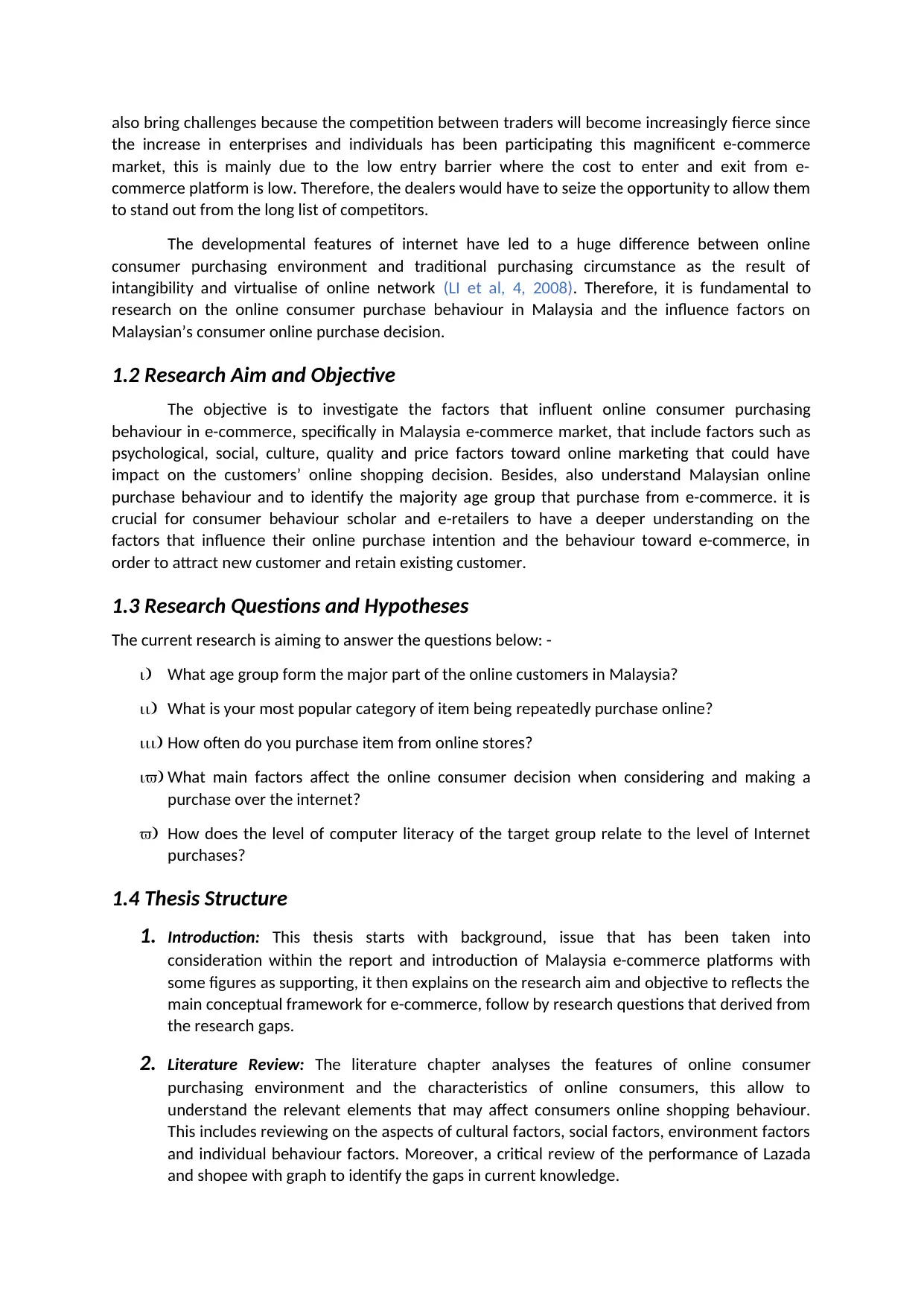
also bring challenges because the competition between traders will become increasingly fierce since
the increase in enterprises and individuals has been participating this magnificent e-commerce
market, this is mainly due to the low entry barrier where the cost to enter and exit from e-
commerce platform is low. Therefore, the dealers would have to seize the opportunity to allow them
to stand out from the long list of competitors.
The developmental features of internet have led to a huge difference between online
consumer purchasing environment and traditional purchasing circumstance as the result of
intangibility and virtualise of online network (LI et al, 4, 2008). Therefore, it is fundamental to
research on the online consumer purchase behaviour in Malaysia and the influence factors on
Malaysian’s consumer online purchase decision.
1.2 Research Aim and Objective
The objective is to investigate the factors that influent online consumer purchasing
behaviour in e-commerce, specifically in Malaysia e-commerce market, that include factors such as
psychological, social, culture, quality and price factors toward online marketing that could have
impact on the customers’ online shopping decision. Besides, also understand Malaysian online
purchase behaviour and to identify the majority age group that purchase from e-commerce. it is
crucial for consumer behaviour scholar and e-retailers to have a deeper understanding on the
factors that influence their online purchase intention and the behaviour toward e-commerce, in
order to attract new customer and retain existing customer.
1.3 Research Questions and Hypotheses
The current research is aiming to answer the questions below: -
i) What age group form the major part of the online customers in Malaysia?
ii) What is your most popular category of item being repeatedly purchase online?
iii) How often do you purchase item from online stores?
iv) What main factors affect the online consumer decision when considering and making a
purchase over the internet?
v) How does the level of computer literacy of the target group relate to the level of Internet
purchases?
1.4 Thesis Structure
1. Introduction: This thesis starts with background, issue that has been taken into
consideration within the report and introduction of Malaysia e-commerce platforms with
some figures as supporting, it then explains on the research aim and objective to reflects the
main conceptual framework for e-commerce, follow by research questions that derived from
the research gaps.
2. Literature Review: The literature chapter analyses the features of online consumer
purchasing environment and the characteristics of online consumers, this allow to
understand the relevant elements that may affect consumers online shopping behaviour.
This includes reviewing on the aspects of cultural factors, social factors, environment factors
and individual behaviour factors. Moreover, a critical review of the performance of Lazada
and shopee with graph to identify the gaps in current knowledge.
the increase in enterprises and individuals has been participating this magnificent e-commerce
market, this is mainly due to the low entry barrier where the cost to enter and exit from e-
commerce platform is low. Therefore, the dealers would have to seize the opportunity to allow them
to stand out from the long list of competitors.
The developmental features of internet have led to a huge difference between online
consumer purchasing environment and traditional purchasing circumstance as the result of
intangibility and virtualise of online network (LI et al, 4, 2008). Therefore, it is fundamental to
research on the online consumer purchase behaviour in Malaysia and the influence factors on
Malaysian’s consumer online purchase decision.
1.2 Research Aim and Objective
The objective is to investigate the factors that influent online consumer purchasing
behaviour in e-commerce, specifically in Malaysia e-commerce market, that include factors such as
psychological, social, culture, quality and price factors toward online marketing that could have
impact on the customers’ online shopping decision. Besides, also understand Malaysian online
purchase behaviour and to identify the majority age group that purchase from e-commerce. it is
crucial for consumer behaviour scholar and e-retailers to have a deeper understanding on the
factors that influence their online purchase intention and the behaviour toward e-commerce, in
order to attract new customer and retain existing customer.
1.3 Research Questions and Hypotheses
The current research is aiming to answer the questions below: -
i) What age group form the major part of the online customers in Malaysia?
ii) What is your most popular category of item being repeatedly purchase online?
iii) How often do you purchase item from online stores?
iv) What main factors affect the online consumer decision when considering and making a
purchase over the internet?
v) How does the level of computer literacy of the target group relate to the level of Internet
purchases?
1.4 Thesis Structure
1. Introduction: This thesis starts with background, issue that has been taken into
consideration within the report and introduction of Malaysia e-commerce platforms with
some figures as supporting, it then explains on the research aim and objective to reflects the
main conceptual framework for e-commerce, follow by research questions that derived from
the research gaps.
2. Literature Review: The literature chapter analyses the features of online consumer
purchasing environment and the characteristics of online consumers, this allow to
understand the relevant elements that may affect consumers online shopping behaviour.
This includes reviewing on the aspects of cultural factors, social factors, environment factors
and individual behaviour factors. Moreover, a critical review of the performance of Lazada
and shopee with graph to identify the gaps in current knowledge.
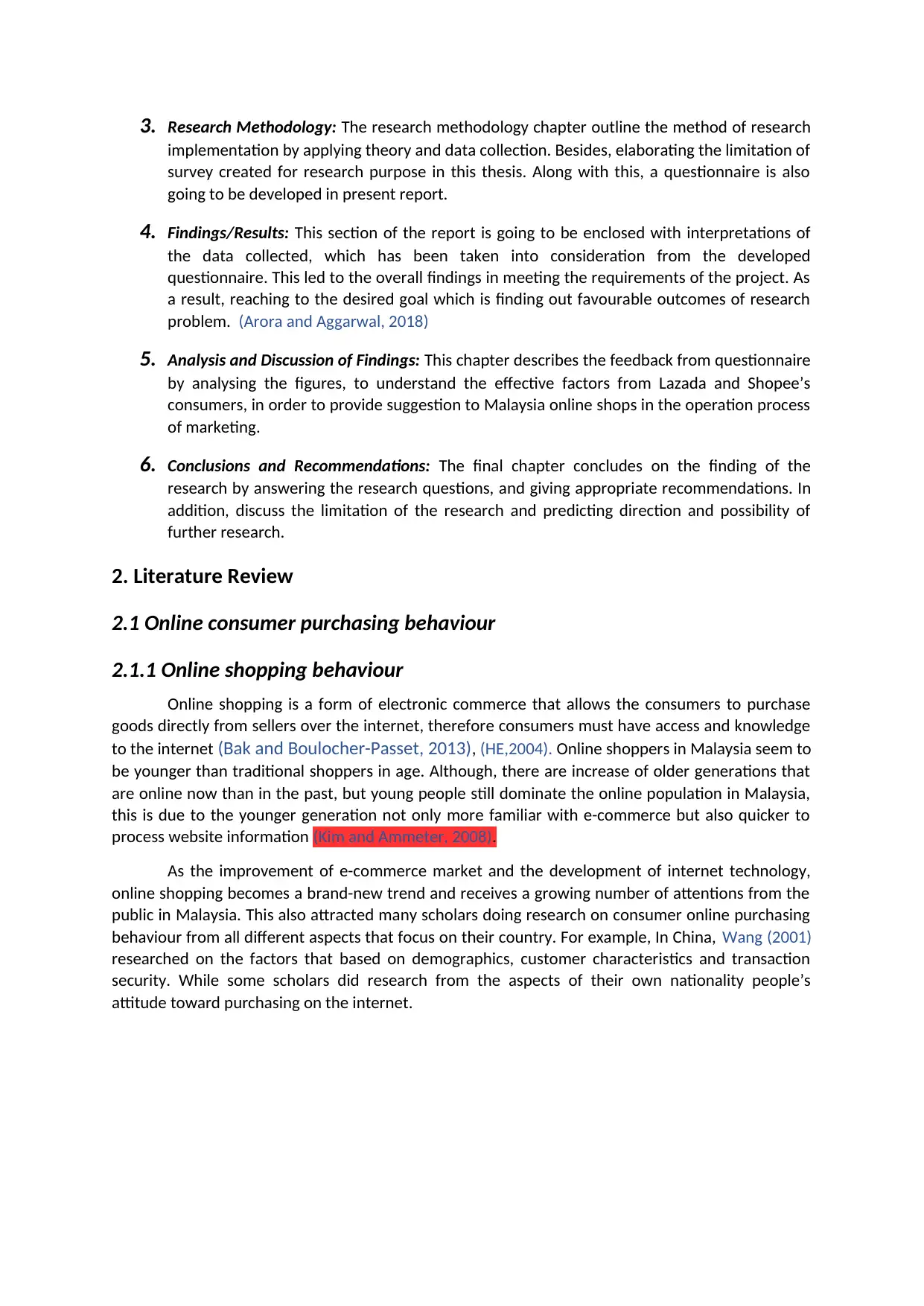
3. Research Methodology: The research methodology chapter outline the method of research
implementation by applying theory and data collection. Besides, elaborating the limitation of
survey created for research purpose in this thesis. Along with this, a questionnaire is also
going to be developed in present report.
4. Findings/Results: This section of the report is going to be enclosed with interpretations of
the data collected, which has been taken into consideration from the developed
questionnaire. This led to the overall findings in meeting the requirements of the project. As
a result, reaching to the desired goal which is finding out favourable outcomes of research
problem. (Arora and Aggarwal, 2018)
5. Analysis and Discussion of Findings: This chapter describes the feedback from questionnaire
by analysing the figures, to understand the effective factors from Lazada and Shopee’s
consumers, in order to provide suggestion to Malaysia online shops in the operation process
of marketing.
6. Conclusions and Recommendations: The final chapter concludes on the finding of the
research by answering the research questions, and giving appropriate recommendations. In
addition, discuss the limitation of the research and predicting direction and possibility of
further research.
2. Literature Review
2.1 Online consumer purchasing behaviour
2.1.1 Online shopping behaviour
Online shopping is a form of electronic commerce that allows the consumers to purchase
goods directly from sellers over the internet, therefore consumers must have access and knowledge
to the internet (Bak and Boulocher-Passet, 2013), (HE,2004). Online shoppers in Malaysia seem to
be younger than traditional shoppers in age. Although, there are increase of older generations that
are online now than in the past, but young people still dominate the online population in Malaysia,
this is due to the younger generation not only more familiar with e-commerce but also quicker to
process website information (Kim and Ammeter, 2008).
As the improvement of e-commerce market and the development of internet technology,
online shopping becomes a brand-new trend and receives a growing number of attentions from the
public in Malaysia. This also attracted many scholars doing research on consumer online purchasing
behaviour from all different aspects that focus on their country. For example, In China, Wang (2001)
researched on the factors that based on demographics, customer characteristics and transaction
security. While some scholars did research from the aspects of their own nationality people’s
attitude toward purchasing on the internet.
implementation by applying theory and data collection. Besides, elaborating the limitation of
survey created for research purpose in this thesis. Along with this, a questionnaire is also
going to be developed in present report.
4. Findings/Results: This section of the report is going to be enclosed with interpretations of
the data collected, which has been taken into consideration from the developed
questionnaire. This led to the overall findings in meeting the requirements of the project. As
a result, reaching to the desired goal which is finding out favourable outcomes of research
problem. (Arora and Aggarwal, 2018)
5. Analysis and Discussion of Findings: This chapter describes the feedback from questionnaire
by analysing the figures, to understand the effective factors from Lazada and Shopee’s
consumers, in order to provide suggestion to Malaysia online shops in the operation process
of marketing.
6. Conclusions and Recommendations: The final chapter concludes on the finding of the
research by answering the research questions, and giving appropriate recommendations. In
addition, discuss the limitation of the research and predicting direction and possibility of
further research.
2. Literature Review
2.1 Online consumer purchasing behaviour
2.1.1 Online shopping behaviour
Online shopping is a form of electronic commerce that allows the consumers to purchase
goods directly from sellers over the internet, therefore consumers must have access and knowledge
to the internet (Bak and Boulocher-Passet, 2013), (HE,2004). Online shoppers in Malaysia seem to
be younger than traditional shoppers in age. Although, there are increase of older generations that
are online now than in the past, but young people still dominate the online population in Malaysia,
this is due to the younger generation not only more familiar with e-commerce but also quicker to
process website information (Kim and Ammeter, 2008).
As the improvement of e-commerce market and the development of internet technology,
online shopping becomes a brand-new trend and receives a growing number of attentions from the
public in Malaysia. This also attracted many scholars doing research on consumer online purchasing
behaviour from all different aspects that focus on their country. For example, In China, Wang (2001)
researched on the factors that based on demographics, customer characteristics and transaction
security. While some scholars did research from the aspects of their own nationality people’s
attitude toward purchasing on the internet.

(Source: Malaysia's online shopping behaviour in infographic, 2019)
The above infographic illustrate that Malaysian prefers online shopping than purchasing
products and services from physical stores. The above-mentioned figure is showing that
most Malaysian use desktop computers for e-commerce with the percentage of 68%. On the
other hand, 1 from 3 online transaction by consumers were made through smartphones
which give 31%. On the other side, tablets have the highest average order value which have
RM339. Follow by smartphones RM314, and lastly, RM284 by desktop. As well as it has also
been found that women in Malaysia shops more than Males through online websites where
around 58 out of 100. whereas, only 42 out of 100 males in Malaysia shopping from online
portal. Along with this, considering the above figure it can also said that more than 51% of
Malaysian online shoppers basically coming in between the age of 18 – 34.
(Sources: Weekly Average Spending of the different races, 2019)
I
llustration 2: Weekly Average Spending
Illustration 1: Malaysia's online shopping behaviour in infographic, 2019
The above infographic illustrate that Malaysian prefers online shopping than purchasing
products and services from physical stores. The above-mentioned figure is showing that
most Malaysian use desktop computers for e-commerce with the percentage of 68%. On the
other hand, 1 from 3 online transaction by consumers were made through smartphones
which give 31%. On the other side, tablets have the highest average order value which have
RM339. Follow by smartphones RM314, and lastly, RM284 by desktop. As well as it has also
been found that women in Malaysia shops more than Males through online websites where
around 58 out of 100. whereas, only 42 out of 100 males in Malaysia shopping from online
portal. Along with this, considering the above figure it can also said that more than 51% of
Malaysian online shoppers basically coming in between the age of 18 – 34.
(Sources: Weekly Average Spending of the different races, 2019)
I
llustration 2: Weekly Average Spending
Illustration 1: Malaysia's online shopping behaviour in infographic, 2019
Secure Best Marks with AI Grader
Need help grading? Try our AI Grader for instant feedback on your assignments.
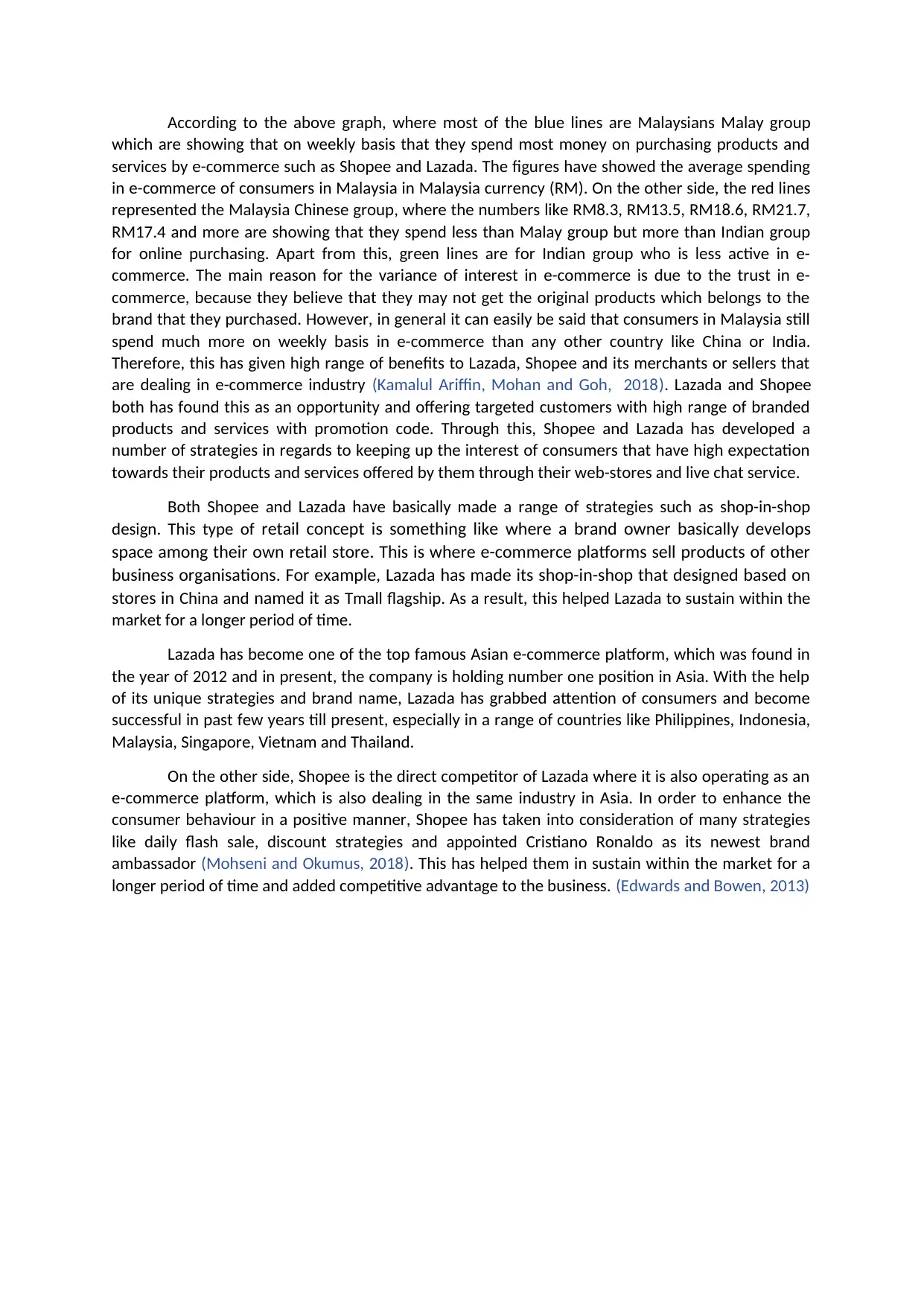
According to the above graph, where most of the blue lines are Malaysians Malay group
which are showing that on weekly basis that they spend most money on purchasing products and
services by e-commerce such as Shopee and Lazada. The figures have showed the average spending
in e-commerce of consumers in Malaysia in Malaysia currency (RM). On the other side, the red lines
represented the Malaysia Chinese group, where the numbers like RM8.3, RM13.5, RM18.6, RM21.7,
RM17.4 and more are showing that they spend less than Malay group but more than Indian group
for online purchasing. Apart from this, green lines are for Indian group who is less active in e-
commerce. The main reason for the variance of interest in e-commerce is due to the trust in e-
commerce, because they believe that they may not get the original products which belongs to the
brand that they purchased. However, in general it can easily be said that consumers in Malaysia still
spend much more on weekly basis in e-commerce than any other country like China or India.
Therefore, this has given high range of benefits to Lazada, Shopee and its merchants or sellers that
are dealing in e-commerce industry (Kamalul Ariffin, Mohan and Goh, 2018). Lazada and Shopee
both has found this as an opportunity and offering targeted customers with high range of branded
products and services with promotion code. Through this, Shopee and Lazada has developed a
number of strategies in regards to keeping up the interest of consumers that have high expectation
towards their products and services offered by them through their web-stores and live chat service.
Both Shopee and Lazada have basically made a range of strategies such as shop-in-shop
design. This type of retail concept is something like where a brand owner basically develops
space among their own retail store. This is where e-commerce platforms sell products of other
business organisations. For example, Lazada has made its shop-in-shop that designed based on
stores in China and named it as Tmall flagship. As a result, this helped Lazada to sustain within the
market for a longer period of time.
Lazada has become one of the top famous Asian e-commerce platform, which was found in
the year of 2012 and in present, the company is holding number one position in Asia. With the help
of its unique strategies and brand name, Lazada has grabbed attention of consumers and become
successful in past few years till present, especially in a range of countries like Philippines, Indonesia,
Malaysia, Singapore, Vietnam and Thailand.
On the other side, Shopee is the direct competitor of Lazada where it is also operating as an
e-commerce platform, which is also dealing in the same industry in Asia. In order to enhance the
consumer behaviour in a positive manner, Shopee has taken into consideration of many strategies
like daily flash sale, discount strategies and appointed Cristiano Ronaldo as its newest brand
ambassador (Mohseni and Okumus, 2018). This has helped them in sustain within the market for a
longer period of time and added competitive advantage to the business. (Edwards and Bowen, 2013)
which are showing that on weekly basis that they spend most money on purchasing products and
services by e-commerce such as Shopee and Lazada. The figures have showed the average spending
in e-commerce of consumers in Malaysia in Malaysia currency (RM). On the other side, the red lines
represented the Malaysia Chinese group, where the numbers like RM8.3, RM13.5, RM18.6, RM21.7,
RM17.4 and more are showing that they spend less than Malay group but more than Indian group
for online purchasing. Apart from this, green lines are for Indian group who is less active in e-
commerce. The main reason for the variance of interest in e-commerce is due to the trust in e-
commerce, because they believe that they may not get the original products which belongs to the
brand that they purchased. However, in general it can easily be said that consumers in Malaysia still
spend much more on weekly basis in e-commerce than any other country like China or India.
Therefore, this has given high range of benefits to Lazada, Shopee and its merchants or sellers that
are dealing in e-commerce industry (Kamalul Ariffin, Mohan and Goh, 2018). Lazada and Shopee
both has found this as an opportunity and offering targeted customers with high range of branded
products and services with promotion code. Through this, Shopee and Lazada has developed a
number of strategies in regards to keeping up the interest of consumers that have high expectation
towards their products and services offered by them through their web-stores and live chat service.
Both Shopee and Lazada have basically made a range of strategies such as shop-in-shop
design. This type of retail concept is something like where a brand owner basically develops
space among their own retail store. This is where e-commerce platforms sell products of other
business organisations. For example, Lazada has made its shop-in-shop that designed based on
stores in China and named it as Tmall flagship. As a result, this helped Lazada to sustain within the
market for a longer period of time.
Lazada has become one of the top famous Asian e-commerce platform, which was found in
the year of 2012 and in present, the company is holding number one position in Asia. With the help
of its unique strategies and brand name, Lazada has grabbed attention of consumers and become
successful in past few years till present, especially in a range of countries like Philippines, Indonesia,
Malaysia, Singapore, Vietnam and Thailand.
On the other side, Shopee is the direct competitor of Lazada where it is also operating as an
e-commerce platform, which is also dealing in the same industry in Asia. In order to enhance the
consumer behaviour in a positive manner, Shopee has taken into consideration of many strategies
like daily flash sale, discount strategies and appointed Cristiano Ronaldo as its newest brand
ambassador (Mohseni and Okumus, 2018). This has helped them in sustain within the market for a
longer period of time and added competitive advantage to the business. (Edwards and Bowen, 2013)
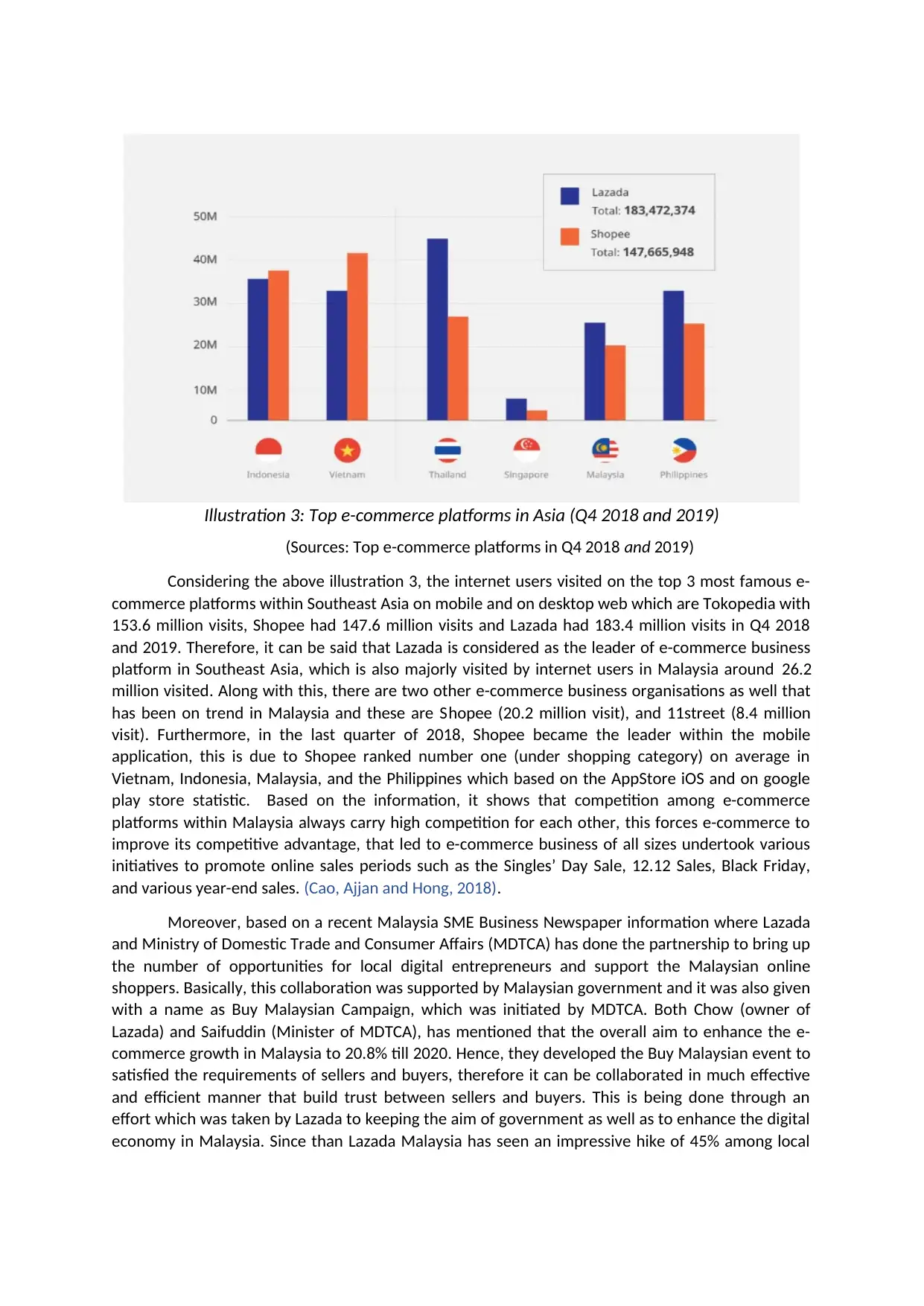
(Sources: Top e-commerce platforms in Q4 2018 and 2019)
Considering the above illustration 3, the internet users visited on the top 3 most famous e-
commerce platforms within Southeast Asia on mobile and on desktop web which are Tokopedia with
153.6 million visits, Shopee had 147.6 million visits and Lazada had 183.4 million visits in Q4 2018
and 2019. Therefore, it can be said that Lazada is considered as the leader of e-commerce business
platform in Southeast Asia, which is also majorly visited by internet users in Malaysia around 26.2
million visited. Along with this, there are two other e-commerce business organisations as well that
has been on trend in Malaysia and these are Shopee (20.2 million visit), and 11street (8.4 million
visit). Furthermore, in the last quarter of 2018, Shopee became the leader within the mobile
application, this is due to Shopee ranked number one (under shopping category) on average in
Vietnam, Indonesia, Malaysia, and the Philippines which based on the AppStore iOS and on google
play store statistic. Based on the information, it shows that competition among e-commerce
platforms within Malaysia always carry high competition for each other, this forces e-commerce to
improve its competitive advantage, that led to e-commerce business of all sizes undertook various
initiatives to promote online sales periods such as the Singles’ Day Sale, 12.12 Sales, Black Friday,
and various year-end sales. (Cao, Ajjan and Hong, 2018).
Moreover, based on a recent Malaysia SME Business Newspaper information where Lazada
and Ministry of Domestic Trade and Consumer Affairs (MDTCA) has done the partnership to bring up
the number of opportunities for local digital entrepreneurs and support the Malaysian online
shoppers. Basically, this collaboration was supported by Malaysian government and it was also given
with a name as Buy Malaysian Campaign, which was initiated by MDTCA. Both Chow (owner of
Lazada) and Saifuddin (Minister of MDTCA), has mentioned that the overall aim to enhance the e-
commerce growth in Malaysia to 20.8% till 2020. Hence, they developed the Buy Malaysian event to
satisfied the requirements of sellers and buyers, therefore it can be collaborated in much effective
and efficient manner that build trust between sellers and buyers. This is being done through an
effort which was taken by Lazada to keeping the aim of government as well as to enhance the digital
economy in Malaysia. Since than Lazada Malaysia has seen an impressive hike of 45% among local
Illustration 3: Top e-commerce platforms in Asia (Q4 2018 and 2019)
Considering the above illustration 3, the internet users visited on the top 3 most famous e-
commerce platforms within Southeast Asia on mobile and on desktop web which are Tokopedia with
153.6 million visits, Shopee had 147.6 million visits and Lazada had 183.4 million visits in Q4 2018
and 2019. Therefore, it can be said that Lazada is considered as the leader of e-commerce business
platform in Southeast Asia, which is also majorly visited by internet users in Malaysia around 26.2
million visited. Along with this, there are two other e-commerce business organisations as well that
has been on trend in Malaysia and these are Shopee (20.2 million visit), and 11street (8.4 million
visit). Furthermore, in the last quarter of 2018, Shopee became the leader within the mobile
application, this is due to Shopee ranked number one (under shopping category) on average in
Vietnam, Indonesia, Malaysia, and the Philippines which based on the AppStore iOS and on google
play store statistic. Based on the information, it shows that competition among e-commerce
platforms within Malaysia always carry high competition for each other, this forces e-commerce to
improve its competitive advantage, that led to e-commerce business of all sizes undertook various
initiatives to promote online sales periods such as the Singles’ Day Sale, 12.12 Sales, Black Friday,
and various year-end sales. (Cao, Ajjan and Hong, 2018).
Moreover, based on a recent Malaysia SME Business Newspaper information where Lazada
and Ministry of Domestic Trade and Consumer Affairs (MDTCA) has done the partnership to bring up
the number of opportunities for local digital entrepreneurs and support the Malaysian online
shoppers. Basically, this collaboration was supported by Malaysian government and it was also given
with a name as Buy Malaysian Campaign, which was initiated by MDTCA. Both Chow (owner of
Lazada) and Saifuddin (Minister of MDTCA), has mentioned that the overall aim to enhance the e-
commerce growth in Malaysia to 20.8% till 2020. Hence, they developed the Buy Malaysian event to
satisfied the requirements of sellers and buyers, therefore it can be collaborated in much effective
and efficient manner that build trust between sellers and buyers. This is being done through an
effort which was taken by Lazada to keeping the aim of government as well as to enhance the digital
economy in Malaysia. Since than Lazada Malaysia has seen an impressive hike of 45% among local
Illustration 3: Top e-commerce platforms in Asia (Q4 2018 and 2019)
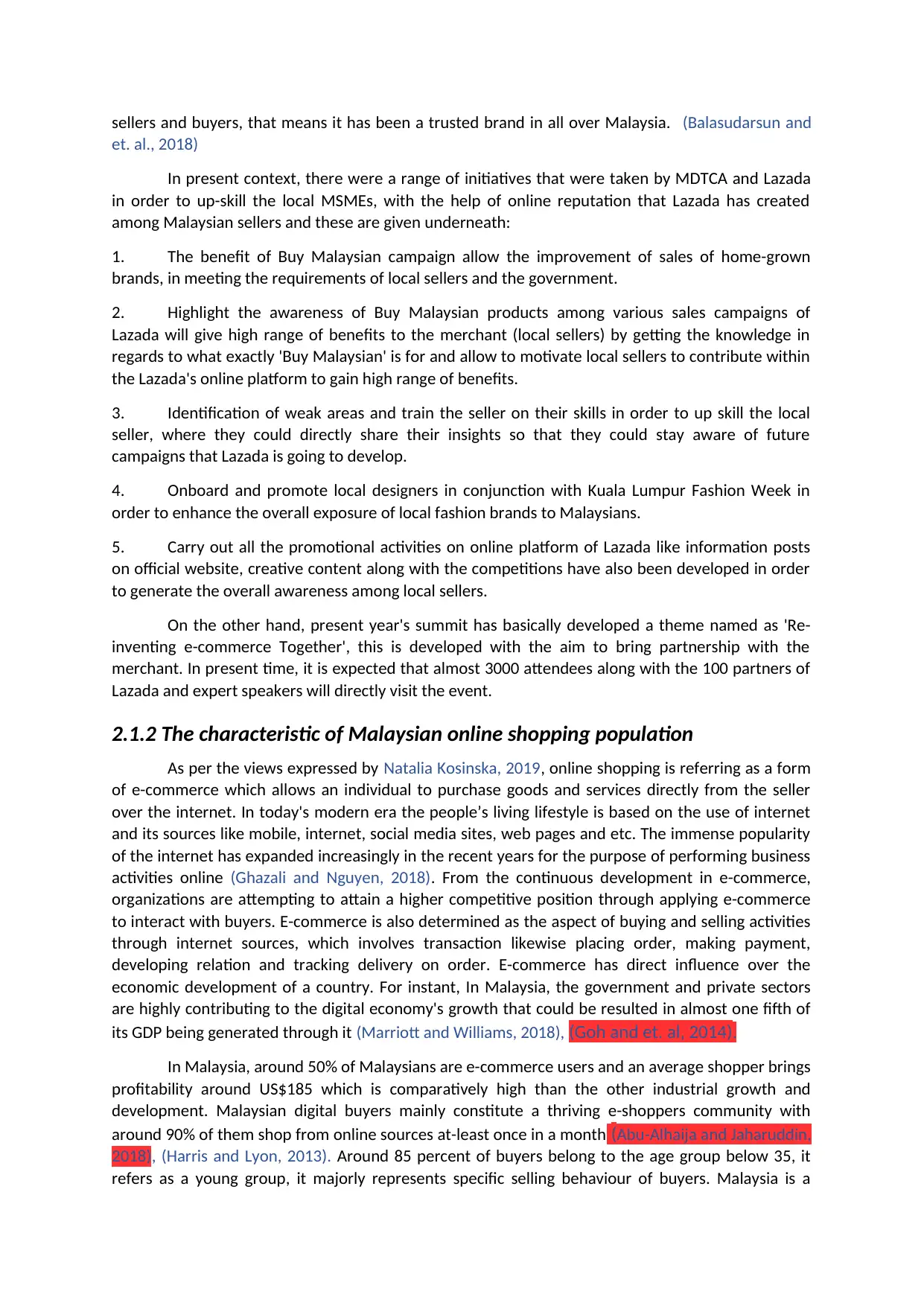
sellers and buyers, that means it has been a trusted brand in all over Malaysia. (Balasudarsun and
et. al., 2018)
In present context, there were a range of initiatives that were taken by MDTCA and Lazada
in order to up-skill the local MSMEs, with the help of online reputation that Lazada has created
among Malaysian sellers and these are given underneath:
1. The benefit of Buy Malaysian campaign allow the improvement of sales of home-grown
brands, in meeting the requirements of local sellers and the government.
2. Highlight the awareness of Buy Malaysian products among various sales campaigns of
Lazada will give high range of benefits to the merchant (local sellers) by getting the knowledge in
regards to what exactly 'Buy Malaysian' is for and allow to motivate local sellers to contribute within
the Lazada's online platform to gain high range of benefits.
3. Identification of weak areas and train the seller on their skills in order to up skill the local
seller, where they could directly share their insights so that they could stay aware of future
campaigns that Lazada is going to develop.
4. Onboard and promote local designers in conjunction with Kuala Lumpur Fashion Week in
order to enhance the overall exposure of local fashion brands to Malaysians.
5. Carry out all the promotional activities on online platform of Lazada like information posts
on official website, creative content along with the competitions have also been developed in order
to generate the overall awareness among local sellers.
On the other hand, present year's summit has basically developed a theme named as 'Re-
inventing e-commerce Together', this is developed with the aim to bring partnership with the
merchant. In present time, it is expected that almost 3000 attendees along with the 100 partners of
Lazada and expert speakers will directly visit the event.
2.1.2 The characteristic of Malaysian online shopping population
As per the views expressed by Natalia Kosinska, 2019, online shopping is referring as a form
of e-commerce which allows an individual to purchase goods and services directly from the seller
over the internet. In today's modern era the people’s living lifestyle is based on the use of internet
and its sources like mobile, internet, social media sites, web pages and etc. The immense popularity
of the internet has expanded increasingly in the recent years for the purpose of performing business
activities online (Ghazali and Nguyen, 2018). From the continuous development in e-commerce,
organizations are attempting to attain a higher competitive position through applying e-commerce
to interact with buyers. E-commerce is also determined as the aspect of buying and selling activities
through internet sources, which involves transaction likewise placing order, making payment,
developing relation and tracking delivery on order. E-commerce has direct influence over the
economic development of a country. For instant, In Malaysia, the government and private sectors
are highly contributing to the digital economy's growth that could be resulted in almost one fifth of
its GDP being generated through it (Marriott and Williams, 2018), (Goh and et. al, 2014).
In Malaysia, around 50% of Malaysians are e-commerce users and an average shopper brings
profitability around US$185 which is comparatively high than the other industrial growth and
development. Malaysian digital buyers mainly constitute a thriving e-shoppers community with
around 90% of them shop from online sources at-least once in a month (Abu-Alhaija and Jaharuddin,
2018), (Harris and Lyon, 2013). Around 85 percent of buyers belong to the age group below 35, it
refers as a young group, it majorly represents specific selling behaviour of buyers. Malaysia is a
et. al., 2018)
In present context, there were a range of initiatives that were taken by MDTCA and Lazada
in order to up-skill the local MSMEs, with the help of online reputation that Lazada has created
among Malaysian sellers and these are given underneath:
1. The benefit of Buy Malaysian campaign allow the improvement of sales of home-grown
brands, in meeting the requirements of local sellers and the government.
2. Highlight the awareness of Buy Malaysian products among various sales campaigns of
Lazada will give high range of benefits to the merchant (local sellers) by getting the knowledge in
regards to what exactly 'Buy Malaysian' is for and allow to motivate local sellers to contribute within
the Lazada's online platform to gain high range of benefits.
3. Identification of weak areas and train the seller on their skills in order to up skill the local
seller, where they could directly share their insights so that they could stay aware of future
campaigns that Lazada is going to develop.
4. Onboard and promote local designers in conjunction with Kuala Lumpur Fashion Week in
order to enhance the overall exposure of local fashion brands to Malaysians.
5. Carry out all the promotional activities on online platform of Lazada like information posts
on official website, creative content along with the competitions have also been developed in order
to generate the overall awareness among local sellers.
On the other hand, present year's summit has basically developed a theme named as 'Re-
inventing e-commerce Together', this is developed with the aim to bring partnership with the
merchant. In present time, it is expected that almost 3000 attendees along with the 100 partners of
Lazada and expert speakers will directly visit the event.
2.1.2 The characteristic of Malaysian online shopping population
As per the views expressed by Natalia Kosinska, 2019, online shopping is referring as a form
of e-commerce which allows an individual to purchase goods and services directly from the seller
over the internet. In today's modern era the people’s living lifestyle is based on the use of internet
and its sources like mobile, internet, social media sites, web pages and etc. The immense popularity
of the internet has expanded increasingly in the recent years for the purpose of performing business
activities online (Ghazali and Nguyen, 2018). From the continuous development in e-commerce,
organizations are attempting to attain a higher competitive position through applying e-commerce
to interact with buyers. E-commerce is also determined as the aspect of buying and selling activities
through internet sources, which involves transaction likewise placing order, making payment,
developing relation and tracking delivery on order. E-commerce has direct influence over the
economic development of a country. For instant, In Malaysia, the government and private sectors
are highly contributing to the digital economy's growth that could be resulted in almost one fifth of
its GDP being generated through it (Marriott and Williams, 2018), (Goh and et. al, 2014).
In Malaysia, around 50% of Malaysians are e-commerce users and an average shopper brings
profitability around US$185 which is comparatively high than the other industrial growth and
development. Malaysian digital buyers mainly constitute a thriving e-shoppers community with
around 90% of them shop from online sources at-least once in a month (Abu-Alhaija and Jaharuddin,
2018), (Harris and Lyon, 2013). Around 85 percent of buyers belong to the age group below 35, it
refers as a young group, it majorly represents specific selling behaviour of buyers. Malaysia is a
Paraphrase This Document
Need a fresh take? Get an instant paraphrase of this document with our AI Paraphraser
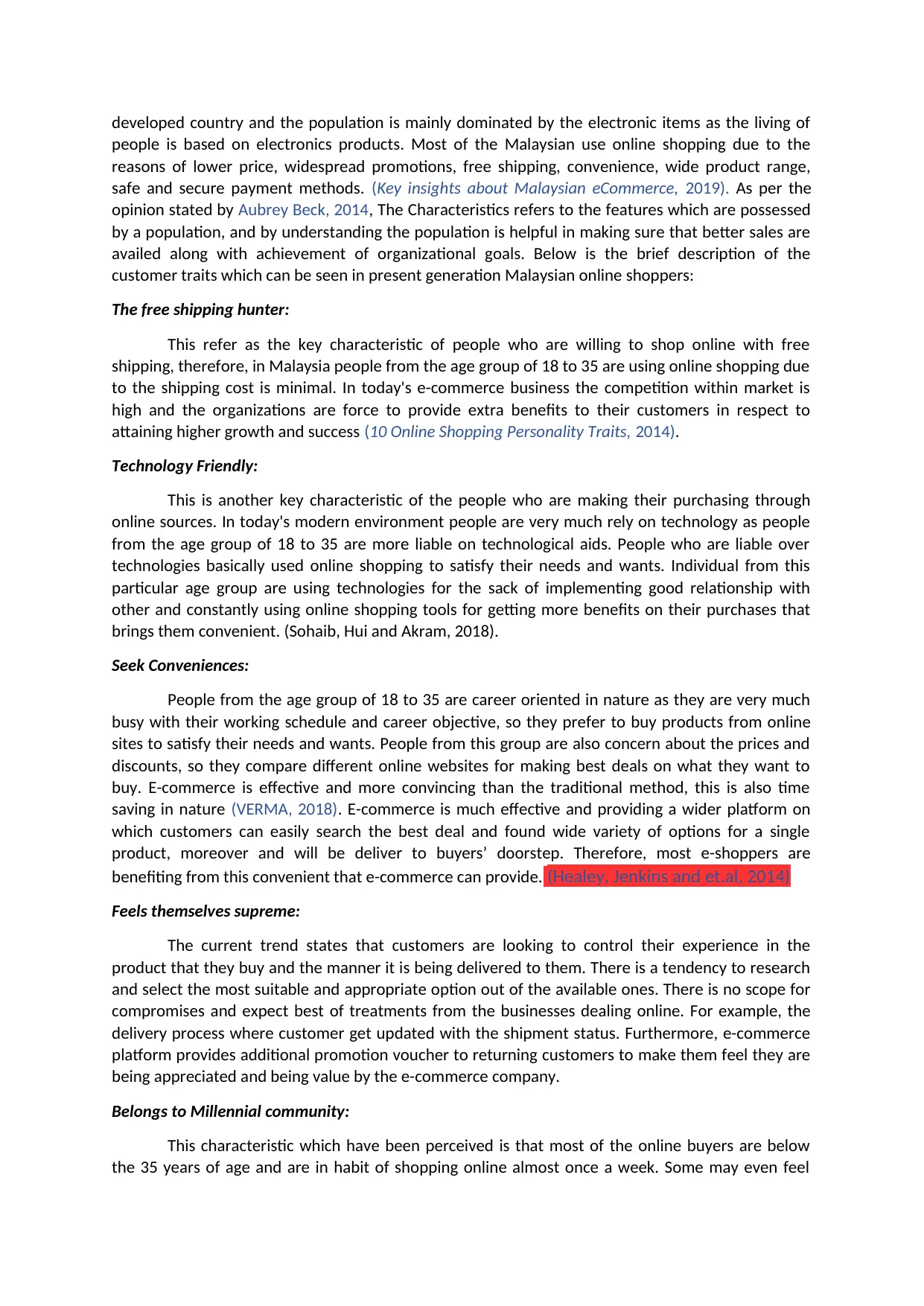
developed country and the population is mainly dominated by the electronic items as the living of
people is based on electronics products. Most of the Malaysian use online shopping due to the
reasons of lower price, widespread promotions, free shipping, convenience, wide product range,
safe and secure payment methods. (Key insights about Malaysian eCommerce, 2019). As per the
opinion stated by Aubrey Beck, 2014, The Characteristics refers to the features which are possessed
by a population, and by understanding the population is helpful in making sure that better sales are
availed along with achievement of organizational goals. Below is the brief description of the
customer traits which can be seen in present generation Malaysian online shoppers:
The free shipping hunter:
This refer as the key characteristic of people who are willing to shop online with free
shipping, therefore, in Malaysia people from the age group of 18 to 35 are using online shopping due
to the shipping cost is minimal. In today's e-commerce business the competition within market is
high and the organizations are force to provide extra benefits to their customers in respect to
attaining higher growth and success (10 Online Shopping Personality Traits, 2014).
Technology Friendly:
This is another key characteristic of the people who are making their purchasing through
online sources. In today's modern environment people are very much rely on technology as people
from the age group of 18 to 35 are more liable on technological aids. People who are liable over
technologies basically used online shopping to satisfy their needs and wants. Individual from this
particular age group are using technologies for the sack of implementing good relationship with
other and constantly using online shopping tools for getting more benefits on their purchases that
brings them convenient. (Sohaib, Hui and Akram, 2018).
Seek Conveniences:
People from the age group of 18 to 35 are career oriented in nature as they are very much
busy with their working schedule and career objective, so they prefer to buy products from online
sites to satisfy their needs and wants. People from this group are also concern about the prices and
discounts, so they compare different online websites for making best deals on what they want to
buy. E-commerce is effective and more convincing than the traditional method, this is also time
saving in nature (VERMA, 2018). E-commerce is much effective and providing a wider platform on
which customers can easily search the best deal and found wide variety of options for a single
product, moreover and will be deliver to buyers’ doorstep. Therefore, most e-shoppers are
benefiting from this convenient that e-commerce can provide. (Healey, Jenkins and et.al, 2014)
Feels themselves supreme:
The current trend states that customers are looking to control their experience in the
product that they buy and the manner it is being delivered to them. There is a tendency to research
and select the most suitable and appropriate option out of the available ones. There is no scope for
compromises and expect best of treatments from the businesses dealing online. For example, the
delivery process where customer get updated with the shipment status. Furthermore, e-commerce
platform provides additional promotion voucher to returning customers to make them feel they are
being appreciated and being value by the e-commerce company.
Belongs to Millennial community:
This characteristic which have been perceived is that most of the online buyers are below
the 35 years of age and are in habit of shopping online almost once a week. Some may even feel
people is based on electronics products. Most of the Malaysian use online shopping due to the
reasons of lower price, widespread promotions, free shipping, convenience, wide product range,
safe and secure payment methods. (Key insights about Malaysian eCommerce, 2019). As per the
opinion stated by Aubrey Beck, 2014, The Characteristics refers to the features which are possessed
by a population, and by understanding the population is helpful in making sure that better sales are
availed along with achievement of organizational goals. Below is the brief description of the
customer traits which can be seen in present generation Malaysian online shoppers:
The free shipping hunter:
This refer as the key characteristic of people who are willing to shop online with free
shipping, therefore, in Malaysia people from the age group of 18 to 35 are using online shopping due
to the shipping cost is minimal. In today's e-commerce business the competition within market is
high and the organizations are force to provide extra benefits to their customers in respect to
attaining higher growth and success (10 Online Shopping Personality Traits, 2014).
Technology Friendly:
This is another key characteristic of the people who are making their purchasing through
online sources. In today's modern environment people are very much rely on technology as people
from the age group of 18 to 35 are more liable on technological aids. People who are liable over
technologies basically used online shopping to satisfy their needs and wants. Individual from this
particular age group are using technologies for the sack of implementing good relationship with
other and constantly using online shopping tools for getting more benefits on their purchases that
brings them convenient. (Sohaib, Hui and Akram, 2018).
Seek Conveniences:
People from the age group of 18 to 35 are career oriented in nature as they are very much
busy with their working schedule and career objective, so they prefer to buy products from online
sites to satisfy their needs and wants. People from this group are also concern about the prices and
discounts, so they compare different online websites for making best deals on what they want to
buy. E-commerce is effective and more convincing than the traditional method, this is also time
saving in nature (VERMA, 2018). E-commerce is much effective and providing a wider platform on
which customers can easily search the best deal and found wide variety of options for a single
product, moreover and will be deliver to buyers’ doorstep. Therefore, most e-shoppers are
benefiting from this convenient that e-commerce can provide. (Healey, Jenkins and et.al, 2014)
Feels themselves supreme:
The current trend states that customers are looking to control their experience in the
product that they buy and the manner it is being delivered to them. There is a tendency to research
and select the most suitable and appropriate option out of the available ones. There is no scope for
compromises and expect best of treatments from the businesses dealing online. For example, the
delivery process where customer get updated with the shipment status. Furthermore, e-commerce
platform provides additional promotion voucher to returning customers to make them feel they are
being appreciated and being value by the e-commerce company.
Belongs to Millennial community:
This characteristic which have been perceived is that most of the online buyers are below
the 35 years of age and are in habit of shopping online almost once a week. Some may even feel
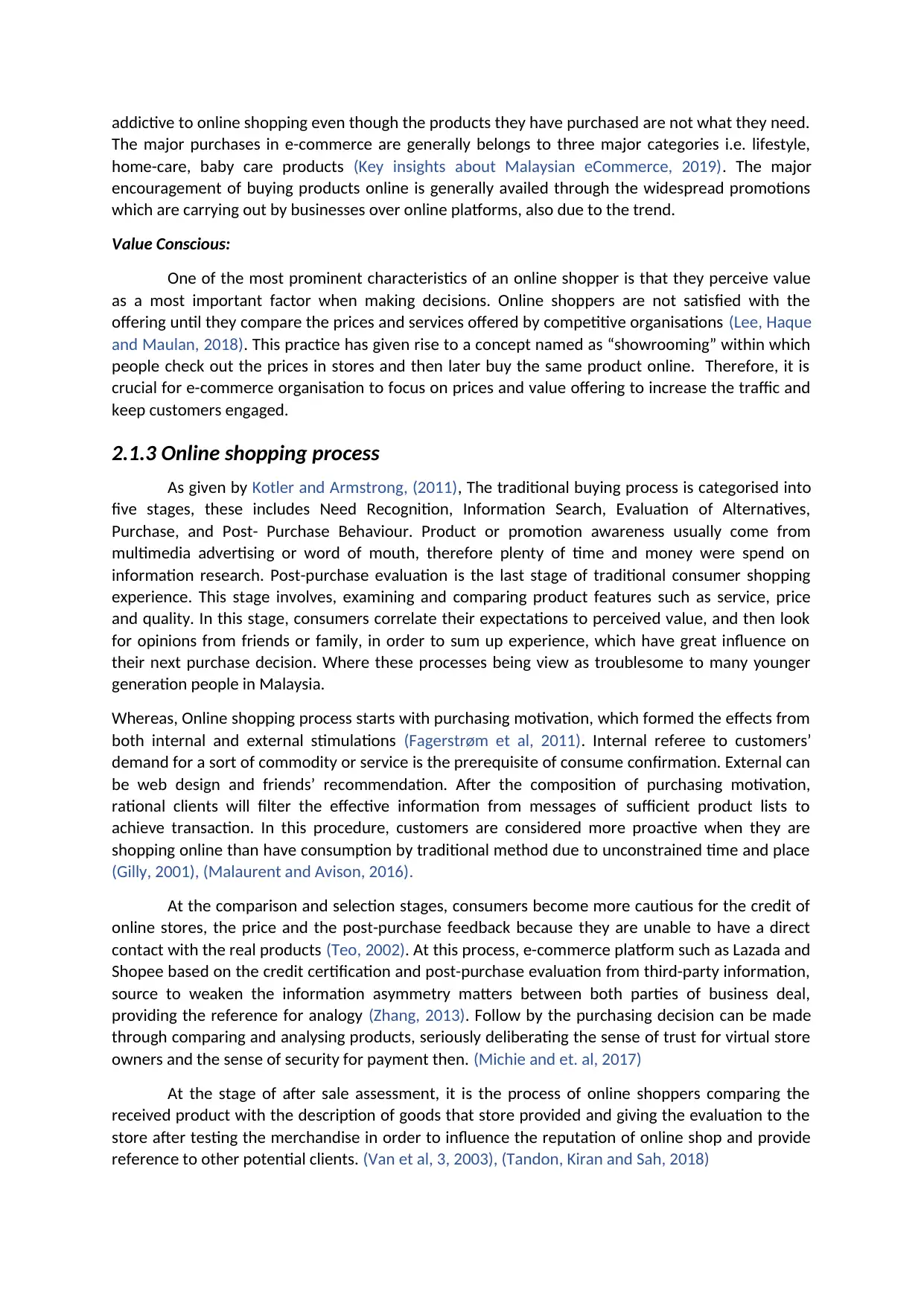
addictive to online shopping even though the products they have purchased are not what they need.
The major purchases in e-commerce are generally belongs to three major categories i.e. lifestyle,
home-care, baby care products (Key insights about Malaysian eCommerce, 2019). The major
encouragement of buying products online is generally availed through the widespread promotions
which are carrying out by businesses over online platforms, also due to the trend.
Value Conscious:
One of the most prominent characteristics of an online shopper is that they perceive value
as a most important factor when making decisions. Online shoppers are not satisfied with the
offering until they compare the prices and services offered by competitive organisations (Lee, Haque
and Maulan, 2018). This practice has given rise to a concept named as “showrooming” within which
people check out the prices in stores and then later buy the same product online. Therefore, it is
crucial for e-commerce organisation to focus on prices and value offering to increase the traffic and
keep customers engaged.
2.1.3 Online shopping process
As given by Kotler and Armstrong, (2011), The traditional buying process is categorised into
five stages, these includes Need Recognition, Information Search, Evaluation of Alternatives,
Purchase, and Post- Purchase Behaviour. Product or promotion awareness usually come from
multimedia advertising or word of mouth, therefore plenty of time and money were spend on
information research. Post-purchase evaluation is the last stage of traditional consumer shopping
experience. This stage involves, examining and comparing product features such as service, price
and quality. In this stage, consumers correlate their expectations to perceived value, and then look
for opinions from friends or family, in order to sum up experience, which have great influence on
their next purchase decision. Where these processes being view as troublesome to many younger
generation people in Malaysia.
Whereas, Online shopping process starts with purchasing motivation, which formed the effects from
both internal and external stimulations (Fagerstrøm et al, 2011). Internal referee to customers’
demand for a sort of commodity or service is the prerequisite of consume confirmation. External can
be web design and friends’ recommendation. After the composition of purchasing motivation,
rational clients will filter the effective information from messages of sufficient product lists to
achieve transaction. In this procedure, customers are considered more proactive when they are
shopping online than have consumption by traditional method due to unconstrained time and place
(Gilly, 2001), (Malaurent and Avison, 2016).
At the comparison and selection stages, consumers become more cautious for the credit of
online stores, the price and the post-purchase feedback because they are unable to have a direct
contact with the real products (Teo, 2002). At this process, e-commerce platform such as Lazada and
Shopee based on the credit certification and post-purchase evaluation from third-party information,
source to weaken the information asymmetry matters between both parties of business deal,
providing the reference for analogy (Zhang, 2013). Follow by the purchasing decision can be made
through comparing and analysing products, seriously deliberating the sense of trust for virtual store
owners and the sense of security for payment then. (Michie and et. al, 2017)
At the stage of after sale assessment, it is the process of online shoppers comparing the
received product with the description of goods that store provided and giving the evaluation to the
store after testing the merchandise in order to influence the reputation of online shop and provide
reference to other potential clients. (Van et al, 3, 2003), (Tandon, Kiran and Sah, 2018)
The major purchases in e-commerce are generally belongs to three major categories i.e. lifestyle,
home-care, baby care products (Key insights about Malaysian eCommerce, 2019). The major
encouragement of buying products online is generally availed through the widespread promotions
which are carrying out by businesses over online platforms, also due to the trend.
Value Conscious:
One of the most prominent characteristics of an online shopper is that they perceive value
as a most important factor when making decisions. Online shoppers are not satisfied with the
offering until they compare the prices and services offered by competitive organisations (Lee, Haque
and Maulan, 2018). This practice has given rise to a concept named as “showrooming” within which
people check out the prices in stores and then later buy the same product online. Therefore, it is
crucial for e-commerce organisation to focus on prices and value offering to increase the traffic and
keep customers engaged.
2.1.3 Online shopping process
As given by Kotler and Armstrong, (2011), The traditional buying process is categorised into
five stages, these includes Need Recognition, Information Search, Evaluation of Alternatives,
Purchase, and Post- Purchase Behaviour. Product or promotion awareness usually come from
multimedia advertising or word of mouth, therefore plenty of time and money were spend on
information research. Post-purchase evaluation is the last stage of traditional consumer shopping
experience. This stage involves, examining and comparing product features such as service, price
and quality. In this stage, consumers correlate their expectations to perceived value, and then look
for opinions from friends or family, in order to sum up experience, which have great influence on
their next purchase decision. Where these processes being view as troublesome to many younger
generation people in Malaysia.
Whereas, Online shopping process starts with purchasing motivation, which formed the effects from
both internal and external stimulations (Fagerstrøm et al, 2011). Internal referee to customers’
demand for a sort of commodity or service is the prerequisite of consume confirmation. External can
be web design and friends’ recommendation. After the composition of purchasing motivation,
rational clients will filter the effective information from messages of sufficient product lists to
achieve transaction. In this procedure, customers are considered more proactive when they are
shopping online than have consumption by traditional method due to unconstrained time and place
(Gilly, 2001), (Malaurent and Avison, 2016).
At the comparison and selection stages, consumers become more cautious for the credit of
online stores, the price and the post-purchase feedback because they are unable to have a direct
contact with the real products (Teo, 2002). At this process, e-commerce platform such as Lazada and
Shopee based on the credit certification and post-purchase evaluation from third-party information,
source to weaken the information asymmetry matters between both parties of business deal,
providing the reference for analogy (Zhang, 2013). Follow by the purchasing decision can be made
through comparing and analysing products, seriously deliberating the sense of trust for virtual store
owners and the sense of security for payment then. (Michie and et. al, 2017)
At the stage of after sale assessment, it is the process of online shoppers comparing the
received product with the description of goods that store provided and giving the evaluation to the
store after testing the merchandise in order to influence the reputation of online shop and provide
reference to other potential clients. (Van et al, 3, 2003), (Tandon, Kiran and Sah, 2018)
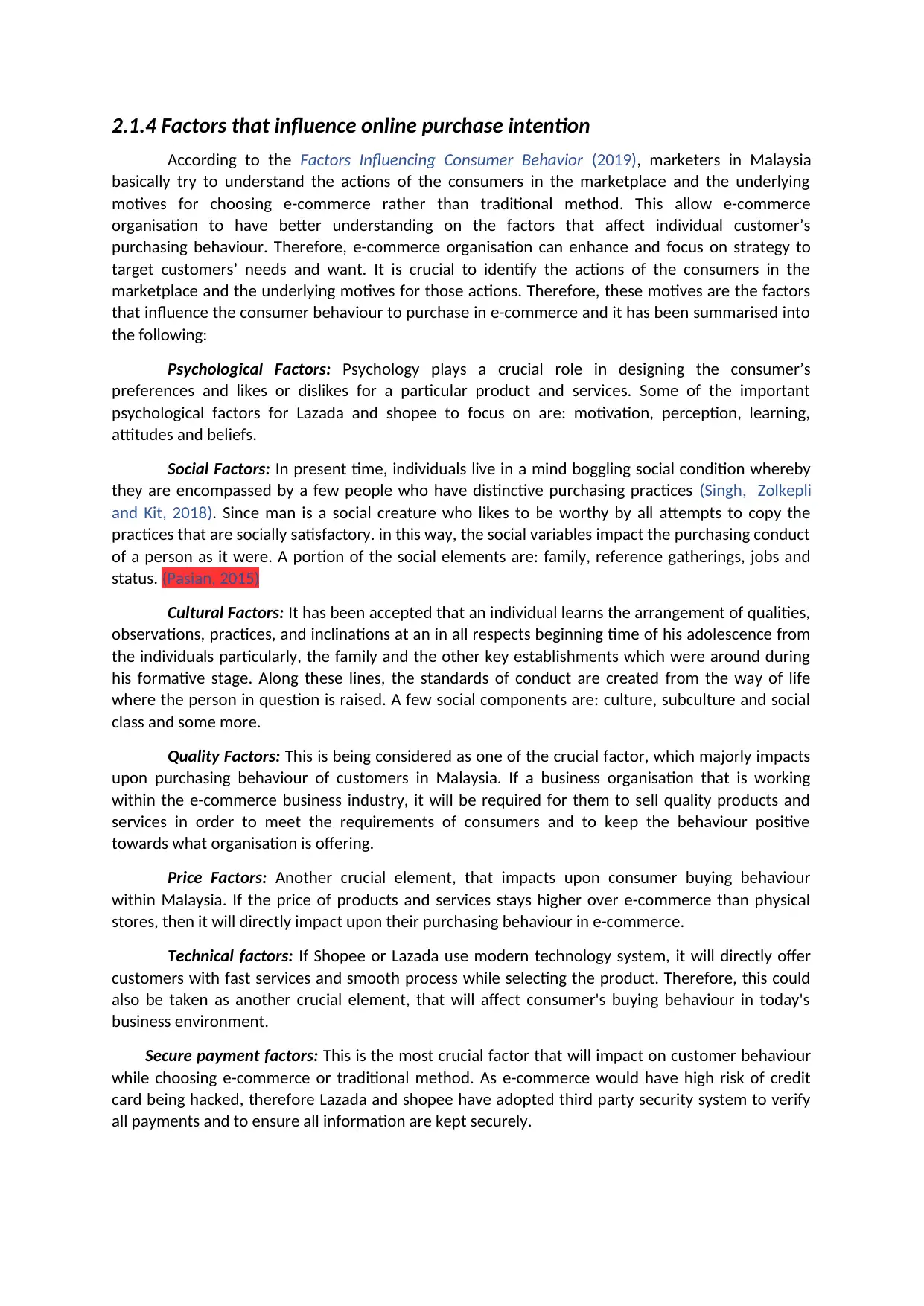
2.1.4 Factors that influence online purchase intention
According to the Factors Influencing Consumer Behavior (2019), marketers in Malaysia
basically try to understand the actions of the consumers in the marketplace and the underlying
motives for choosing e-commerce rather than traditional method. This allow e-commerce
organisation to have better understanding on the factors that affect individual customer’s
purchasing behaviour. Therefore, e-commerce organisation can enhance and focus on strategy to
target customers’ needs and want. It is crucial to identify the actions of the consumers in the
marketplace and the underlying motives for those actions. Therefore, these motives are the factors
that influence the consumer behaviour to purchase in e-commerce and it has been summarised into
the following:
Psychological Factors: Psychology plays a crucial role in designing the consumer’s
preferences and likes or dislikes for a particular product and services. Some of the important
psychological factors for Lazada and shopee to focus on are: motivation, perception, learning,
attitudes and beliefs.
Social Factors: In present time, individuals live in a mind boggling social condition whereby
they are encompassed by a few people who have distinctive purchasing practices (Singh, Zolkepli
and Kit, 2018). Since man is a social creature who likes to be worthy by all attempts to copy the
practices that are socially satisfactory. in this way, the social variables impact the purchasing conduct
of a person as it were. A portion of the social elements are: family, reference gatherings, jobs and
status. (Pasian, 2015)
Cultural Factors: It has been accepted that an individual learns the arrangement of qualities,
observations, practices, and inclinations at an in all respects beginning time of his adolescence from
the individuals particularly, the family and the other key establishments which were around during
his formative stage. Along these lines, the standards of conduct are created from the way of life
where the person in question is raised. A few social components are: culture, subculture and social
class and some more.
Quality Factors: This is being considered as one of the crucial factor, which majorly impacts
upon purchasing behaviour of customers in Malaysia. If a business organisation that is working
within the e-commerce business industry, it will be required for them to sell quality products and
services in order to meet the requirements of consumers and to keep the behaviour positive
towards what organisation is offering.
Price Factors: Another crucial element, that impacts upon consumer buying behaviour
within Malaysia. If the price of products and services stays higher over e-commerce than physical
stores, then it will directly impact upon their purchasing behaviour in e-commerce.
Technical factors: If Shopee or Lazada use modern technology system, it will directly offer
customers with fast services and smooth process while selecting the product. Therefore, this could
also be taken as another crucial element, that will affect consumer's buying behaviour in today's
business environment.
Secure payment factors: This is the most crucial factor that will impact on customer behaviour
while choosing e-commerce or traditional method. As e-commerce would have high risk of credit
card being hacked, therefore Lazada and shopee have adopted third party security system to verify
all payments and to ensure all information are kept securely.
According to the Factors Influencing Consumer Behavior (2019), marketers in Malaysia
basically try to understand the actions of the consumers in the marketplace and the underlying
motives for choosing e-commerce rather than traditional method. This allow e-commerce
organisation to have better understanding on the factors that affect individual customer’s
purchasing behaviour. Therefore, e-commerce organisation can enhance and focus on strategy to
target customers’ needs and want. It is crucial to identify the actions of the consumers in the
marketplace and the underlying motives for those actions. Therefore, these motives are the factors
that influence the consumer behaviour to purchase in e-commerce and it has been summarised into
the following:
Psychological Factors: Psychology plays a crucial role in designing the consumer’s
preferences and likes or dislikes for a particular product and services. Some of the important
psychological factors for Lazada and shopee to focus on are: motivation, perception, learning,
attitudes and beliefs.
Social Factors: In present time, individuals live in a mind boggling social condition whereby
they are encompassed by a few people who have distinctive purchasing practices (Singh, Zolkepli
and Kit, 2018). Since man is a social creature who likes to be worthy by all attempts to copy the
practices that are socially satisfactory. in this way, the social variables impact the purchasing conduct
of a person as it were. A portion of the social elements are: family, reference gatherings, jobs and
status. (Pasian, 2015)
Cultural Factors: It has been accepted that an individual learns the arrangement of qualities,
observations, practices, and inclinations at an in all respects beginning time of his adolescence from
the individuals particularly, the family and the other key establishments which were around during
his formative stage. Along these lines, the standards of conduct are created from the way of life
where the person in question is raised. A few social components are: culture, subculture and social
class and some more.
Quality Factors: This is being considered as one of the crucial factor, which majorly impacts
upon purchasing behaviour of customers in Malaysia. If a business organisation that is working
within the e-commerce business industry, it will be required for them to sell quality products and
services in order to meet the requirements of consumers and to keep the behaviour positive
towards what organisation is offering.
Price Factors: Another crucial element, that impacts upon consumer buying behaviour
within Malaysia. If the price of products and services stays higher over e-commerce than physical
stores, then it will directly impact upon their purchasing behaviour in e-commerce.
Technical factors: If Shopee or Lazada use modern technology system, it will directly offer
customers with fast services and smooth process while selecting the product. Therefore, this could
also be taken as another crucial element, that will affect consumer's buying behaviour in today's
business environment.
Secure payment factors: This is the most crucial factor that will impact on customer behaviour
while choosing e-commerce or traditional method. As e-commerce would have high risk of credit
card being hacked, therefore Lazada and shopee have adopted third party security system to verify
all payments and to ensure all information are kept securely.
Secure Best Marks with AI Grader
Need help grading? Try our AI Grader for instant feedback on your assignments.
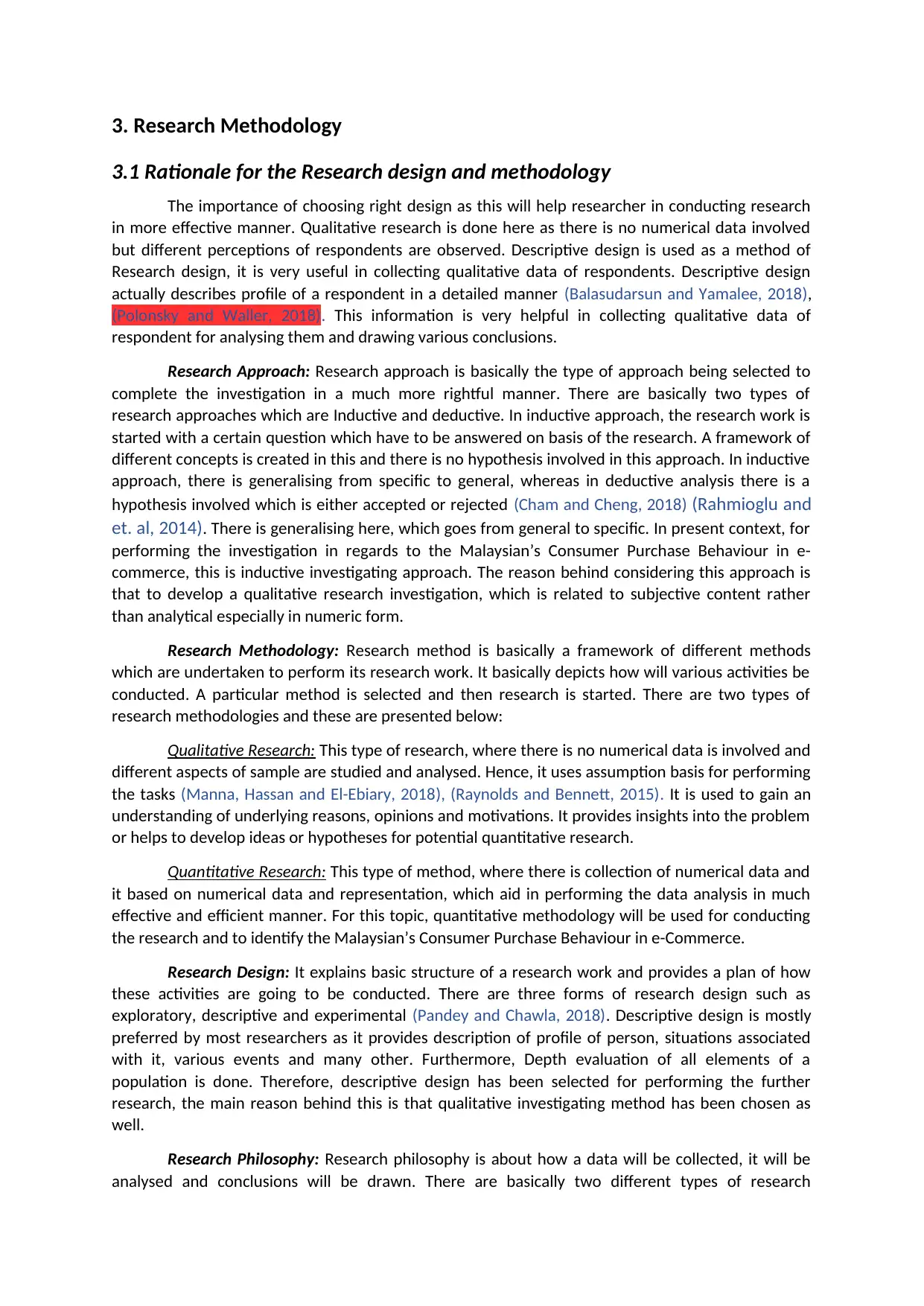
3. Research Methodology
3.1 Rationale for the Research design and methodology
The importance of choosing right design as this will help researcher in conducting research
in more effective manner. Qualitative research is done here as there is no numerical data involved
but different perceptions of respondents are observed. Descriptive design is used as a method of
Research design, it is very useful in collecting qualitative data of respondents. Descriptive design
actually describes profile of a respondent in a detailed manner (Balasudarsun and Yamalee, 2018),
(Polonsky and Waller, 2018). This information is very helpful in collecting qualitative data of
respondent for analysing them and drawing various conclusions.
Research Approach: Research approach is basically the type of approach being selected to
complete the investigation in a much more rightful manner. There are basically two types of
research approaches which are Inductive and deductive. In inductive approach, the research work is
started with a certain question which have to be answered on basis of the research. A framework of
different concepts is created in this and there is no hypothesis involved in this approach. In inductive
approach, there is generalising from specific to general, whereas in deductive analysis there is a
hypothesis involved which is either accepted or rejected (Cham and Cheng, 2018) (Rahmioglu and
et. al, 2014). There is generalising here, which goes from general to specific. In present context, for
performing the investigation in regards to the Malaysian’s Consumer Purchase Behaviour in e-
commerce, this is inductive investigating approach. The reason behind considering this approach is
that to develop a qualitative research investigation, which is related to subjective content rather
than analytical especially in numeric form.
Research Methodology: Research method is basically a framework of different methods
which are undertaken to perform its research work. It basically depicts how will various activities be
conducted. A particular method is selected and then research is started. There are two types of
research methodologies and these are presented below:
Qualitative Research: This type of research, where there is no numerical data is involved and
different aspects of sample are studied and analysed. Hence, it uses assumption basis for performing
the tasks (Manna, Hassan and El-Ebiary, 2018), (Raynolds and Bennett, 2015). It is used to gain an
understanding of underlying reasons, opinions and motivations. It provides insights into the problem
or helps to develop ideas or hypotheses for potential quantitative research.
Quantitative Research: This type of method, where there is collection of numerical data and
it based on numerical data and representation, which aid in performing the data analysis in much
effective and efficient manner. For this topic, quantitative methodology will be used for conducting
the research and to identify the Malaysian’s Consumer Purchase Behaviour in e-Commerce.
Research Design: It explains basic structure of a research work and provides a plan of how
these activities are going to be conducted. There are three forms of research design such as
exploratory, descriptive and experimental (Pandey and Chawla, 2018). Descriptive design is mostly
preferred by most researchers as it provides description of profile of person, situations associated
with it, various events and many other. Furthermore, Depth evaluation of all elements of a
population is done. Therefore, descriptive design has been selected for performing the further
research, the main reason behind this is that qualitative investigating method has been chosen as
well.
Research Philosophy: Research philosophy is about how a data will be collected, it will be
analysed and conclusions will be drawn. There are basically two different types of research
3.1 Rationale for the Research design and methodology
The importance of choosing right design as this will help researcher in conducting research
in more effective manner. Qualitative research is done here as there is no numerical data involved
but different perceptions of respondents are observed. Descriptive design is used as a method of
Research design, it is very useful in collecting qualitative data of respondents. Descriptive design
actually describes profile of a respondent in a detailed manner (Balasudarsun and Yamalee, 2018),
(Polonsky and Waller, 2018). This information is very helpful in collecting qualitative data of
respondent for analysing them and drawing various conclusions.
Research Approach: Research approach is basically the type of approach being selected to
complete the investigation in a much more rightful manner. There are basically two types of
research approaches which are Inductive and deductive. In inductive approach, the research work is
started with a certain question which have to be answered on basis of the research. A framework of
different concepts is created in this and there is no hypothesis involved in this approach. In inductive
approach, there is generalising from specific to general, whereas in deductive analysis there is a
hypothesis involved which is either accepted or rejected (Cham and Cheng, 2018) (Rahmioglu and
et. al, 2014). There is generalising here, which goes from general to specific. In present context, for
performing the investigation in regards to the Malaysian’s Consumer Purchase Behaviour in e-
commerce, this is inductive investigating approach. The reason behind considering this approach is
that to develop a qualitative research investigation, which is related to subjective content rather
than analytical especially in numeric form.
Research Methodology: Research method is basically a framework of different methods
which are undertaken to perform its research work. It basically depicts how will various activities be
conducted. A particular method is selected and then research is started. There are two types of
research methodologies and these are presented below:
Qualitative Research: This type of research, where there is no numerical data is involved and
different aspects of sample are studied and analysed. Hence, it uses assumption basis for performing
the tasks (Manna, Hassan and El-Ebiary, 2018), (Raynolds and Bennett, 2015). It is used to gain an
understanding of underlying reasons, opinions and motivations. It provides insights into the problem
or helps to develop ideas or hypotheses for potential quantitative research.
Quantitative Research: This type of method, where there is collection of numerical data and
it based on numerical data and representation, which aid in performing the data analysis in much
effective and efficient manner. For this topic, quantitative methodology will be used for conducting
the research and to identify the Malaysian’s Consumer Purchase Behaviour in e-Commerce.
Research Design: It explains basic structure of a research work and provides a plan of how
these activities are going to be conducted. There are three forms of research design such as
exploratory, descriptive and experimental (Pandey and Chawla, 2018). Descriptive design is mostly
preferred by most researchers as it provides description of profile of person, situations associated
with it, various events and many other. Furthermore, Depth evaluation of all elements of a
population is done. Therefore, descriptive design has been selected for performing the further
research, the main reason behind this is that qualitative investigating method has been chosen as
well.
Research Philosophy: Research philosophy is about how a data will be collected, it will be
analysed and conclusions will be drawn. There are basically two different types of research
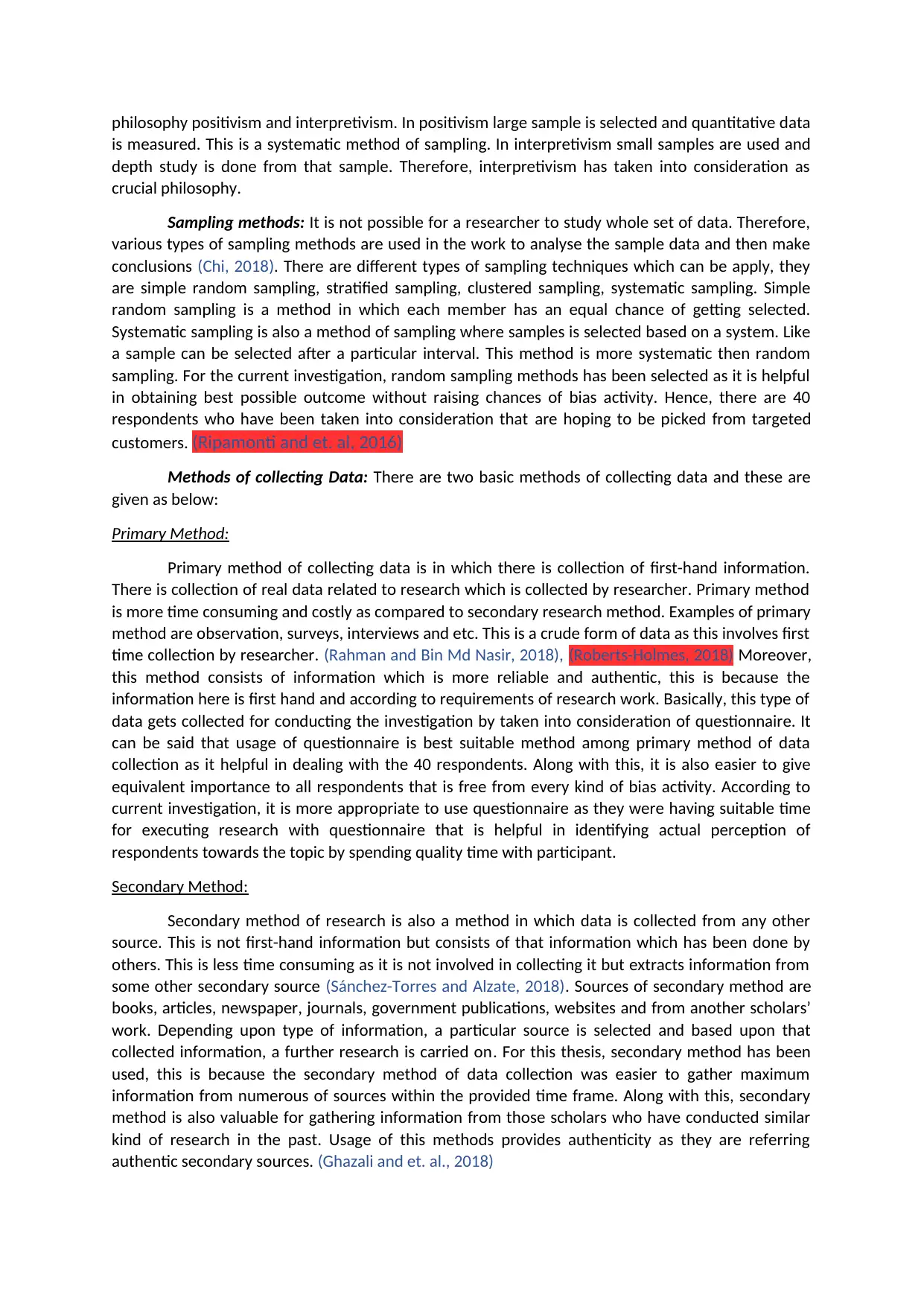
philosophy positivism and interpretivism. In positivism large sample is selected and quantitative data
is measured. This is a systematic method of sampling. In interpretivism small samples are used and
depth study is done from that sample. Therefore, interpretivism has taken into consideration as
crucial philosophy.
Sampling methods: It is not possible for a researcher to study whole set of data. Therefore,
various types of sampling methods are used in the work to analyse the sample data and then make
conclusions (Chi, 2018). There are different types of sampling techniques which can be apply, they
are simple random sampling, stratified sampling, clustered sampling, systematic sampling. Simple
random sampling is a method in which each member has an equal chance of getting selected.
Systematic sampling is also a method of sampling where samples is selected based on a system. Like
a sample can be selected after a particular interval. This method is more systematic then random
sampling. For the current investigation, random sampling methods has been selected as it is helpful
in obtaining best possible outcome without raising chances of bias activity. Hence, there are 40
respondents who have been taken into consideration that are hoping to be picked from targeted
customers. (Ripamonti and et. al, 2016)
Methods of collecting Data: There are two basic methods of collecting data and these are
given as below:
Primary Method:
Primary method of collecting data is in which there is collection of first-hand information.
There is collection of real data related to research which is collected by researcher. Primary method
is more time consuming and costly as compared to secondary research method. Examples of primary
method are observation, surveys, interviews and etc. This is a crude form of data as this involves first
time collection by researcher. (Rahman and Bin Md Nasir, 2018), (Roberts-Holmes, 2018) Moreover,
this method consists of information which is more reliable and authentic, this is because the
information here is first hand and according to requirements of research work. Basically, this type of
data gets collected for conducting the investigation by taken into consideration of questionnaire. It
can be said that usage of questionnaire is best suitable method among primary method of data
collection as it helpful in dealing with the 40 respondents. Along with this, it is also easier to give
equivalent importance to all respondents that is free from every kind of bias activity. According to
current investigation, it is more appropriate to use questionnaire as they were having suitable time
for executing research with questionnaire that is helpful in identifying actual perception of
respondents towards the topic by spending quality time with participant.
Secondary Method:
Secondary method of research is also a method in which data is collected from any other
source. This is not first-hand information but consists of that information which has been done by
others. This is less time consuming as it is not involved in collecting it but extracts information from
some other secondary source (Sánchez-Torres and Alzate, 2018). Sources of secondary method are
books, articles, newspaper, journals, government publications, websites and from another scholars’
work. Depending upon type of information, a particular source is selected and based upon that
collected information, a further research is carried on. For this thesis, secondary method has been
used, this is because the secondary method of data collection was easier to gather maximum
information from numerous of sources within the provided time frame. Along with this, secondary
method is also valuable for gathering information from those scholars who have conducted similar
kind of research in the past. Usage of this methods provides authenticity as they are referring
authentic secondary sources. (Ghazali and et. al., 2018)
is measured. This is a systematic method of sampling. In interpretivism small samples are used and
depth study is done from that sample. Therefore, interpretivism has taken into consideration as
crucial philosophy.
Sampling methods: It is not possible for a researcher to study whole set of data. Therefore,
various types of sampling methods are used in the work to analyse the sample data and then make
conclusions (Chi, 2018). There are different types of sampling techniques which can be apply, they
are simple random sampling, stratified sampling, clustered sampling, systematic sampling. Simple
random sampling is a method in which each member has an equal chance of getting selected.
Systematic sampling is also a method of sampling where samples is selected based on a system. Like
a sample can be selected after a particular interval. This method is more systematic then random
sampling. For the current investigation, random sampling methods has been selected as it is helpful
in obtaining best possible outcome without raising chances of bias activity. Hence, there are 40
respondents who have been taken into consideration that are hoping to be picked from targeted
customers. (Ripamonti and et. al, 2016)
Methods of collecting Data: There are two basic methods of collecting data and these are
given as below:
Primary Method:
Primary method of collecting data is in which there is collection of first-hand information.
There is collection of real data related to research which is collected by researcher. Primary method
is more time consuming and costly as compared to secondary research method. Examples of primary
method are observation, surveys, interviews and etc. This is a crude form of data as this involves first
time collection by researcher. (Rahman and Bin Md Nasir, 2018), (Roberts-Holmes, 2018) Moreover,
this method consists of information which is more reliable and authentic, this is because the
information here is first hand and according to requirements of research work. Basically, this type of
data gets collected for conducting the investigation by taken into consideration of questionnaire. It
can be said that usage of questionnaire is best suitable method among primary method of data
collection as it helpful in dealing with the 40 respondents. Along with this, it is also easier to give
equivalent importance to all respondents that is free from every kind of bias activity. According to
current investigation, it is more appropriate to use questionnaire as they were having suitable time
for executing research with questionnaire that is helpful in identifying actual perception of
respondents towards the topic by spending quality time with participant.
Secondary Method:
Secondary method of research is also a method in which data is collected from any other
source. This is not first-hand information but consists of that information which has been done by
others. This is less time consuming as it is not involved in collecting it but extracts information from
some other secondary source (Sánchez-Torres and Alzate, 2018). Sources of secondary method are
books, articles, newspaper, journals, government publications, websites and from another scholars’
work. Depending upon type of information, a particular source is selected and based upon that
collected information, a further research is carried on. For this thesis, secondary method has been
used, this is because the secondary method of data collection was easier to gather maximum
information from numerous of sources within the provided time frame. Along with this, secondary
method is also valuable for gathering information from those scholars who have conducted similar
kind of research in the past. Usage of this methods provides authenticity as they are referring
authentic secondary sources. (Ghazali and et. al., 2018)
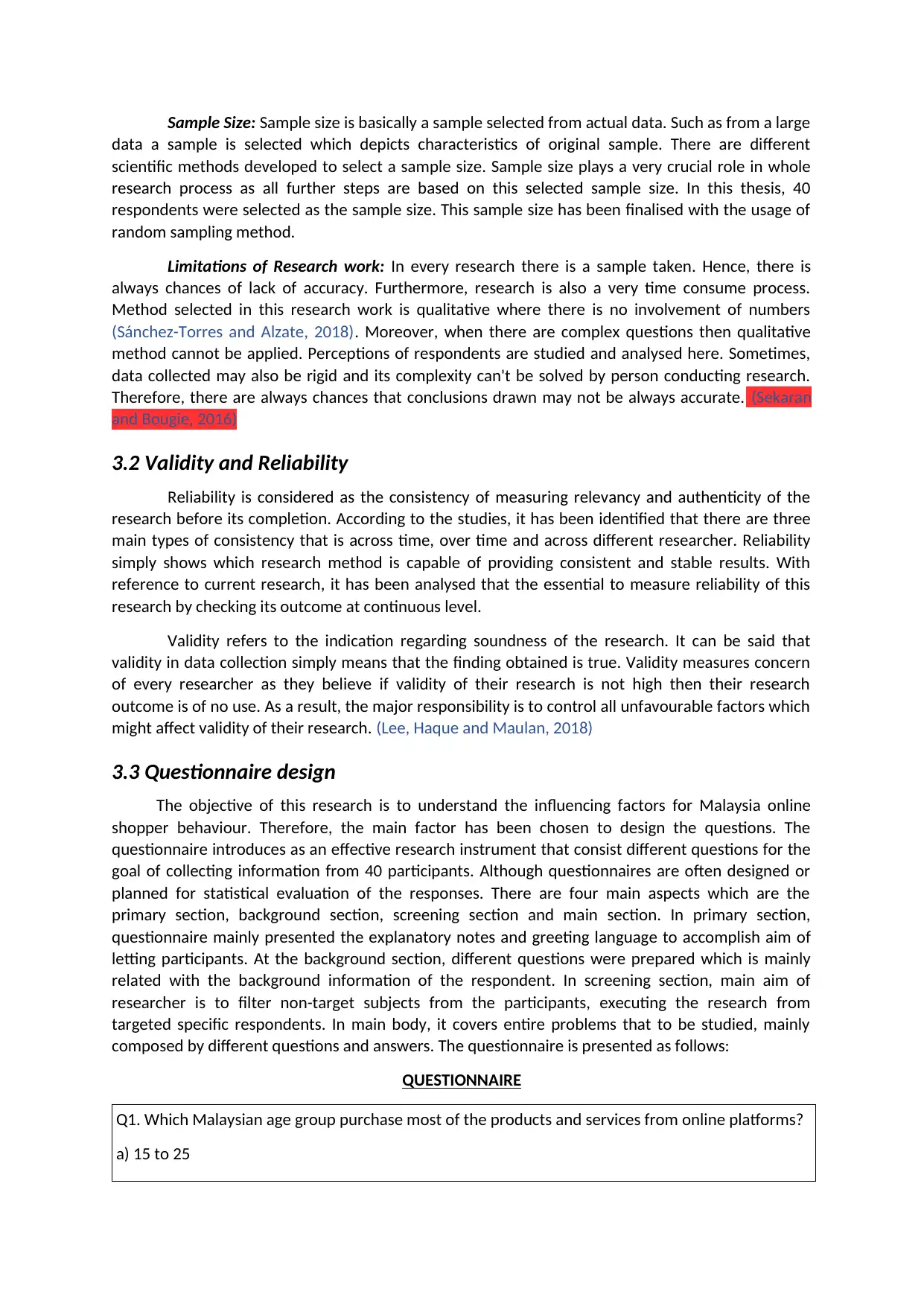
Sample Size: Sample size is basically a sample selected from actual data. Such as from a large
data a sample is selected which depicts characteristics of original sample. There are different
scientific methods developed to select a sample size. Sample size plays a very crucial role in whole
research process as all further steps are based on this selected sample size. In this thesis, 40
respondents were selected as the sample size. This sample size has been finalised with the usage of
random sampling method.
Limitations of Research work: In every research there is a sample taken. Hence, there is
always chances of lack of accuracy. Furthermore, research is also a very time consume process.
Method selected in this research work is qualitative where there is no involvement of numbers
(Sánchez-Torres and Alzate, 2018). Moreover, when there are complex questions then qualitative
method cannot be applied. Perceptions of respondents are studied and analysed here. Sometimes,
data collected may also be rigid and its complexity can't be solved by person conducting research.
Therefore, there are always chances that conclusions drawn may not be always accurate. (Sekaran
and Bougie, 2016)
3.2 Validity and Reliability
Reliability is considered as the consistency of measuring relevancy and authenticity of the
research before its completion. According to the studies, it has been identified that there are three
main types of consistency that is across time, over time and across different researcher. Reliability
simply shows which research method is capable of providing consistent and stable results. With
reference to current research, it has been analysed that the essential to measure reliability of this
research by checking its outcome at continuous level.
Validity refers to the indication regarding soundness of the research. It can be said that
validity in data collection simply means that the finding obtained is true. Validity measures concern
of every researcher as they believe if validity of their research is not high then their research
outcome is of no use. As a result, the major responsibility is to control all unfavourable factors which
might affect validity of their research. (Lee, Haque and Maulan, 2018)
3.3 Questionnaire design
The objective of this research is to understand the influencing factors for Malaysia online
shopper behaviour. Therefore, the main factor has been chosen to design the questions. The
questionnaire introduces as an effective research instrument that consist different questions for the
goal of collecting information from 40 participants. Although questionnaires are often designed or
planned for statistical evaluation of the responses. There are four main aspects which are the
primary section, background section, screening section and main section. In primary section,
questionnaire mainly presented the explanatory notes and greeting language to accomplish aim of
letting participants. At the background section, different questions were prepared which is mainly
related with the background information of the respondent. In screening section, main aim of
researcher is to filter non-target subjects from the participants, executing the research from
targeted specific respondents. In main body, it covers entire problems that to be studied, mainly
composed by different questions and answers. The questionnaire is presented as follows:
QUESTIONNAIRE
Q1. Which Malaysian age group purchase most of the products and services from online platforms?
a) 15 to 25
data a sample is selected which depicts characteristics of original sample. There are different
scientific methods developed to select a sample size. Sample size plays a very crucial role in whole
research process as all further steps are based on this selected sample size. In this thesis, 40
respondents were selected as the sample size. This sample size has been finalised with the usage of
random sampling method.
Limitations of Research work: In every research there is a sample taken. Hence, there is
always chances of lack of accuracy. Furthermore, research is also a very time consume process.
Method selected in this research work is qualitative where there is no involvement of numbers
(Sánchez-Torres and Alzate, 2018). Moreover, when there are complex questions then qualitative
method cannot be applied. Perceptions of respondents are studied and analysed here. Sometimes,
data collected may also be rigid and its complexity can't be solved by person conducting research.
Therefore, there are always chances that conclusions drawn may not be always accurate. (Sekaran
and Bougie, 2016)
3.2 Validity and Reliability
Reliability is considered as the consistency of measuring relevancy and authenticity of the
research before its completion. According to the studies, it has been identified that there are three
main types of consistency that is across time, over time and across different researcher. Reliability
simply shows which research method is capable of providing consistent and stable results. With
reference to current research, it has been analysed that the essential to measure reliability of this
research by checking its outcome at continuous level.
Validity refers to the indication regarding soundness of the research. It can be said that
validity in data collection simply means that the finding obtained is true. Validity measures concern
of every researcher as they believe if validity of their research is not high then their research
outcome is of no use. As a result, the major responsibility is to control all unfavourable factors which
might affect validity of their research. (Lee, Haque and Maulan, 2018)
3.3 Questionnaire design
The objective of this research is to understand the influencing factors for Malaysia online
shopper behaviour. Therefore, the main factor has been chosen to design the questions. The
questionnaire introduces as an effective research instrument that consist different questions for the
goal of collecting information from 40 participants. Although questionnaires are often designed or
planned for statistical evaluation of the responses. There are four main aspects which are the
primary section, background section, screening section and main section. In primary section,
questionnaire mainly presented the explanatory notes and greeting language to accomplish aim of
letting participants. At the background section, different questions were prepared which is mainly
related with the background information of the respondent. In screening section, main aim of
researcher is to filter non-target subjects from the participants, executing the research from
targeted specific respondents. In main body, it covers entire problems that to be studied, mainly
composed by different questions and answers. The questionnaire is presented as follows:
QUESTIONNAIRE
Q1. Which Malaysian age group purchase most of the products and services from online platforms?
a) 15 to 25
Paraphrase This Document
Need a fresh take? Get an instant paraphrase of this document with our AI Paraphraser
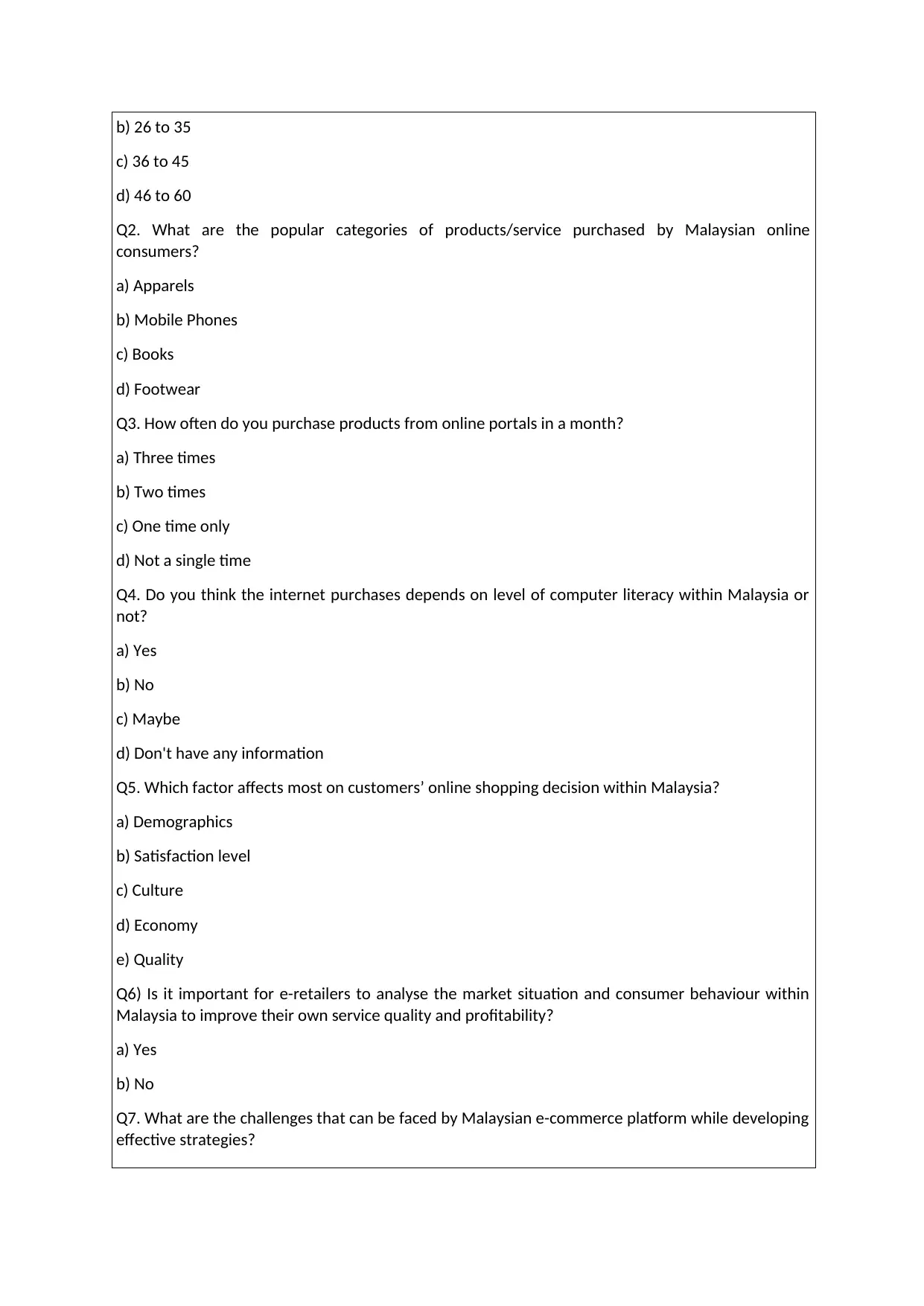
b) 26 to 35
c) 36 to 45
d) 46 to 60
Q2. What are the popular categories of products/service purchased by Malaysian online
consumers?
a) Apparels
b) Mobile Phones
c) Books
d) Footwear
Q3. How often do you purchase products from online portals in a month?
a) Three times
b) Two times
c) One time only
d) Not a single time
Q4. Do you think the internet purchases depends on level of computer literacy within Malaysia or
not?
a) Yes
b) No
c) Maybe
d) Don't have any information
Q5. Which factor affects most on customers’ online shopping decision within Malaysia?
a) Demographics
b) Satisfaction level
c) Culture
d) Economy
e) Quality
Q6) Is it important for e-retailers to analyse the market situation and consumer behaviour within
Malaysia to improve their own service quality and profitability?
a) Yes
b) No
Q7. What are the challenges that can be faced by Malaysian e-commerce platform while developing
effective strategies?
c) 36 to 45
d) 46 to 60
Q2. What are the popular categories of products/service purchased by Malaysian online
consumers?
a) Apparels
b) Mobile Phones
c) Books
d) Footwear
Q3. How often do you purchase products from online portals in a month?
a) Three times
b) Two times
c) One time only
d) Not a single time
Q4. Do you think the internet purchases depends on level of computer literacy within Malaysia or
not?
a) Yes
b) No
c) Maybe
d) Don't have any information
Q5. Which factor affects most on customers’ online shopping decision within Malaysia?
a) Demographics
b) Satisfaction level
c) Culture
d) Economy
e) Quality
Q6) Is it important for e-retailers to analyse the market situation and consumer behaviour within
Malaysia to improve their own service quality and profitability?
a) Yes
b) No
Q7. What are the challenges that can be faced by Malaysian e-commerce platform while developing
effective strategies?

a) Lack of resources
b) Ineffective training
c) Lack of communication
d) Dispersed workforce
Q8. Do you think online purchasing intentions of consumers can be change rapidly?
a) Yes
b) No
Q9. In the near future, do you agree if online purchasing in Malaysia will replace traditional method
of buying products or other range of services?
a) Highly Agreed
b) Agreed
b) Disagreed
c) No idea
Q10. Give recommendations, if any?
3.4 FREQUENCIES
Q1. Which Malaysian age group purchase most of the products and services
from online platforms?
Frequency
a) 15 to 25 10
b) 26 to 35 12
c) 36 to 45 10
d) 46 to 60 8
Q2. What are the popular categories of products/service purchased by
Malaysian online consumers?
Frequency
a) Apparels 15
b) Mobile Phones 10
c) Books 5
d) Footwear 10
b) Ineffective training
c) Lack of communication
d) Dispersed workforce
Q8. Do you think online purchasing intentions of consumers can be change rapidly?
a) Yes
b) No
Q9. In the near future, do you agree if online purchasing in Malaysia will replace traditional method
of buying products or other range of services?
a) Highly Agreed
b) Agreed
b) Disagreed
c) No idea
Q10. Give recommendations, if any?
3.4 FREQUENCIES
Q1. Which Malaysian age group purchase most of the products and services
from online platforms?
Frequency
a) 15 to 25 10
b) 26 to 35 12
c) 36 to 45 10
d) 46 to 60 8
Q2. What are the popular categories of products/service purchased by
Malaysian online consumers?
Frequency
a) Apparels 15
b) Mobile Phones 10
c) Books 5
d) Footwear 10
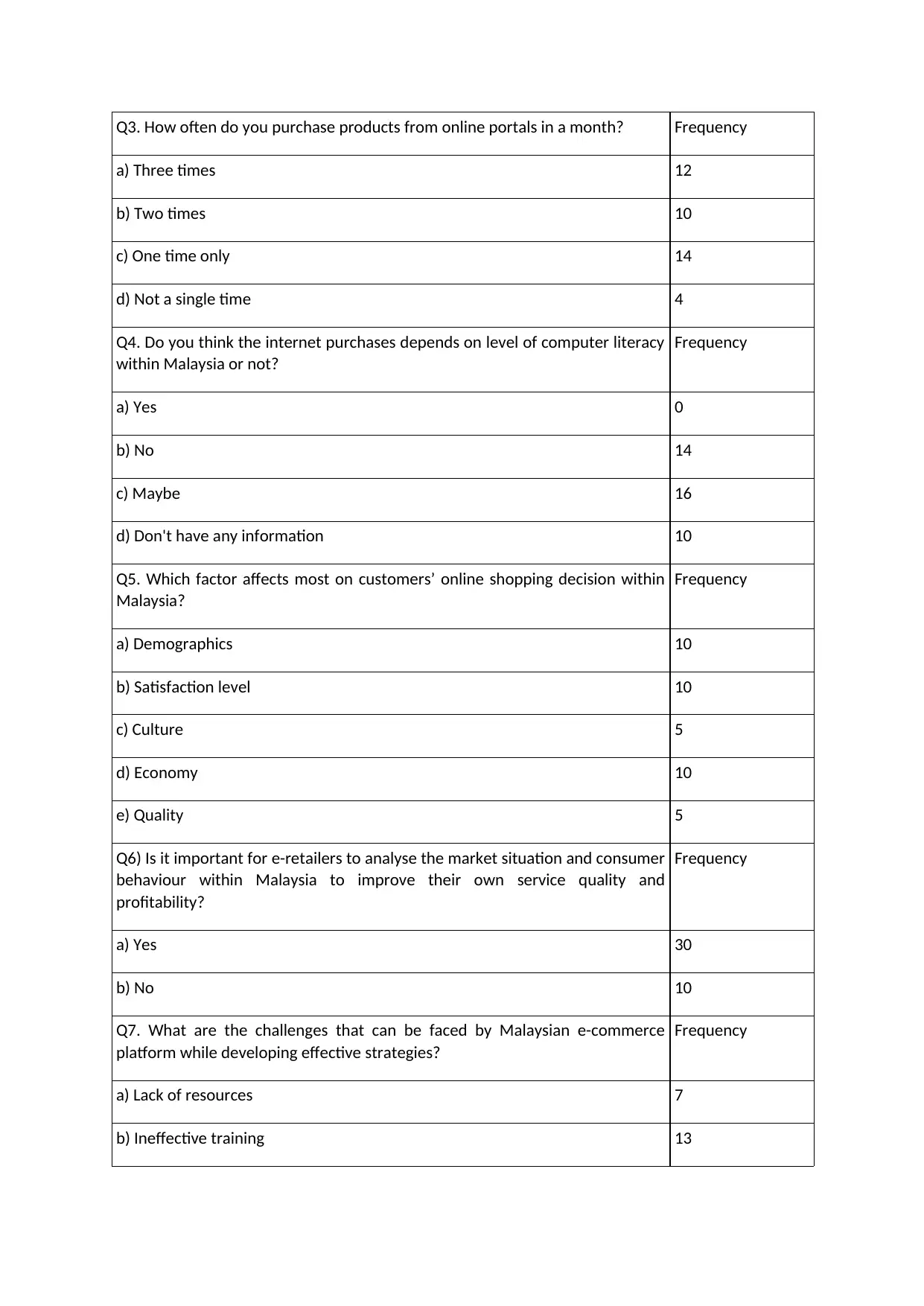
Q3. How often do you purchase products from online portals in a month? Frequency
a) Three times 12
b) Two times 10
c) One time only 14
d) Not a single time 4
Q4. Do you think the internet purchases depends on level of computer literacy
within Malaysia or not?
Frequency
a) Yes 0
b) No 14
c) Maybe 16
d) Don't have any information 10
Q5. Which factor affects most on customers’ online shopping decision within
Malaysia?
Frequency
a) Demographics 10
b) Satisfaction level 10
c) Culture 5
d) Economy 10
e) Quality 5
Q6) Is it important for e-retailers to analyse the market situation and consumer
behaviour within Malaysia to improve their own service quality and
profitability?
Frequency
a) Yes 30
b) No 10
Q7. What are the challenges that can be faced by Malaysian e-commerce
platform while developing effective strategies?
Frequency
a) Lack of resources 7
b) Ineffective training 13
a) Three times 12
b) Two times 10
c) One time only 14
d) Not a single time 4
Q4. Do you think the internet purchases depends on level of computer literacy
within Malaysia or not?
Frequency
a) Yes 0
b) No 14
c) Maybe 16
d) Don't have any information 10
Q5. Which factor affects most on customers’ online shopping decision within
Malaysia?
Frequency
a) Demographics 10
b) Satisfaction level 10
c) Culture 5
d) Economy 10
e) Quality 5
Q6) Is it important for e-retailers to analyse the market situation and consumer
behaviour within Malaysia to improve their own service quality and
profitability?
Frequency
a) Yes 30
b) No 10
Q7. What are the challenges that can be faced by Malaysian e-commerce
platform while developing effective strategies?
Frequency
a) Lack of resources 7
b) Ineffective training 13
Secure Best Marks with AI Grader
Need help grading? Try our AI Grader for instant feedback on your assignments.
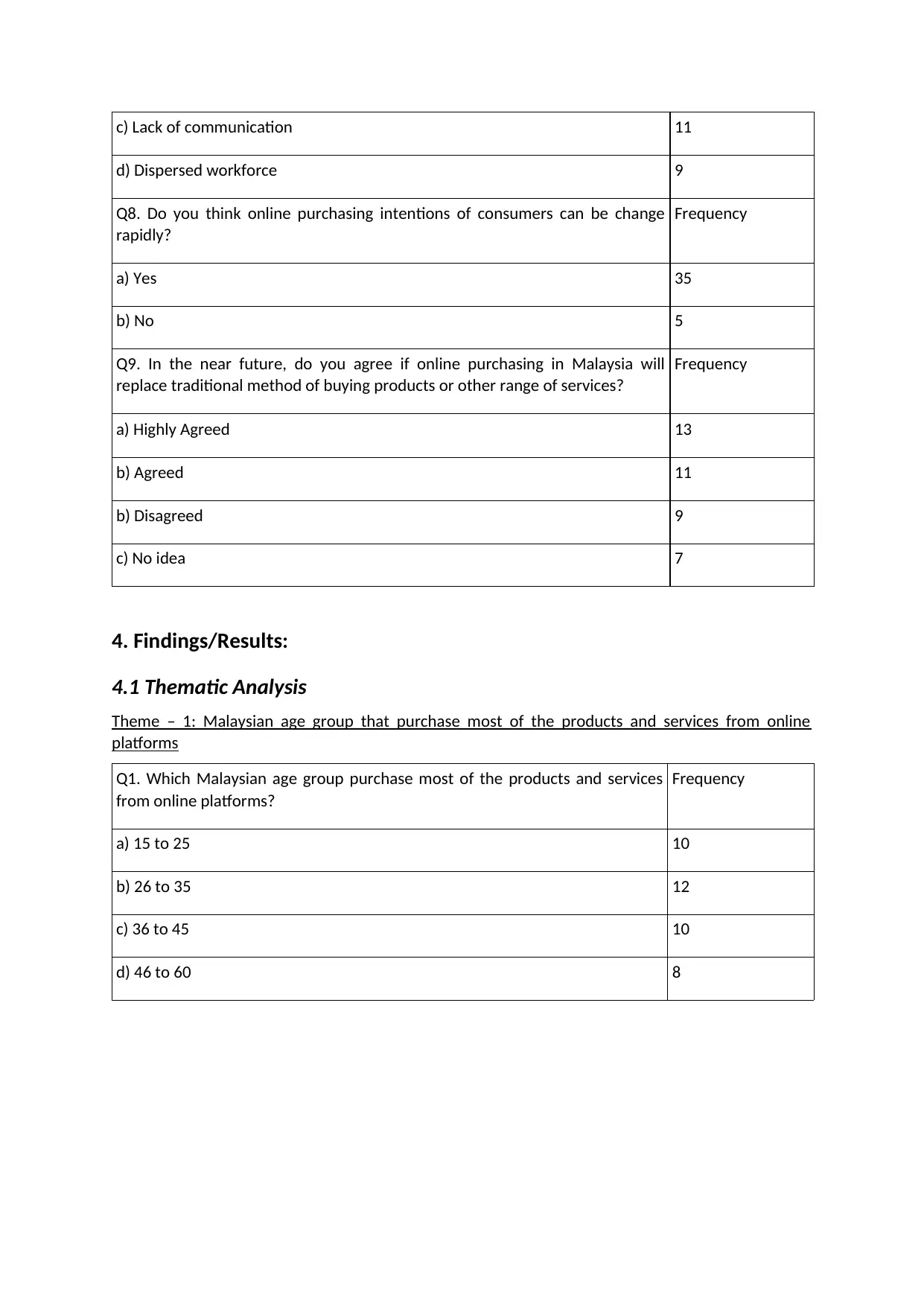
c) Lack of communication 11
d) Dispersed workforce 9
Q8. Do you think online purchasing intentions of consumers can be change
rapidly?
Frequency
a) Yes 35
b) No 5
Q9. In the near future, do you agree if online purchasing in Malaysia will
replace traditional method of buying products or other range of services?
Frequency
a) Highly Agreed 13
b) Agreed 11
b) Disagreed 9
c) No idea 7
4. Findings/Results:
4.1 Thematic Analysis
Theme – 1: Malaysian age group that purchase most of the products and services from online
platforms
Q1. Which Malaysian age group purchase most of the products and services
from online platforms?
Frequency
a) 15 to 25 10
b) 26 to 35 12
c) 36 to 45 10
d) 46 to 60 8
d) Dispersed workforce 9
Q8. Do you think online purchasing intentions of consumers can be change
rapidly?
Frequency
a) Yes 35
b) No 5
Q9. In the near future, do you agree if online purchasing in Malaysia will
replace traditional method of buying products or other range of services?
Frequency
a) Highly Agreed 13
b) Agreed 11
b) Disagreed 9
c) No idea 7
4. Findings/Results:
4.1 Thematic Analysis
Theme – 1: Malaysian age group that purchase most of the products and services from online
platforms
Q1. Which Malaysian age group purchase most of the products and services
from online platforms?
Frequency
a) 15 to 25 10
b) 26 to 35 12
c) 36 to 45 10
d) 46 to 60 8
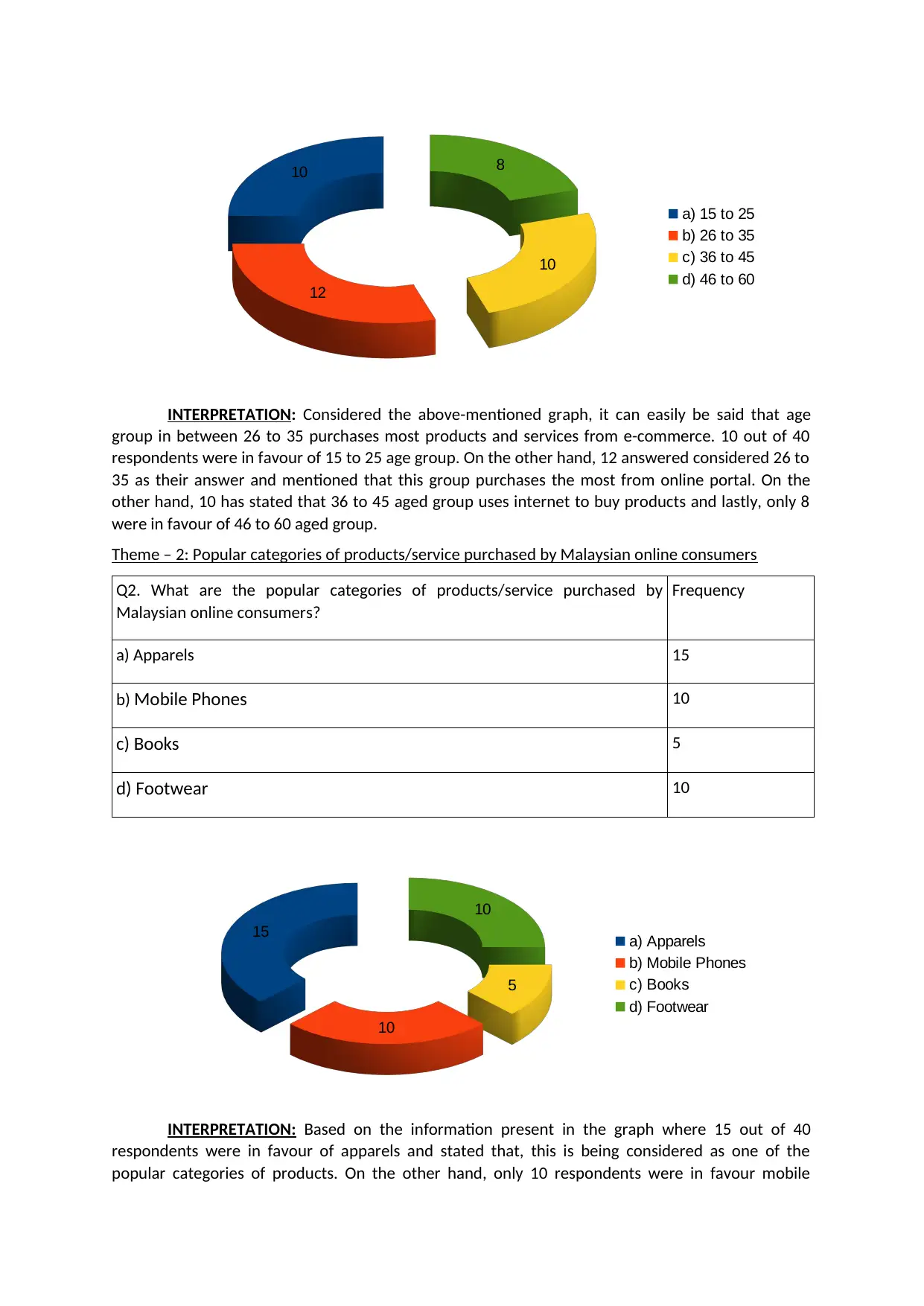
INTERPRETATION: Considered the above-mentioned graph, it can easily be said that age
group in between 26 to 35 purchases most products and services from e-commerce. 10 out of 40
respondents were in favour of 15 to 25 age group. On the other hand, 12 answered considered 26 to
35 as their answer and mentioned that this group purchases the most from online portal. On the
other hand, 10 has stated that 36 to 45 aged group uses internet to buy products and lastly, only 8
were in favour of 46 to 60 aged group.
Theme – 2: Popular categories of products/service purchased by Malaysian online consumers
Q2. What are the popular categories of products/service purchased by
Malaysian online consumers?
Frequency
a) Apparels 15
b) Mobile Phones 10
c) Books 5
d) Footwear 10
INTERPRETATION: Based on the information present in the graph where 15 out of 40
respondents were in favour of apparels and stated that, this is being considered as one of the
popular categories of products. On the other hand, only 10 respondents were in favour mobile
10
12
10
8
a) 15 to 25
b) 26 to 35
c) 36 to 45
d) 46 to 60
15
10
5
10
a) Apparels
b) Mobile Phones
c) Books
d) Footwear
group in between 26 to 35 purchases most products and services from e-commerce. 10 out of 40
respondents were in favour of 15 to 25 age group. On the other hand, 12 answered considered 26 to
35 as their answer and mentioned that this group purchases the most from online portal. On the
other hand, 10 has stated that 36 to 45 aged group uses internet to buy products and lastly, only 8
were in favour of 46 to 60 aged group.
Theme – 2: Popular categories of products/service purchased by Malaysian online consumers
Q2. What are the popular categories of products/service purchased by
Malaysian online consumers?
Frequency
a) Apparels 15
b) Mobile Phones 10
c) Books 5
d) Footwear 10
INTERPRETATION: Based on the information present in the graph where 15 out of 40
respondents were in favour of apparels and stated that, this is being considered as one of the
popular categories of products. On the other hand, only 10 respondents were in favour mobile
10
12
10
8
a) 15 to 25
b) 26 to 35
c) 36 to 45
d) 46 to 60
15
10
5
10
a) Apparels
b) Mobile Phones
c) Books
d) Footwear
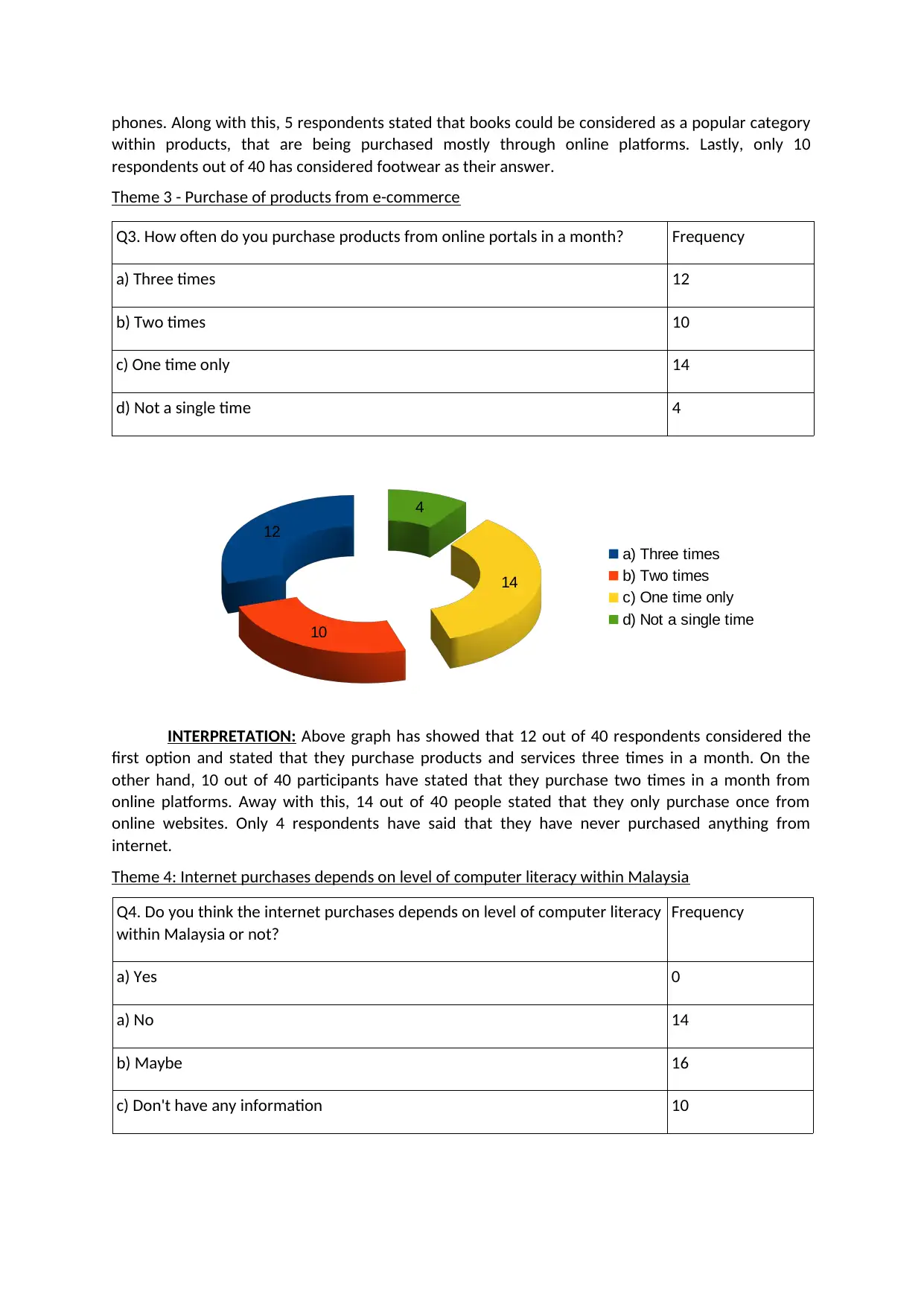
phones. Along with this, 5 respondents stated that books could be considered as a popular category
within products, that are being purchased mostly through online platforms. Lastly, only 10
respondents out of 40 has considered footwear as their answer.
Theme 3 - Purchase of products from e-commerce
Q3. How often do you purchase products from online portals in a month? Frequency
a) Three times 12
b) Two times 10
c) One time only 14
d) Not a single time 4
INTERPRETATION: Above graph has showed that 12 out of 40 respondents considered the
first option and stated that they purchase products and services three times in a month. On the
other hand, 10 out of 40 participants have stated that they purchase two times in a month from
online platforms. Away with this, 14 out of 40 people stated that they only purchase once from
online websites. Only 4 respondents have said that they have never purchased anything from
internet.
Theme 4: Internet purchases depends on level of computer literacy within Malaysia
Q4. Do you think the internet purchases depends on level of computer literacy
within Malaysia or not?
Frequency
a) Yes 0
a) No 14
b) Maybe 16
c) Don't have any information 10
12
10
14
4
a) Three times
b) Two times
c) One time only
d) Not a single time
within products, that are being purchased mostly through online platforms. Lastly, only 10
respondents out of 40 has considered footwear as their answer.
Theme 3 - Purchase of products from e-commerce
Q3. How often do you purchase products from online portals in a month? Frequency
a) Three times 12
b) Two times 10
c) One time only 14
d) Not a single time 4
INTERPRETATION: Above graph has showed that 12 out of 40 respondents considered the
first option and stated that they purchase products and services three times in a month. On the
other hand, 10 out of 40 participants have stated that they purchase two times in a month from
online platforms. Away with this, 14 out of 40 people stated that they only purchase once from
online websites. Only 4 respondents have said that they have never purchased anything from
internet.
Theme 4: Internet purchases depends on level of computer literacy within Malaysia
Q4. Do you think the internet purchases depends on level of computer literacy
within Malaysia or not?
Frequency
a) Yes 0
a) No 14
b) Maybe 16
c) Don't have any information 10
12
10
14
4
a) Three times
b) Two times
c) One time only
d) Not a single time
Paraphrase This Document
Need a fresh take? Get an instant paraphrase of this document with our AI Paraphraser

INTERPRETATION: Based on the information collected where 16 has given their answers as
May be that internet purchases basically gets affected by computer literacy within Malaysia. Rest of
14 respondent has said no that it will not affect. Lastly, 10 out of 40 respondents were in favour of
last option, and non-participants have chosen Yes.
Theme 5: Factor affects the most on customers’ online shopping decision within Malaysia
Q5. Which factor affects most on customers’ online shopping decision within
Malaysia?
Frequency
a) Demographics 10
b) Satisfaction level 10
c) Culture 5
d) Economy 10
e) Quality 5
INTERPRETATION: Focus upon the above-mentioned graph, it can easily be said that 10 out
of 40 respondents have taken demographic as their option or factor, which most affected them. On
10
10 5
10
5
a) Demographics
b) Satisfaction level
c) Culture
d) Economy
e) Quality
14
16
10
a) Yes
a) No
b) May be
c) Don't have any
information
May be that internet purchases basically gets affected by computer literacy within Malaysia. Rest of
14 respondent has said no that it will not affect. Lastly, 10 out of 40 respondents were in favour of
last option, and non-participants have chosen Yes.
Theme 5: Factor affects the most on customers’ online shopping decision within Malaysia
Q5. Which factor affects most on customers’ online shopping decision within
Malaysia?
Frequency
a) Demographics 10
b) Satisfaction level 10
c) Culture 5
d) Economy 10
e) Quality 5
INTERPRETATION: Focus upon the above-mentioned graph, it can easily be said that 10 out
of 40 respondents have taken demographic as their option or factor, which most affected them. On
10
10 5
10
5
a) Demographics
b) Satisfaction level
c) Culture
d) Economy
e) Quality
14
16
10
a) Yes
a) No
b) May be
c) Don't have any
information
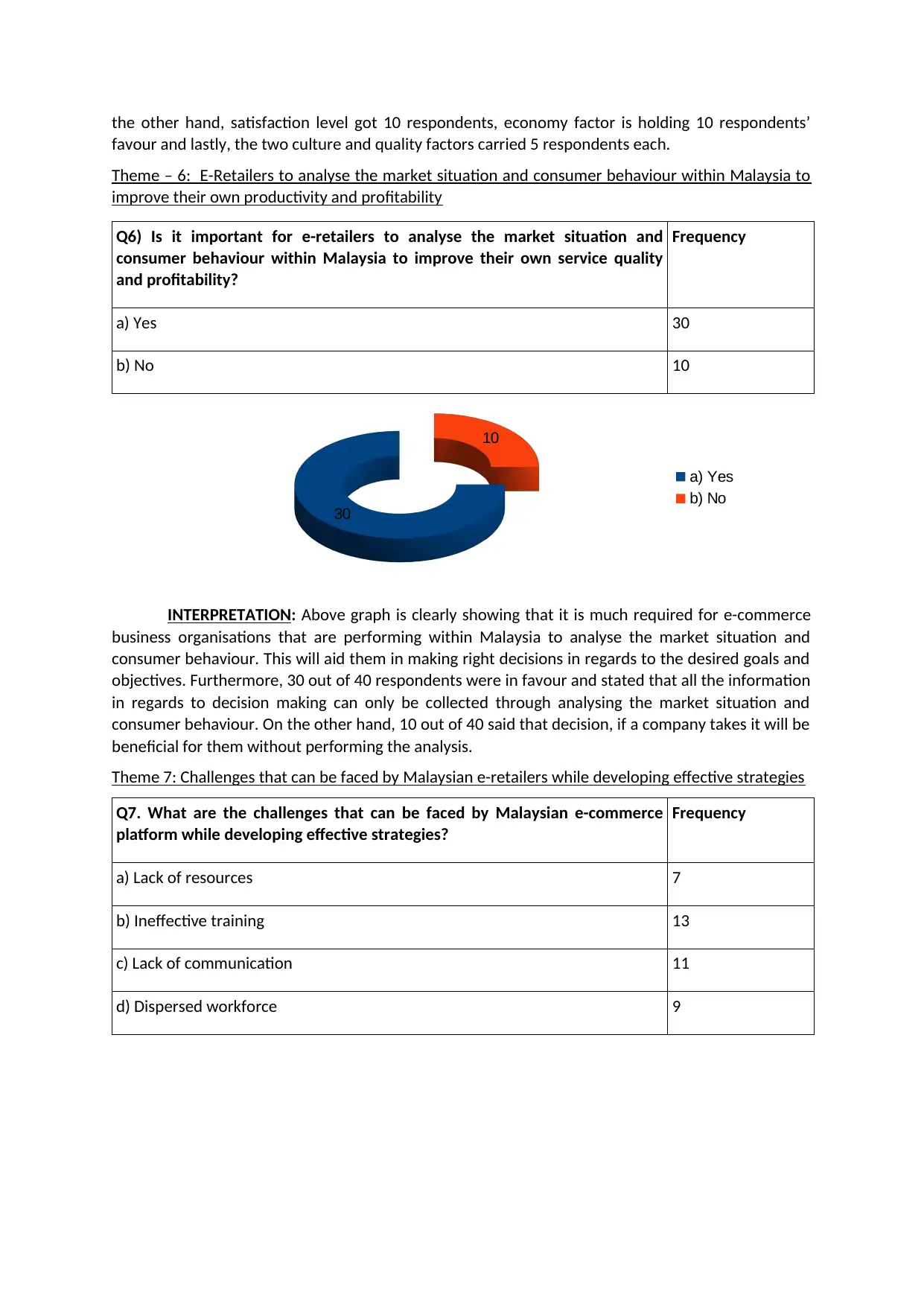
the other hand, satisfaction level got 10 respondents, economy factor is holding 10 respondents’
favour and lastly, the two culture and quality factors carried 5 respondents each.
Theme – 6: E-Retailers to analyse the market situation and consumer behaviour within Malaysia to
improve their own productivity and profitability
Q6) Is it important for e-retailers to analyse the market situation and
consumer behaviour within Malaysia to improve their own service quality
and profitability?
Frequency
a) Yes 30
b) No 10
INTERPRETATION: Above graph is clearly showing that it is much required for e-commerce
business organisations that are performing within Malaysia to analyse the market situation and
consumer behaviour. This will aid them in making right decisions in regards to the desired goals and
objectives. Furthermore, 30 out of 40 respondents were in favour and stated that all the information
in regards to decision making can only be collected through analysing the market situation and
consumer behaviour. On the other hand, 10 out of 40 said that decision, if a company takes it will be
beneficial for them without performing the analysis.
Theme 7: Challenges that can be faced by Malaysian e-retailers while developing effective strategies
Q7. What are the challenges that can be faced by Malaysian e-commerce
platform while developing effective strategies?
Frequency
a) Lack of resources 7
b) Ineffective training 13
c) Lack of communication 11
d) Dispersed workforce 9
30
10
a) Yes
b) No
favour and lastly, the two culture and quality factors carried 5 respondents each.
Theme – 6: E-Retailers to analyse the market situation and consumer behaviour within Malaysia to
improve their own productivity and profitability
Q6) Is it important for e-retailers to analyse the market situation and
consumer behaviour within Malaysia to improve their own service quality
and profitability?
Frequency
a) Yes 30
b) No 10
INTERPRETATION: Above graph is clearly showing that it is much required for e-commerce
business organisations that are performing within Malaysia to analyse the market situation and
consumer behaviour. This will aid them in making right decisions in regards to the desired goals and
objectives. Furthermore, 30 out of 40 respondents were in favour and stated that all the information
in regards to decision making can only be collected through analysing the market situation and
consumer behaviour. On the other hand, 10 out of 40 said that decision, if a company takes it will be
beneficial for them without performing the analysis.
Theme 7: Challenges that can be faced by Malaysian e-retailers while developing effective strategies
Q7. What are the challenges that can be faced by Malaysian e-commerce
platform while developing effective strategies?
Frequency
a) Lack of resources 7
b) Ineffective training 13
c) Lack of communication 11
d) Dispersed workforce 9
30
10
a) Yes
b) No
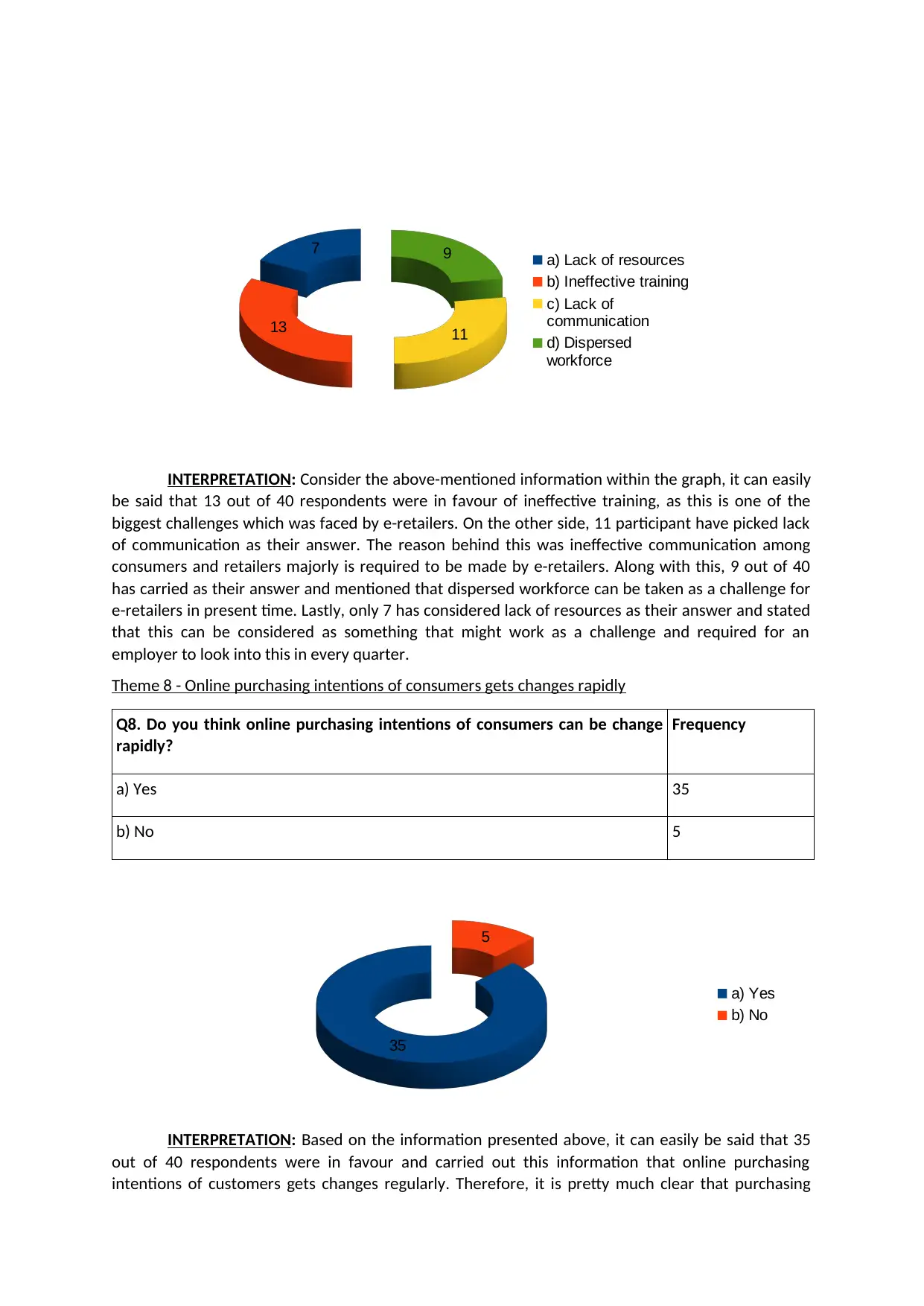
INTERPRETATION: Consider the above-mentioned information within the graph, it can easily
be said that 13 out of 40 respondents were in favour of ineffective training, as this is one of the
biggest challenges which was faced by e-retailers. On the other side, 11 participant have picked lack
of communication as their answer. The reason behind this was ineffective communication among
consumers and retailers majorly is required to be made by e-retailers. Along with this, 9 out of 40
has carried as their answer and mentioned that dispersed workforce can be taken as a challenge for
e-retailers in present time. Lastly, only 7 has considered lack of resources as their answer and stated
that this can be considered as something that might work as a challenge and required for an
employer to look into this in every quarter.
Theme 8 - Online purchasing intentions of consumers gets changes rapidly
Q8. Do you think online purchasing intentions of consumers can be change
rapidly?
Frequency
a) Yes 35
b) No 5
INTERPRETATION: Based on the information presented above, it can easily be said that 35
out of 40 respondents were in favour and carried out this information that online purchasing
intentions of customers gets changes regularly. Therefore, it is pretty much clear that purchasing
7
13 11
9 a) Lack of resources
b) Ineffective training
c) Lack of
communication
d) Dispersed
workforce
35
5
a) Yes
b) No
be said that 13 out of 40 respondents were in favour of ineffective training, as this is one of the
biggest challenges which was faced by e-retailers. On the other side, 11 participant have picked lack
of communication as their answer. The reason behind this was ineffective communication among
consumers and retailers majorly is required to be made by e-retailers. Along with this, 9 out of 40
has carried as their answer and mentioned that dispersed workforce can be taken as a challenge for
e-retailers in present time. Lastly, only 7 has considered lack of resources as their answer and stated
that this can be considered as something that might work as a challenge and required for an
employer to look into this in every quarter.
Theme 8 - Online purchasing intentions of consumers gets changes rapidly
Q8. Do you think online purchasing intentions of consumers can be change
rapidly?
Frequency
a) Yes 35
b) No 5
INTERPRETATION: Based on the information presented above, it can easily be said that 35
out of 40 respondents were in favour and carried out this information that online purchasing
intentions of customers gets changes regularly. Therefore, it is pretty much clear that purchasing
7
13 11
9 a) Lack of resources
b) Ineffective training
c) Lack of
communication
d) Dispersed
workforce
35
5
a) Yes
b) No
Secure Best Marks with AI Grader
Need help grading? Try our AI Grader for instant feedback on your assignments.
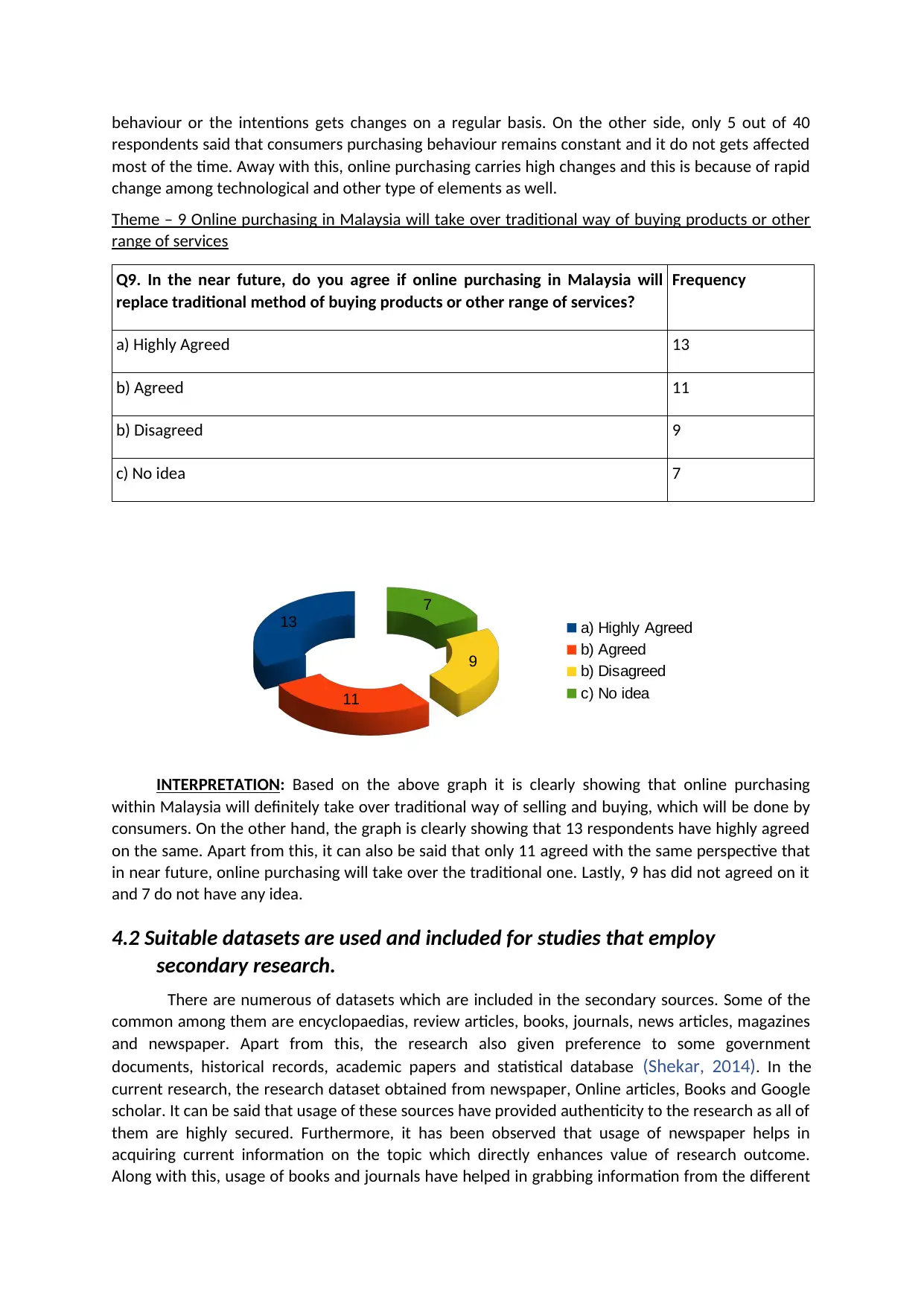
behaviour or the intentions gets changes on a regular basis. On the other side, only 5 out of 40
respondents said that consumers purchasing behaviour remains constant and it do not gets affected
most of the time. Away with this, online purchasing carries high changes and this is because of rapid
change among technological and other type of elements as well.
Theme – 9 Online purchasing in Malaysia will take over traditional way of buying products or other
range of services
Q9. In the near future, do you agree if online purchasing in Malaysia will
replace traditional method of buying products or other range of services?
Frequency
a) Highly Agreed 13
b) Agreed 11
b) Disagreed 9
c) No idea 7
INTERPRETATION: Based on the above graph it is clearly showing that online purchasing
within Malaysia will definitely take over traditional way of selling and buying, which will be done by
consumers. On the other hand, the graph is clearly showing that 13 respondents have highly agreed
on the same. Apart from this, it can also be said that only 11 agreed with the same perspective that
in near future, online purchasing will take over the traditional one. Lastly, 9 has did not agreed on it
and 7 do not have any idea.
4.2 Suitable datasets are used and included for studies that employ
secondary research.
There are numerous of datasets which are included in the secondary sources. Some of the
common among them are encyclopaedias, review articles, books, journals, news articles, magazines
and newspaper. Apart from this, the research also given preference to some government
documents, historical records, academic papers and statistical database (Shekar, 2014). In the
current research, the research dataset obtained from newspaper, Online articles, Books and Google
scholar. It can be said that usage of these sources have provided authenticity to the research as all of
them are highly secured. Furthermore, it has been observed that usage of newspaper helps in
acquiring current information on the topic which directly enhances value of research outcome.
Along with this, usage of books and journals have helped in grabbing information from the different
13
11
9
7
a) Highly Agreed
b) Agreed
b) Disagreed
c) No idea
respondents said that consumers purchasing behaviour remains constant and it do not gets affected
most of the time. Away with this, online purchasing carries high changes and this is because of rapid
change among technological and other type of elements as well.
Theme – 9 Online purchasing in Malaysia will take over traditional way of buying products or other
range of services
Q9. In the near future, do you agree if online purchasing in Malaysia will
replace traditional method of buying products or other range of services?
Frequency
a) Highly Agreed 13
b) Agreed 11
b) Disagreed 9
c) No idea 7
INTERPRETATION: Based on the above graph it is clearly showing that online purchasing
within Malaysia will definitely take over traditional way of selling and buying, which will be done by
consumers. On the other hand, the graph is clearly showing that 13 respondents have highly agreed
on the same. Apart from this, it can also be said that only 11 agreed with the same perspective that
in near future, online purchasing will take over the traditional one. Lastly, 9 has did not agreed on it
and 7 do not have any idea.
4.2 Suitable datasets are used and included for studies that employ
secondary research.
There are numerous of datasets which are included in the secondary sources. Some of the
common among them are encyclopaedias, review articles, books, journals, news articles, magazines
and newspaper. Apart from this, the research also given preference to some government
documents, historical records, academic papers and statistical database (Shekar, 2014). In the
current research, the research dataset obtained from newspaper, Online articles, Books and Google
scholar. It can be said that usage of these sources have provided authenticity to the research as all of
them are highly secured. Furthermore, it has been observed that usage of newspaper helps in
acquiring current information on the topic which directly enhances value of research outcome.
Along with this, usage of books and journals have helped in grabbing information from the different
13
11
9
7
a) Highly Agreed
b) Agreed
b) Disagreed
c) No idea
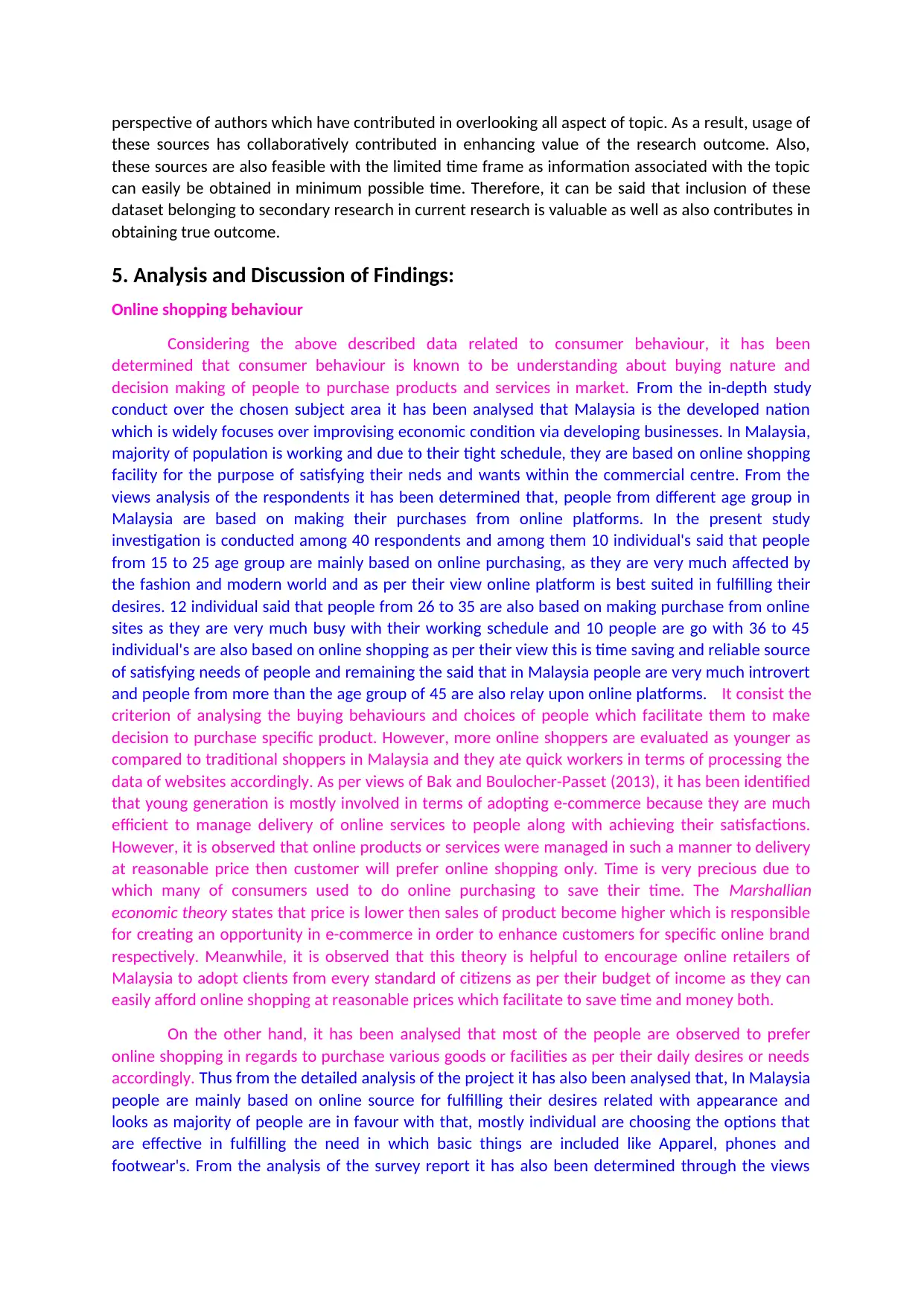
perspective of authors which have contributed in overlooking all aspect of topic. As a result, usage of
these sources has collaboratively contributed in enhancing value of the research outcome. Also,
these sources are also feasible with the limited time frame as information associated with the topic
can easily be obtained in minimum possible time. Therefore, it can be said that inclusion of these
dataset belonging to secondary research in current research is valuable as well as also contributes in
obtaining true outcome.
5. Analysis and Discussion of Findings:
Online shopping behaviour
Considering the above described data related to consumer behaviour, it has been
determined that consumer behaviour is known to be understanding about buying nature and
decision making of people to purchase products and services in market. From the in-depth study
conduct over the chosen subject area it has been analysed that Malaysia is the developed nation
which is widely focuses over improvising economic condition via developing businesses. In Malaysia,
majority of population is working and due to their tight schedule, they are based on online shopping
facility for the purpose of satisfying their neds and wants within the commercial centre. From the
views analysis of the respondents it has been determined that, people from different age group in
Malaysia are based on making their purchases from online platforms. In the present study
investigation is conducted among 40 respondents and among them 10 individual's said that people
from 15 to 25 age group are mainly based on online purchasing, as they are very much affected by
the fashion and modern world and as per their view online platform is best suited in fulfilling their
desires. 12 individual said that people from 26 to 35 are also based on making purchase from online
sites as they are very much busy with their working schedule and 10 people are go with 36 to 45
individual's are also based on online shopping as per their view this is time saving and reliable source
of satisfying needs of people and remaining the said that in Malaysia people are very much introvert
and people from more than the age group of 45 are also relay upon online platforms. It consist the
criterion of analysing the buying behaviours and choices of people which facilitate them to make
decision to purchase specific product. However, more online shoppers are evaluated as younger as
compared to traditional shoppers in Malaysia and they ate quick workers in terms of processing the
data of websites accordingly. As per views of Bak and Boulocher-Passet (2013), it has been identified
that young generation is mostly involved in terms of adopting e-commerce because they are much
efficient to manage delivery of online services to people along with achieving their satisfactions.
However, it is observed that online products or services were managed in such a manner to delivery
at reasonable price then customer will prefer online shopping only. Time is very precious due to
which many of consumers used to do online purchasing to save their time. The Marshallian
economic theory states that price is lower then sales of product become higher which is responsible
for creating an opportunity in e-commerce in order to enhance customers for specific online brand
respectively. Meanwhile, it is observed that this theory is helpful to encourage online retailers of
Malaysia to adopt clients from every standard of citizens as per their budget of income as they can
easily afford online shopping at reasonable prices which facilitate to save time and money both.
On the other hand, it has been analysed that most of the people are observed to prefer
online shopping in regards to purchase various goods or facilities as per their daily desires or needs
accordingly. Thus from the detailed analysis of the project it has also been analysed that, In Malaysia
people are mainly based on online source for fulfilling their desires related with appearance and
looks as majority of people are in favour with that, mostly individual are choosing the options that
are effective in fulfilling the need in which basic things are included like Apparel, phones and
footwear's. From the analysis of the survey report it has also been determined through the views
these sources has collaboratively contributed in enhancing value of the research outcome. Also,
these sources are also feasible with the limited time frame as information associated with the topic
can easily be obtained in minimum possible time. Therefore, it can be said that inclusion of these
dataset belonging to secondary research in current research is valuable as well as also contributes in
obtaining true outcome.
5. Analysis and Discussion of Findings:
Online shopping behaviour
Considering the above described data related to consumer behaviour, it has been
determined that consumer behaviour is known to be understanding about buying nature and
decision making of people to purchase products and services in market. From the in-depth study
conduct over the chosen subject area it has been analysed that Malaysia is the developed nation
which is widely focuses over improvising economic condition via developing businesses. In Malaysia,
majority of population is working and due to their tight schedule, they are based on online shopping
facility for the purpose of satisfying their neds and wants within the commercial centre. From the
views analysis of the respondents it has been determined that, people from different age group in
Malaysia are based on making their purchases from online platforms. In the present study
investigation is conducted among 40 respondents and among them 10 individual's said that people
from 15 to 25 age group are mainly based on online purchasing, as they are very much affected by
the fashion and modern world and as per their view online platform is best suited in fulfilling their
desires. 12 individual said that people from 26 to 35 are also based on making purchase from online
sites as they are very much busy with their working schedule and 10 people are go with 36 to 45
individual's are also based on online shopping as per their view this is time saving and reliable source
of satisfying needs of people and remaining the said that in Malaysia people are very much introvert
and people from more than the age group of 45 are also relay upon online platforms. It consist the
criterion of analysing the buying behaviours and choices of people which facilitate them to make
decision to purchase specific product. However, more online shoppers are evaluated as younger as
compared to traditional shoppers in Malaysia and they ate quick workers in terms of processing the
data of websites accordingly. As per views of Bak and Boulocher-Passet (2013), it has been identified
that young generation is mostly involved in terms of adopting e-commerce because they are much
efficient to manage delivery of online services to people along with achieving their satisfactions.
However, it is observed that online products or services were managed in such a manner to delivery
at reasonable price then customer will prefer online shopping only. Time is very precious due to
which many of consumers used to do online purchasing to save their time. The Marshallian
economic theory states that price is lower then sales of product become higher which is responsible
for creating an opportunity in e-commerce in order to enhance customers for specific online brand
respectively. Meanwhile, it is observed that this theory is helpful to encourage online retailers of
Malaysia to adopt clients from every standard of citizens as per their budget of income as they can
easily afford online shopping at reasonable prices which facilitate to save time and money both.
On the other hand, it has been analysed that most of the people are observed to prefer
online shopping in regards to purchase various goods or facilities as per their daily desires or needs
accordingly. Thus from the detailed analysis of the project it has also been analysed that, In Malaysia
people are mainly based on online source for fulfilling their desires related with appearance and
looks as majority of people are in favour with that, mostly individual are choosing the options that
are effective in fulfilling the need in which basic things are included like Apparel, phones and
footwear's. From the analysis of the survey report it has also been determined through the views
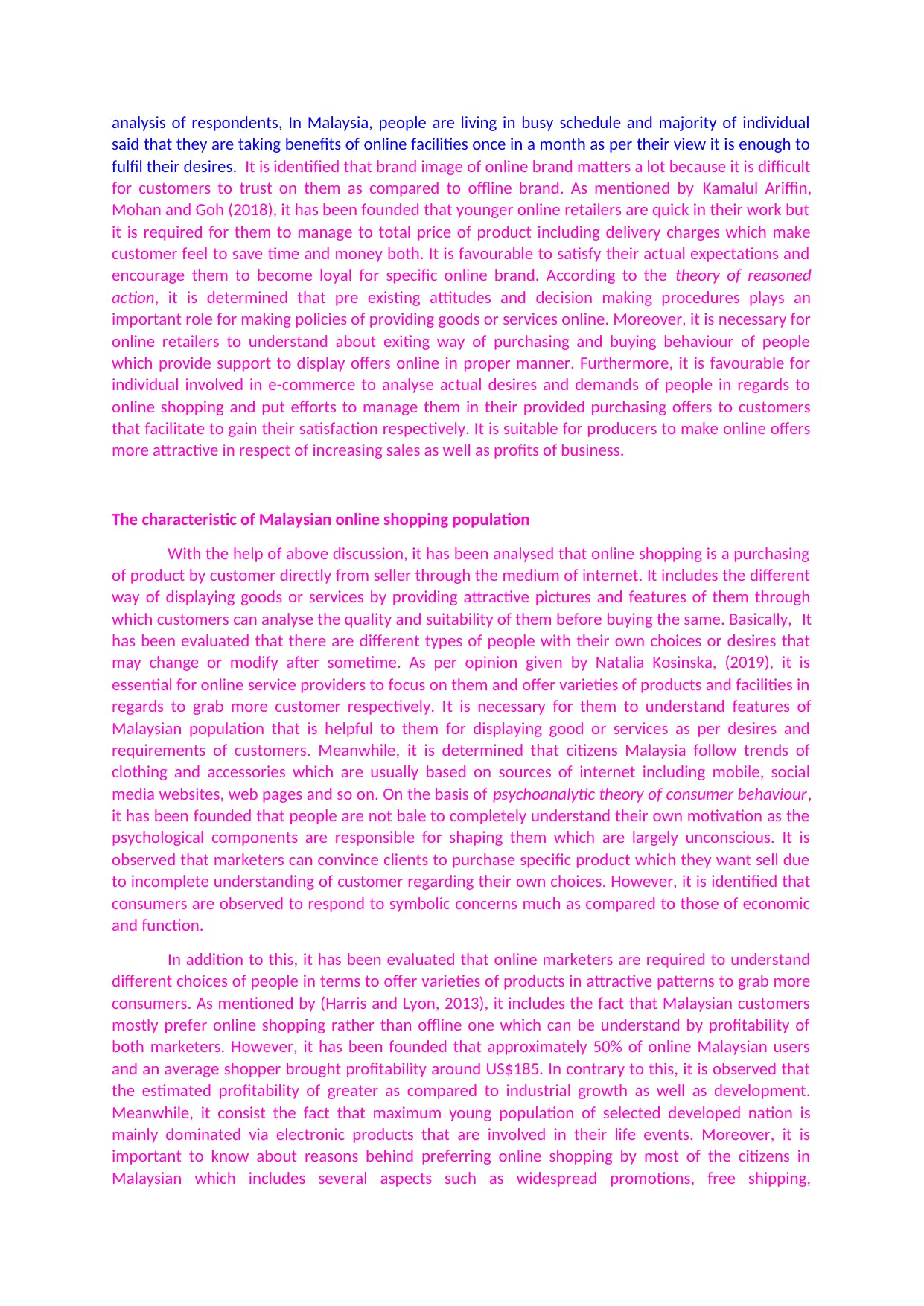
analysis of respondents, In Malaysia, people are living in busy schedule and majority of individual
said that they are taking benefits of online facilities once in a month as per their view it is enough to
fulfil their desires. It is identified that brand image of online brand matters a lot because it is difficult
for customers to trust on them as compared to offline brand. As mentioned by Kamalul Ariffin,
Mohan and Goh (2018), it has been founded that younger online retailers are quick in their work but
it is required for them to manage to total price of product including delivery charges which make
customer feel to save time and money both. It is favourable to satisfy their actual expectations and
encourage them to become loyal for specific online brand. According to the theory of reasoned
action, it is determined that pre existing attitudes and decision making procedures plays an
important role for making policies of providing goods or services online. Moreover, it is necessary for
online retailers to understand about exiting way of purchasing and buying behaviour of people
which provide support to display offers online in proper manner. Furthermore, it is favourable for
individual involved in e-commerce to analyse actual desires and demands of people in regards to
online shopping and put efforts to manage them in their provided purchasing offers to customers
that facilitate to gain their satisfaction respectively. It is suitable for producers to make online offers
more attractive in respect of increasing sales as well as profits of business.
The characteristic of Malaysian online shopping population
With the help of above discussion, it has been analysed that online shopping is a purchasing
of product by customer directly from seller through the medium of internet. It includes the different
way of displaying goods or services by providing attractive pictures and features of them through
which customers can analyse the quality and suitability of them before buying the same. Basically, It
has been evaluated that there are different types of people with their own choices or desires that
may change or modify after sometime. As per opinion given by Natalia Kosinska, (2019), it is
essential for online service providers to focus on them and offer varieties of products and facilities in
regards to grab more customer respectively. It is necessary for them to understand features of
Malaysian population that is helpful to them for displaying good or services as per desires and
requirements of customers. Meanwhile, it is determined that citizens Malaysia follow trends of
clothing and accessories which are usually based on sources of internet including mobile, social
media websites, web pages and so on. On the basis of psychoanalytic theory of consumer behaviour,
it has been founded that people are not bale to completely understand their own motivation as the
psychological components are responsible for shaping them which are largely unconscious. It is
observed that marketers can convince clients to purchase specific product which they want sell due
to incomplete understanding of customer regarding their own choices. However, it is identified that
consumers are observed to respond to symbolic concerns much as compared to those of economic
and function.
In addition to this, it has been evaluated that online marketers are required to understand
different choices of people in terms to offer varieties of products in attractive patterns to grab more
consumers. As mentioned by (Harris and Lyon, 2013), it includes the fact that Malaysian customers
mostly prefer online shopping rather than offline one which can be understand by profitability of
both marketers. However, it has been founded that approximately 50% of online Malaysian users
and an average shopper brought profitability around US$185. In contrary to this, it is observed that
the estimated profitability of greater as compared to industrial growth as well as development.
Meanwhile, it consist the fact that maximum young population of selected developed nation is
mainly dominated via electronic products that are involved in their life events. Moreover, it is
important to know about reasons behind preferring online shopping by most of the citizens in
Malaysian which includes several aspects such as widespread promotions, free shipping,
said that they are taking benefits of online facilities once in a month as per their view it is enough to
fulfil their desires. It is identified that brand image of online brand matters a lot because it is difficult
for customers to trust on them as compared to offline brand. As mentioned by Kamalul Ariffin,
Mohan and Goh (2018), it has been founded that younger online retailers are quick in their work but
it is required for them to manage to total price of product including delivery charges which make
customer feel to save time and money both. It is favourable to satisfy their actual expectations and
encourage them to become loyal for specific online brand. According to the theory of reasoned
action, it is determined that pre existing attitudes and decision making procedures plays an
important role for making policies of providing goods or services online. Moreover, it is necessary for
online retailers to understand about exiting way of purchasing and buying behaviour of people
which provide support to display offers online in proper manner. Furthermore, it is favourable for
individual involved in e-commerce to analyse actual desires and demands of people in regards to
online shopping and put efforts to manage them in their provided purchasing offers to customers
that facilitate to gain their satisfaction respectively. It is suitable for producers to make online offers
more attractive in respect of increasing sales as well as profits of business.
The characteristic of Malaysian online shopping population
With the help of above discussion, it has been analysed that online shopping is a purchasing
of product by customer directly from seller through the medium of internet. It includes the different
way of displaying goods or services by providing attractive pictures and features of them through
which customers can analyse the quality and suitability of them before buying the same. Basically, It
has been evaluated that there are different types of people with their own choices or desires that
may change or modify after sometime. As per opinion given by Natalia Kosinska, (2019), it is
essential for online service providers to focus on them and offer varieties of products and facilities in
regards to grab more customer respectively. It is necessary for them to understand features of
Malaysian population that is helpful to them for displaying good or services as per desires and
requirements of customers. Meanwhile, it is determined that citizens Malaysia follow trends of
clothing and accessories which are usually based on sources of internet including mobile, social
media websites, web pages and so on. On the basis of psychoanalytic theory of consumer behaviour,
it has been founded that people are not bale to completely understand their own motivation as the
psychological components are responsible for shaping them which are largely unconscious. It is
observed that marketers can convince clients to purchase specific product which they want sell due
to incomplete understanding of customer regarding their own choices. However, it is identified that
consumers are observed to respond to symbolic concerns much as compared to those of economic
and function.
In addition to this, it has been evaluated that online marketers are required to understand
different choices of people in terms to offer varieties of products in attractive patterns to grab more
consumers. As mentioned by (Harris and Lyon, 2013), it includes the fact that Malaysian customers
mostly prefer online shopping rather than offline one which can be understand by profitability of
both marketers. However, it has been founded that approximately 50% of online Malaysian users
and an average shopper brought profitability around US$185. In contrary to this, it is observed that
the estimated profitability of greater as compared to industrial growth as well as development.
Meanwhile, it consist the fact that maximum young population of selected developed nation is
mainly dominated via electronic products that are involved in their life events. Moreover, it is
important to know about reasons behind preferring online shopping by most of the citizens in
Malaysian which includes several aspects such as widespread promotions, free shipping,
Paraphrase This Document
Need a fresh take? Get an instant paraphrase of this document with our AI Paraphraser
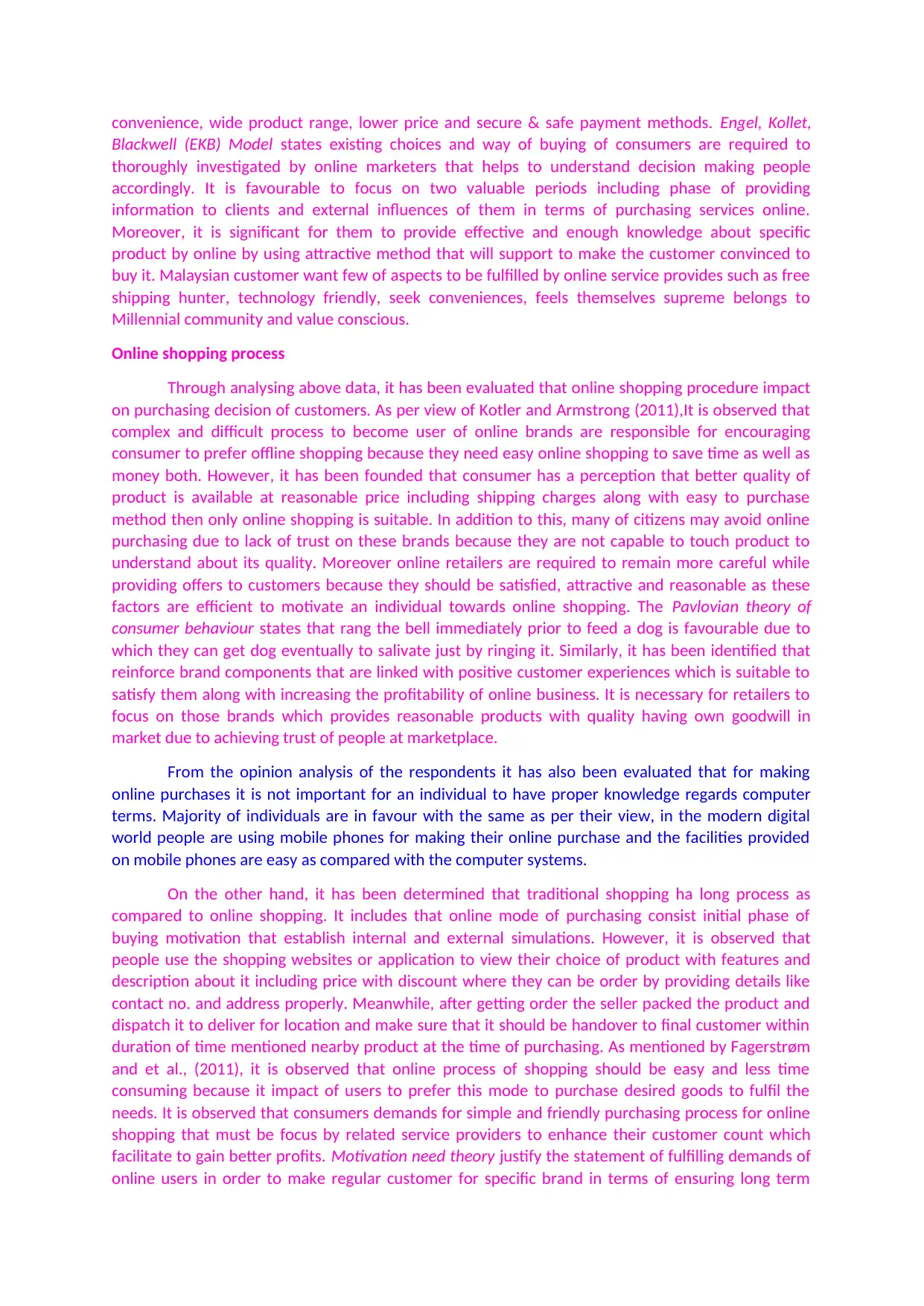
convenience, wide product range, lower price and secure & safe payment methods. Engel, Kollet,
Blackwell (EKB) Model states existing choices and way of buying of consumers are required to
thoroughly investigated by online marketers that helps to understand decision making people
accordingly. It is favourable to focus on two valuable periods including phase of providing
information to clients and external influences of them in terms of purchasing services online.
Moreover, it is significant for them to provide effective and enough knowledge about specific
product by online by using attractive method that will support to make the customer convinced to
buy it. Malaysian customer want few of aspects to be fulfilled by online service provides such as free
shipping hunter, technology friendly, seek conveniences, feels themselves supreme belongs to
Millennial community and value conscious.
Online shopping process
Through analysing above data, it has been evaluated that online shopping procedure impact
on purchasing decision of customers. As per view of Kotler and Armstrong (2011),It is observed that
complex and difficult process to become user of online brands are responsible for encouraging
consumer to prefer offline shopping because they need easy online shopping to save time as well as
money both. However, it has been founded that consumer has a perception that better quality of
product is available at reasonable price including shipping charges along with easy to purchase
method then only online shopping is suitable. In addition to this, many of citizens may avoid online
purchasing due to lack of trust on these brands because they are not capable to touch product to
understand about its quality. Moreover online retailers are required to remain more careful while
providing offers to customers because they should be satisfied, attractive and reasonable as these
factors are efficient to motivate an individual towards online shopping. The Pavlovian theory of
consumer behaviour states that rang the bell immediately prior to feed a dog is favourable due to
which they can get dog eventually to salivate just by ringing it. Similarly, it has been identified that
reinforce brand components that are linked with positive customer experiences which is suitable to
satisfy them along with increasing the profitability of online business. It is necessary for retailers to
focus on those brands which provides reasonable products with quality having own goodwill in
market due to achieving trust of people at marketplace.
From the opinion analysis of the respondents it has also been evaluated that for making
online purchases it is not important for an individual to have proper knowledge regards computer
terms. Majority of individuals are in favour with the same as per their view, in the modern digital
world people are using mobile phones for making their online purchase and the facilities provided
on mobile phones are easy as compared with the computer systems.
On the other hand, it has been determined that traditional shopping ha long process as
compared to online shopping. It includes that online mode of purchasing consist initial phase of
buying motivation that establish internal and external simulations. However, it is observed that
people use the shopping websites or application to view their choice of product with features and
description about it including price with discount where they can be order by providing details like
contact no. and address properly. Meanwhile, after getting order the seller packed the product and
dispatch it to deliver for location and make sure that it should be handover to final customer within
duration of time mentioned nearby product at the time of purchasing. As mentioned by Fagerstrøm
and et al., (2011), it is observed that online process of shopping should be easy and less time
consuming because it impact of users to prefer this mode to purchase desired goods to fulfil the
needs. It is observed that consumers demands for simple and friendly purchasing process for online
shopping that must be focus by related service providers to enhance their customer count which
facilitate to gain better profits. Motivation need theory justify the statement of fulfilling demands of
online users in order to make regular customer for specific brand in terms of ensuring long term
Blackwell (EKB) Model states existing choices and way of buying of consumers are required to
thoroughly investigated by online marketers that helps to understand decision making people
accordingly. It is favourable to focus on two valuable periods including phase of providing
information to clients and external influences of them in terms of purchasing services online.
Moreover, it is significant for them to provide effective and enough knowledge about specific
product by online by using attractive method that will support to make the customer convinced to
buy it. Malaysian customer want few of aspects to be fulfilled by online service provides such as free
shipping hunter, technology friendly, seek conveniences, feels themselves supreme belongs to
Millennial community and value conscious.
Online shopping process
Through analysing above data, it has been evaluated that online shopping procedure impact
on purchasing decision of customers. As per view of Kotler and Armstrong (2011),It is observed that
complex and difficult process to become user of online brands are responsible for encouraging
consumer to prefer offline shopping because they need easy online shopping to save time as well as
money both. However, it has been founded that consumer has a perception that better quality of
product is available at reasonable price including shipping charges along with easy to purchase
method then only online shopping is suitable. In addition to this, many of citizens may avoid online
purchasing due to lack of trust on these brands because they are not capable to touch product to
understand about its quality. Moreover online retailers are required to remain more careful while
providing offers to customers because they should be satisfied, attractive and reasonable as these
factors are efficient to motivate an individual towards online shopping. The Pavlovian theory of
consumer behaviour states that rang the bell immediately prior to feed a dog is favourable due to
which they can get dog eventually to salivate just by ringing it. Similarly, it has been identified that
reinforce brand components that are linked with positive customer experiences which is suitable to
satisfy them along with increasing the profitability of online business. It is necessary for retailers to
focus on those brands which provides reasonable products with quality having own goodwill in
market due to achieving trust of people at marketplace.
From the opinion analysis of the respondents it has also been evaluated that for making
online purchases it is not important for an individual to have proper knowledge regards computer
terms. Majority of individuals are in favour with the same as per their view, in the modern digital
world people are using mobile phones for making their online purchase and the facilities provided
on mobile phones are easy as compared with the computer systems.
On the other hand, it has been determined that traditional shopping ha long process as
compared to online shopping. It includes that online mode of purchasing consist initial phase of
buying motivation that establish internal and external simulations. However, it is observed that
people use the shopping websites or application to view their choice of product with features and
description about it including price with discount where they can be order by providing details like
contact no. and address properly. Meanwhile, after getting order the seller packed the product and
dispatch it to deliver for location and make sure that it should be handover to final customer within
duration of time mentioned nearby product at the time of purchasing. As mentioned by Fagerstrøm
and et al., (2011), it is observed that online process of shopping should be easy and less time
consuming because it impact of users to prefer this mode to purchase desired goods to fulfil the
needs. It is observed that consumers demands for simple and friendly purchasing process for online
shopping that must be focus by related service providers to enhance their customer count which
facilitate to gain better profits. Motivation need theory justify the statement of fulfilling demands of
online users in order to make regular customer for specific brand in terms of ensuring long term
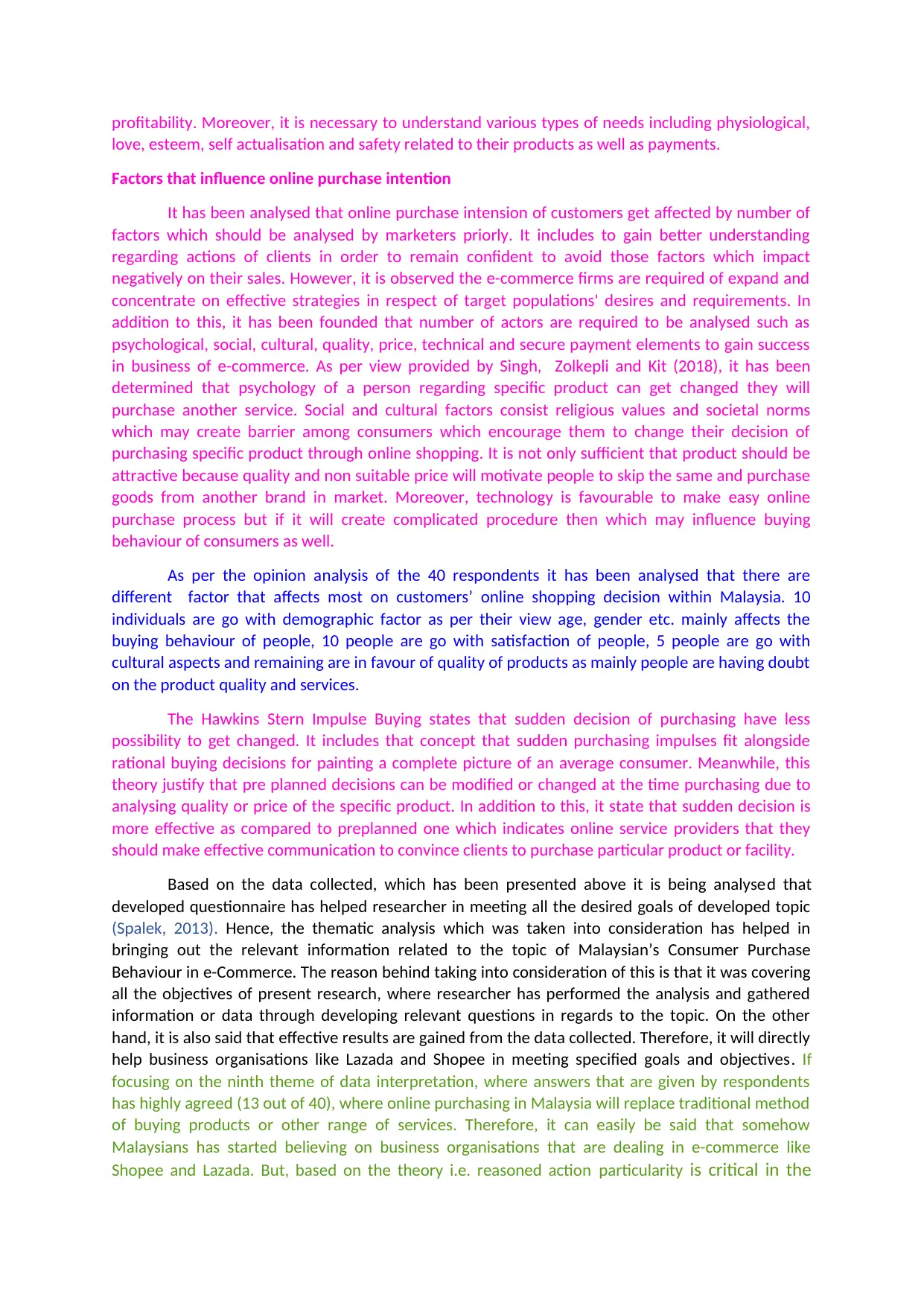
profitability. Moreover, it is necessary to understand various types of needs including physiological,
love, esteem, self actualisation and safety related to their products as well as payments.
Factors that influence online purchase intention
It has been analysed that online purchase intension of customers get affected by number of
factors which should be analysed by marketers priorly. It includes to gain better understanding
regarding actions of clients in order to remain confident to avoid those factors which impact
negatively on their sales. However, it is observed the e-commerce firms are required of expand and
concentrate on effective strategies in respect of target populations' desires and requirements. In
addition to this, it has been founded that number of actors are required to be analysed such as
psychological, social, cultural, quality, price, technical and secure payment elements to gain success
in business of e-commerce. As per view provided by Singh, Zolkepli and Kit (2018), it has been
determined that psychology of a person regarding specific product can get changed they will
purchase another service. Social and cultural factors consist religious values and societal norms
which may create barrier among consumers which encourage them to change their decision of
purchasing specific product through online shopping. It is not only sufficient that product should be
attractive because quality and non suitable price will motivate people to skip the same and purchase
goods from another brand in market. Moreover, technology is favourable to make easy online
purchase process but if it will create complicated procedure then which may influence buying
behaviour of consumers as well.
As per the opinion analysis of the 40 respondents it has been analysed that there are
different factor that affects most on customers’ online shopping decision within Malaysia. 10
individuals are go with demographic factor as per their view age, gender etc. mainly affects the
buying behaviour of people, 10 people are go with satisfaction of people, 5 people are go with
cultural aspects and remaining are in favour of quality of products as mainly people are having doubt
on the product quality and services.
The Hawkins Stern Impulse Buying states that sudden decision of purchasing have less
possibility to get changed. It includes that concept that sudden purchasing impulses fit alongside
rational buying decisions for painting a complete picture of an average consumer. Meanwhile, this
theory justify that pre planned decisions can be modified or changed at the time purchasing due to
analysing quality or price of the specific product. In addition to this, it state that sudden decision is
more effective as compared to preplanned one which indicates online service providers that they
should make effective communication to convince clients to purchase particular product or facility.
Based on the data collected, which has been presented above it is being analysed that
developed questionnaire has helped researcher in meeting all the desired goals of developed topic
(Spalek, 2013). Hence, the thematic analysis which was taken into consideration has helped in
bringing out the relevant information related to the topic of Malaysian’s Consumer Purchase
Behaviour in e-Commerce. The reason behind taking into consideration of this is that it was covering
all the objectives of present research, where researcher has performed the analysis and gathered
information or data through developing relevant questions in regards to the topic. On the other
hand, it is also said that effective results are gained from the data collected. Therefore, it will directly
help business organisations like Lazada and Shopee in meeting specified goals and objectives. If
focusing on the ninth theme of data interpretation, where answers that are given by respondents
has highly agreed (13 out of 40), where online purchasing in Malaysia will replace traditional method
of buying products or other range of services. Therefore, it can easily be said that somehow
Malaysians has started believing on business organisations that are dealing in e-commerce like
Shopee and Lazada. But, based on the theory i.e. reasoned action particularity is critical in the
love, esteem, self actualisation and safety related to their products as well as payments.
Factors that influence online purchase intention
It has been analysed that online purchase intension of customers get affected by number of
factors which should be analysed by marketers priorly. It includes to gain better understanding
regarding actions of clients in order to remain confident to avoid those factors which impact
negatively on their sales. However, it is observed the e-commerce firms are required of expand and
concentrate on effective strategies in respect of target populations' desires and requirements. In
addition to this, it has been founded that number of actors are required to be analysed such as
psychological, social, cultural, quality, price, technical and secure payment elements to gain success
in business of e-commerce. As per view provided by Singh, Zolkepli and Kit (2018), it has been
determined that psychology of a person regarding specific product can get changed they will
purchase another service. Social and cultural factors consist religious values and societal norms
which may create barrier among consumers which encourage them to change their decision of
purchasing specific product through online shopping. It is not only sufficient that product should be
attractive because quality and non suitable price will motivate people to skip the same and purchase
goods from another brand in market. Moreover, technology is favourable to make easy online
purchase process but if it will create complicated procedure then which may influence buying
behaviour of consumers as well.
As per the opinion analysis of the 40 respondents it has been analysed that there are
different factor that affects most on customers’ online shopping decision within Malaysia. 10
individuals are go with demographic factor as per their view age, gender etc. mainly affects the
buying behaviour of people, 10 people are go with satisfaction of people, 5 people are go with
cultural aspects and remaining are in favour of quality of products as mainly people are having doubt
on the product quality and services.
The Hawkins Stern Impulse Buying states that sudden decision of purchasing have less
possibility to get changed. It includes that concept that sudden purchasing impulses fit alongside
rational buying decisions for painting a complete picture of an average consumer. Meanwhile, this
theory justify that pre planned decisions can be modified or changed at the time purchasing due to
analysing quality or price of the specific product. In addition to this, it state that sudden decision is
more effective as compared to preplanned one which indicates online service providers that they
should make effective communication to convince clients to purchase particular product or facility.
Based on the data collected, which has been presented above it is being analysed that
developed questionnaire has helped researcher in meeting all the desired goals of developed topic
(Spalek, 2013). Hence, the thematic analysis which was taken into consideration has helped in
bringing out the relevant information related to the topic of Malaysian’s Consumer Purchase
Behaviour in e-Commerce. The reason behind taking into consideration of this is that it was covering
all the objectives of present research, where researcher has performed the analysis and gathered
information or data through developing relevant questions in regards to the topic. On the other
hand, it is also said that effective results are gained from the data collected. Therefore, it will directly
help business organisations like Lazada and Shopee in meeting specified goals and objectives. If
focusing on the ninth theme of data interpretation, where answers that are given by respondents
has highly agreed (13 out of 40), where online purchasing in Malaysia will replace traditional method
of buying products or other range of services. Therefore, it can easily be said that somehow
Malaysians has started believing on business organisations that are dealing in e-commerce like
Shopee and Lazada. But, based on the theory i.e. reasoned action particularity is critical in the

decision-making process. It is being countered that, a customer mainly takes decision or
action when there is an equally specific result expected. From the time, customer's decides
to act to time where things could effectively be completed. Here, it can also be said that,
customers also retain overall ability to change his or her mind and decide on a different course
of action.
Considering the data which has been presented above is correct. But on the other side, it is
being analysed that there are number of scholars and other individuals as well that has carried
different perspectives in regards to the results, which are being pulled out. Basically, researcher has
analysed that online shopping has become the first choice in Malaysia. On the other side, many
authors have pulled out different case study where consumers not only in Malaysia but in other
countries as well, where individuals got trapped in malfunctioning where they paid the amount of
the product that they have purchased but did not receive the purchased item, as a result this
impacted negatively upon reputation of e-commerce business organisations like Lazada and Shopee.
Beside this, if it is talked about a particular theory i.e. Motivation-Need Theory then this is said to be
one of the crucial element that is required to be understood by firms like Shopee and Lazada so that
physiological (survival), safety, love, esteem, and self-actualization and other sort of needs could
basically be understood of targeted customers. This will also lead firms of Malaysia in taking
appropriate actions so that results could easily get modified in their favour. Researcher has also
analysed it's counter part as well, considering the information which was presented within the
seventh theme where 13 out of 40 respondents has mentioned that training is required to be given
to staff. there are ample number of challenges that firms of Malaysia faces and these are because of
distinctive needs of customers. It can be said that, every single need cannot be fulfilled of customers
but effective management of different range of needs could help company's like Shopee and Lazada
in maintaining their presence.
Based on the findings from this report, it can be said that information related to consumer
behaviour is very useful for Malaysian e-commerce organisations. This is because of behaviour of a
consumer is always complex and it is very difficult to predict it. Companies need to analyse this
behaviour to frame their strategies to increase their sales, trends and technology. Consumer's tastes
and preferences are some of the factors which are continuously changing. It is very important for
companies such as Shopee and Lazada to make predictions related to these factors which affect their
overall sales. This report is used to study behaviour of consumer behaviour and their reactions in
different situations while purchasing online. Considering the data, which was accumulated by
researcher in data interpretation section, it can be said that companies like Shoppe, Lazada and
more should taking in use of impulse buying strategy as this will lead them in maintaining their
presence within the market for a longer period of time. The same thing was given by Hawkins Stern
in his theory that consumer behaviour focus on rational action but rather than this, it is much
required for firms to analyse the impulsive buying behaviour of customers and then turn their way of
promoting products and services through uplifting all the specific needs as well.
Furthermore, there must be a deep understanding of factors which affect consumer's buying
behaviour factors such as product's quality and its price. This is due to the consumer attitude on e-
commerce will affect various decisions made by a company. Government is also supporting the fact
that Instead of physical stores, if companies are having virtual presence then they can provide
rebate in taxes (Singh, Zolkepli and Kit, 2018). The reason behind this is that resources used by a
physical store is more in comparison to a virtual store. However, there are some instances, where
consumers who used online medium of shopping suffered from frauds and malpractices. These
instances have negative effect on overall consumer behaviour and they start preferring physical
stores for their purchases. (Kumar and Kashyap, 2018)
action when there is an equally specific result expected. From the time, customer's decides
to act to time where things could effectively be completed. Here, it can also be said that,
customers also retain overall ability to change his or her mind and decide on a different course
of action.
Considering the data which has been presented above is correct. But on the other side, it is
being analysed that there are number of scholars and other individuals as well that has carried
different perspectives in regards to the results, which are being pulled out. Basically, researcher has
analysed that online shopping has become the first choice in Malaysia. On the other side, many
authors have pulled out different case study where consumers not only in Malaysia but in other
countries as well, where individuals got trapped in malfunctioning where they paid the amount of
the product that they have purchased but did not receive the purchased item, as a result this
impacted negatively upon reputation of e-commerce business organisations like Lazada and Shopee.
Beside this, if it is talked about a particular theory i.e. Motivation-Need Theory then this is said to be
one of the crucial element that is required to be understood by firms like Shopee and Lazada so that
physiological (survival), safety, love, esteem, and self-actualization and other sort of needs could
basically be understood of targeted customers. This will also lead firms of Malaysia in taking
appropriate actions so that results could easily get modified in their favour. Researcher has also
analysed it's counter part as well, considering the information which was presented within the
seventh theme where 13 out of 40 respondents has mentioned that training is required to be given
to staff. there are ample number of challenges that firms of Malaysia faces and these are because of
distinctive needs of customers. It can be said that, every single need cannot be fulfilled of customers
but effective management of different range of needs could help company's like Shopee and Lazada
in maintaining their presence.
Based on the findings from this report, it can be said that information related to consumer
behaviour is very useful for Malaysian e-commerce organisations. This is because of behaviour of a
consumer is always complex and it is very difficult to predict it. Companies need to analyse this
behaviour to frame their strategies to increase their sales, trends and technology. Consumer's tastes
and preferences are some of the factors which are continuously changing. It is very important for
companies such as Shopee and Lazada to make predictions related to these factors which affect their
overall sales. This report is used to study behaviour of consumer behaviour and their reactions in
different situations while purchasing online. Considering the data, which was accumulated by
researcher in data interpretation section, it can be said that companies like Shoppe, Lazada and
more should taking in use of impulse buying strategy as this will lead them in maintaining their
presence within the market for a longer period of time. The same thing was given by Hawkins Stern
in his theory that consumer behaviour focus on rational action but rather than this, it is much
required for firms to analyse the impulsive buying behaviour of customers and then turn their way of
promoting products and services through uplifting all the specific needs as well.
Furthermore, there must be a deep understanding of factors which affect consumer's buying
behaviour factors such as product's quality and its price. This is due to the consumer attitude on e-
commerce will affect various decisions made by a company. Government is also supporting the fact
that Instead of physical stores, if companies are having virtual presence then they can provide
rebate in taxes (Singh, Zolkepli and Kit, 2018). The reason behind this is that resources used by a
physical store is more in comparison to a virtual store. However, there are some instances, where
consumers who used online medium of shopping suffered from frauds and malpractices. These
instances have negative effect on overall consumer behaviour and they start preferring physical
stores for their purchases. (Kumar and Kashyap, 2018)
Secure Best Marks with AI Grader
Need help grading? Try our AI Grader for instant feedback on your assignments.

6. Conclusions and Recommendations
6.1 Conclusions
On the basis of above presented research, it has been identified that e-commerce in
Malaysia is continuously growing rapidly with the constant growing of smart devices and their usage
with the support of internet. It has also been analysed that customers are giving more preferences
to online shopping in recent years instead of buying the product from the store. For this instant,
businesses dealing in e-commerce sector believes in enhancing their understanding over consumer
behaviour and some factors on the basis of which consumer behaviour can be bifurcated.
Furthermore, it has also been observed that business organisation belonging to e-commerce
industry often used different strategies to attract customers. Some of the main strategies adopted
by them are flash sale, discounts, customers loyalty points and many other which are capable of
attracting maximum number of customers towards the e-commerce as they are offering discounted
products to customers which are pocket friendly for them. This ultimately contributes in enhancing
sustainability of organisation within the industry for longer period of time.
Moreover, it has been identified that around 90% of the e-shoppers in Malaysia are buying
products or indulging into shopping activity at least once a month. This clearly shows that they are
addictive to e-shopping and prefers to bring their every single product from online portals even
though these products are available at their nearby stores. This bifurcation of customers can be
done on the basis of different factors like free shipping hunters, conveniences seeker, technological
friendly, belonging to millennial community, prioritising to themselves and value conscious people.
Among all these, it has been identified that main characteristic of online customers are adapting the
convenient to purchase on e-commerce. Also, technological friendly customers are the major one
who are buying product and services from online portals as they find e-commerce to be more time-
consume then going to a store. Furthermore, they also believe that technological friendly behaviour
inspires them to use utilise their knowledge on right directions.
Apart from this, it has been analysed that online shopping behaviour of customers in
Malaysia is also seen as the process which has different stages. This process has five variant stages
such as recognition of need at first place, then information search on second, evaluation of
alternatives, follow by purchasing and post purchase behaviour. Buyer goes from each and every
stage at the time of indulging into purchasing activity.
The overall analysis clearly states that e-commerce businesses not only requires to give
preference to customers in the starting time that is before their purchasing activity, but also
important for them to deliver effective post purchase services to customers so that they can
retained effectively over time in business. Effective post purchasing services directly influences
customers towards the e-commerce which ultimately enhance their sustainability level at
marketplace. At last, it has been identified that psychological and cultural factors are the major one
which could influence purchasing intention of customers in Malaysia. Learning, past experience,
perception, motivation, belief and attitudes can be said that any changes in this might affect
purchasing decision of customers as they might switch to other brands with whom they have good
past experience.
Apart from this, qualitative research method has been used in the investigation as it
provides information based on the human perception which gives more reliability to research
project. Also, it has been further observed that information for this study was gathered with both
the primary and secondary sources of data collection method. In primary method questionnaire has
been selected whereas in secondary method books, online articles and newspapers has been
6.1 Conclusions
On the basis of above presented research, it has been identified that e-commerce in
Malaysia is continuously growing rapidly with the constant growing of smart devices and their usage
with the support of internet. It has also been analysed that customers are giving more preferences
to online shopping in recent years instead of buying the product from the store. For this instant,
businesses dealing in e-commerce sector believes in enhancing their understanding over consumer
behaviour and some factors on the basis of which consumer behaviour can be bifurcated.
Furthermore, it has also been observed that business organisation belonging to e-commerce
industry often used different strategies to attract customers. Some of the main strategies adopted
by them are flash sale, discounts, customers loyalty points and many other which are capable of
attracting maximum number of customers towards the e-commerce as they are offering discounted
products to customers which are pocket friendly for them. This ultimately contributes in enhancing
sustainability of organisation within the industry for longer period of time.
Moreover, it has been identified that around 90% of the e-shoppers in Malaysia are buying
products or indulging into shopping activity at least once a month. This clearly shows that they are
addictive to e-shopping and prefers to bring their every single product from online portals even
though these products are available at their nearby stores. This bifurcation of customers can be
done on the basis of different factors like free shipping hunters, conveniences seeker, technological
friendly, belonging to millennial community, prioritising to themselves and value conscious people.
Among all these, it has been identified that main characteristic of online customers are adapting the
convenient to purchase on e-commerce. Also, technological friendly customers are the major one
who are buying product and services from online portals as they find e-commerce to be more time-
consume then going to a store. Furthermore, they also believe that technological friendly behaviour
inspires them to use utilise their knowledge on right directions.
Apart from this, it has been analysed that online shopping behaviour of customers in
Malaysia is also seen as the process which has different stages. This process has five variant stages
such as recognition of need at first place, then information search on second, evaluation of
alternatives, follow by purchasing and post purchase behaviour. Buyer goes from each and every
stage at the time of indulging into purchasing activity.
The overall analysis clearly states that e-commerce businesses not only requires to give
preference to customers in the starting time that is before their purchasing activity, but also
important for them to deliver effective post purchase services to customers so that they can
retained effectively over time in business. Effective post purchasing services directly influences
customers towards the e-commerce which ultimately enhance their sustainability level at
marketplace. At last, it has been identified that psychological and cultural factors are the major one
which could influence purchasing intention of customers in Malaysia. Learning, past experience,
perception, motivation, belief and attitudes can be said that any changes in this might affect
purchasing decision of customers as they might switch to other brands with whom they have good
past experience.
Apart from this, qualitative research method has been used in the investigation as it
provides information based on the human perception which gives more reliability to research
project. Also, it has been further observed that information for this study was gathered with both
the primary and secondary sources of data collection method. In primary method questionnaire has
been selected whereas in secondary method books, online articles and newspapers has been
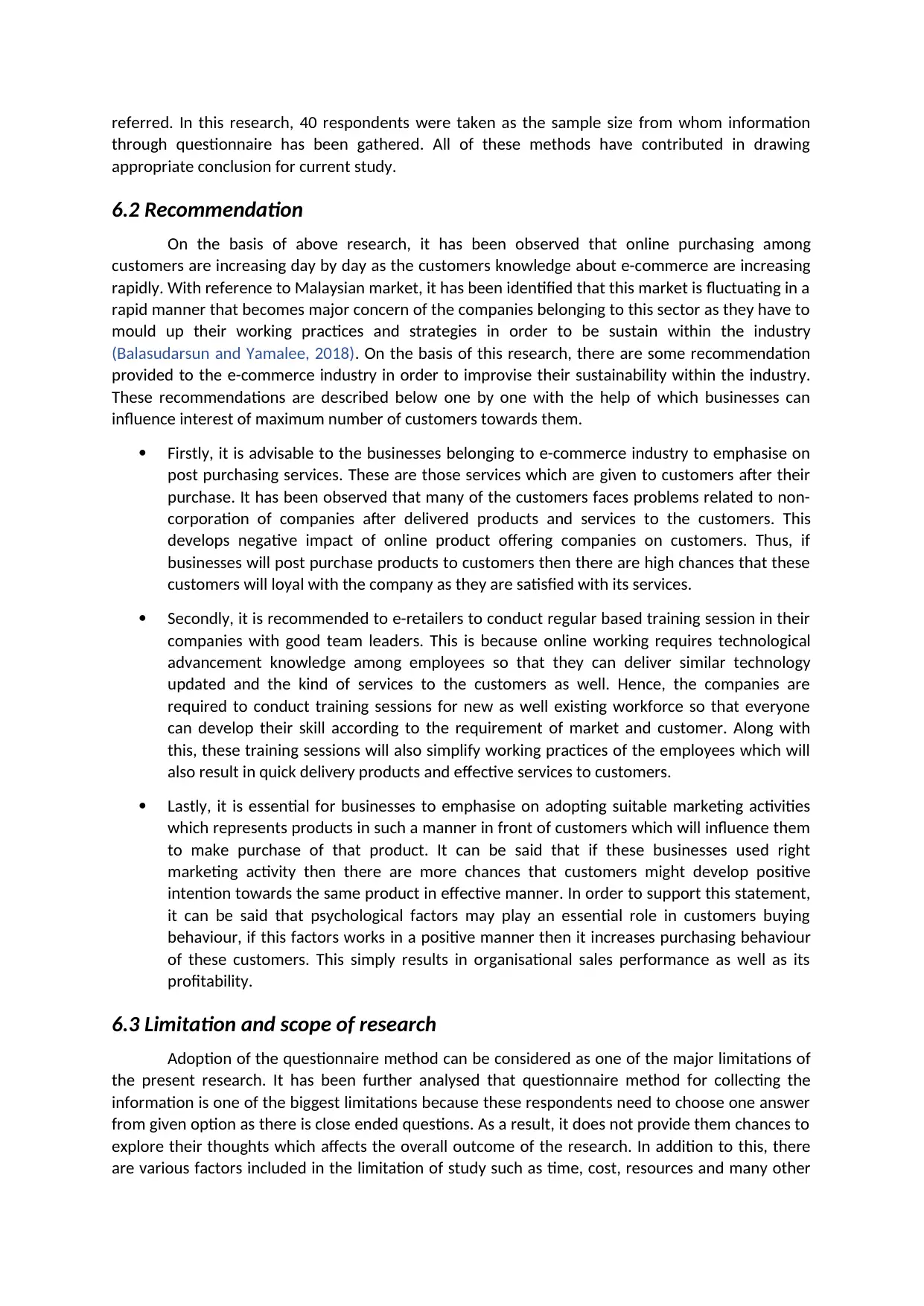
referred. In this research, 40 respondents were taken as the sample size from whom information
through questionnaire has been gathered. All of these methods have contributed in drawing
appropriate conclusion for current study.
6.2 Recommendation
On the basis of above research, it has been observed that online purchasing among
customers are increasing day by day as the customers knowledge about e-commerce are increasing
rapidly. With reference to Malaysian market, it has been identified that this market is fluctuating in a
rapid manner that becomes major concern of the companies belonging to this sector as they have to
mould up their working practices and strategies in order to be sustain within the industry
(Balasudarsun and Yamalee, 2018). On the basis of this research, there are some recommendation
provided to the e-commerce industry in order to improvise their sustainability within the industry.
These recommendations are described below one by one with the help of which businesses can
influence interest of maximum number of customers towards them.
Firstly, it is advisable to the businesses belonging to e-commerce industry to emphasise on
post purchasing services. These are those services which are given to customers after their
purchase. It has been observed that many of the customers faces problems related to non-
corporation of companies after delivered products and services to the customers. This
develops negative impact of online product offering companies on customers. Thus, if
businesses will post purchase products to customers then there are high chances that these
customers will loyal with the company as they are satisfied with its services.
Secondly, it is recommended to e-retailers to conduct regular based training session in their
companies with good team leaders. This is because online working requires technological
advancement knowledge among employees so that they can deliver similar technology
updated and the kind of services to the customers as well. Hence, the companies are
required to conduct training sessions for new as well existing workforce so that everyone
can develop their skill according to the requirement of market and customer. Along with
this, these training sessions will also simplify working practices of the employees which will
also result in quick delivery products and effective services to customers.
Lastly, it is essential for businesses to emphasise on adopting suitable marketing activities
which represents products in such a manner in front of customers which will influence them
to make purchase of that product. It can be said that if these businesses used right
marketing activity then there are more chances that customers might develop positive
intention towards the same product in effective manner. In order to support this statement,
it can be said that psychological factors may play an essential role in customers buying
behaviour, if this factors works in a positive manner then it increases purchasing behaviour
of these customers. This simply results in organisational sales performance as well as its
profitability.
6.3 Limitation and scope of research
Adoption of the questionnaire method can be considered as one of the major limitations of
the present research. It has been further analysed that questionnaire method for collecting the
information is one of the biggest limitations because these respondents need to choose one answer
from given option as there is close ended questions. As a result, it does not provide them chances to
explore their thoughts which affects the overall outcome of the research. In addition to this, there
are various factors included in the limitation of study such as time, cost, resources and many other
through questionnaire has been gathered. All of these methods have contributed in drawing
appropriate conclusion for current study.
6.2 Recommendation
On the basis of above research, it has been observed that online purchasing among
customers are increasing day by day as the customers knowledge about e-commerce are increasing
rapidly. With reference to Malaysian market, it has been identified that this market is fluctuating in a
rapid manner that becomes major concern of the companies belonging to this sector as they have to
mould up their working practices and strategies in order to be sustain within the industry
(Balasudarsun and Yamalee, 2018). On the basis of this research, there are some recommendation
provided to the e-commerce industry in order to improvise their sustainability within the industry.
These recommendations are described below one by one with the help of which businesses can
influence interest of maximum number of customers towards them.
Firstly, it is advisable to the businesses belonging to e-commerce industry to emphasise on
post purchasing services. These are those services which are given to customers after their
purchase. It has been observed that many of the customers faces problems related to non-
corporation of companies after delivered products and services to the customers. This
develops negative impact of online product offering companies on customers. Thus, if
businesses will post purchase products to customers then there are high chances that these
customers will loyal with the company as they are satisfied with its services.
Secondly, it is recommended to e-retailers to conduct regular based training session in their
companies with good team leaders. This is because online working requires technological
advancement knowledge among employees so that they can deliver similar technology
updated and the kind of services to the customers as well. Hence, the companies are
required to conduct training sessions for new as well existing workforce so that everyone
can develop their skill according to the requirement of market and customer. Along with
this, these training sessions will also simplify working practices of the employees which will
also result in quick delivery products and effective services to customers.
Lastly, it is essential for businesses to emphasise on adopting suitable marketing activities
which represents products in such a manner in front of customers which will influence them
to make purchase of that product. It can be said that if these businesses used right
marketing activity then there are more chances that customers might develop positive
intention towards the same product in effective manner. In order to support this statement,
it can be said that psychological factors may play an essential role in customers buying
behaviour, if this factors works in a positive manner then it increases purchasing behaviour
of these customers. This simply results in organisational sales performance as well as its
profitability.
6.3 Limitation and scope of research
Adoption of the questionnaire method can be considered as one of the major limitations of
the present research. It has been further analysed that questionnaire method for collecting the
information is one of the biggest limitations because these respondents need to choose one answer
from given option as there is close ended questions. As a result, it does not provide them chances to
explore their thoughts which affects the overall outcome of the research. In addition to this, there
are various factors included in the limitation of study such as time, cost, resources and many other
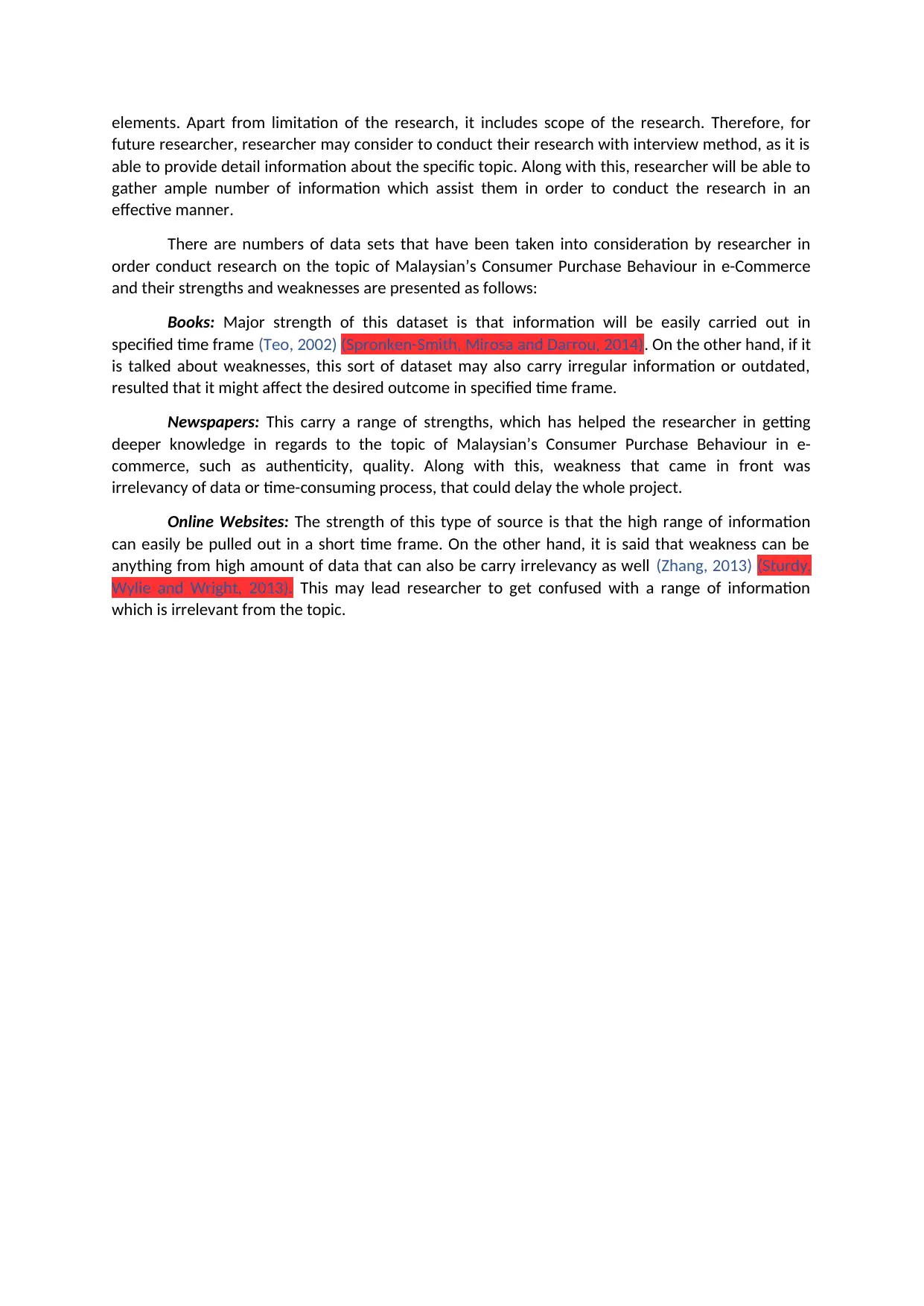
elements. Apart from limitation of the research, it includes scope of the research. Therefore, for
future researcher, researcher may consider to conduct their research with interview method, as it is
able to provide detail information about the specific topic. Along with this, researcher will be able to
gather ample number of information which assist them in order to conduct the research in an
effective manner.
There are numbers of data sets that have been taken into consideration by researcher in
order conduct research on the topic of Malaysian’s Consumer Purchase Behaviour in e-Commerce
and their strengths and weaknesses are presented as follows:
Books: Major strength of this dataset is that information will be easily carried out in
specified time frame (Teo, 2002) (Spronken-Smith, Mirosa and Darrou, 2014). On the other hand, if it
is talked about weaknesses, this sort of dataset may also carry irregular information or outdated,
resulted that it might affect the desired outcome in specified time frame.
Newspapers: This carry a range of strengths, which has helped the researcher in getting
deeper knowledge in regards to the topic of Malaysian’s Consumer Purchase Behaviour in e-
commerce, such as authenticity, quality. Along with this, weakness that came in front was
irrelevancy of data or time-consuming process, that could delay the whole project.
Online Websites: The strength of this type of source is that the high range of information
can easily be pulled out in a short time frame. On the other hand, it is said that weakness can be
anything from high amount of data that can also be carry irrelevancy as well (Zhang, 2013) (Sturdy,
Wylie and Wright, 2013). This may lead researcher to get confused with a range of information
which is irrelevant from the topic.
future researcher, researcher may consider to conduct their research with interview method, as it is
able to provide detail information about the specific topic. Along with this, researcher will be able to
gather ample number of information which assist them in order to conduct the research in an
effective manner.
There are numbers of data sets that have been taken into consideration by researcher in
order conduct research on the topic of Malaysian’s Consumer Purchase Behaviour in e-Commerce
and their strengths and weaknesses are presented as follows:
Books: Major strength of this dataset is that information will be easily carried out in
specified time frame (Teo, 2002) (Spronken-Smith, Mirosa and Darrou, 2014). On the other hand, if it
is talked about weaknesses, this sort of dataset may also carry irregular information or outdated,
resulted that it might affect the desired outcome in specified time frame.
Newspapers: This carry a range of strengths, which has helped the researcher in getting
deeper knowledge in regards to the topic of Malaysian’s Consumer Purchase Behaviour in e-
commerce, such as authenticity, quality. Along with this, weakness that came in front was
irrelevancy of data or time-consuming process, that could delay the whole project.
Online Websites: The strength of this type of source is that the high range of information
can easily be pulled out in a short time frame. On the other hand, it is said that weakness can be
anything from high amount of data that can also be carry irrelevancy as well (Zhang, 2013) (Sturdy,
Wylie and Wright, 2013). This may lead researcher to get confused with a range of information
which is irrelevant from the topic.
Paraphrase This Document
Need a fresh take? Get an instant paraphrase of this document with our AI Paraphraser
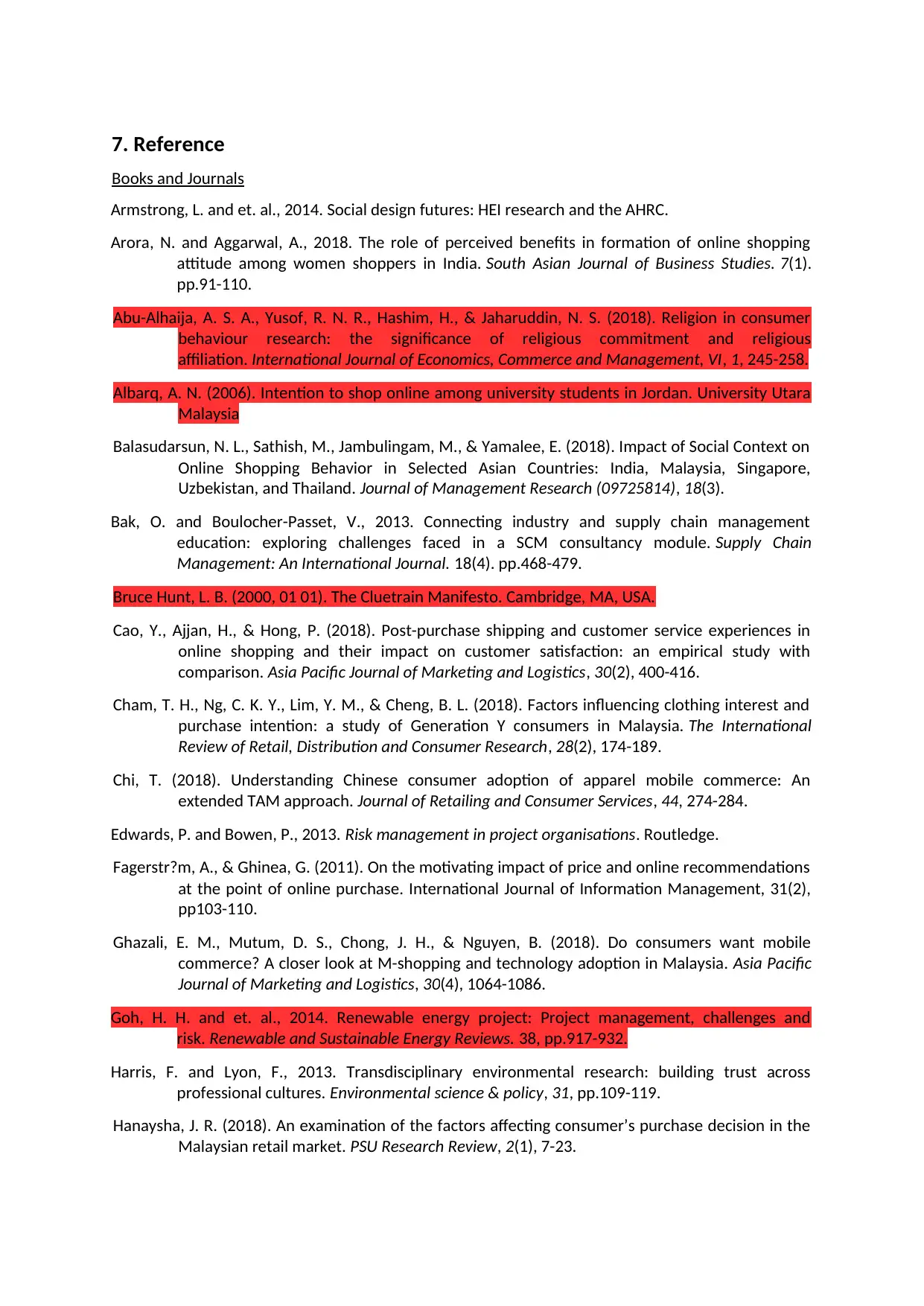
7. Reference
Books and Journals
Armstrong, L. and et. al., 2014. Social design futures: HEI research and the AHRC.
Arora, N. and Aggarwal, A., 2018. The role of perceived benefits in formation of online shopping
attitude among women shoppers in India. South Asian Journal of Business Studies. 7(1).
pp.91-110.
Abu-Alhaija, A. S. A., Yusof, R. N. R., Hashim, H., & Jaharuddin, N. S. (2018). Religion in consumer
behaviour research: the significance of religious commitment and religious
affiliation. International Journal of Economics, Commerce and Management, VI, 1, 245-258.
Albarq, A. N. (2006). Intention to shop online among university students in Jordan. University Utara
Malaysia
Balasudarsun, N. L., Sathish, M., Jambulingam, M., & Yamalee, E. (2018). Impact of Social Context on
Online Shopping Behavior in Selected Asian Countries: India, Malaysia, Singapore,
Uzbekistan, and Thailand. Journal of Management Research (09725814), 18(3).
Bak, O. and Boulocher-Passet, V., 2013. Connecting industry and supply chain management
education: exploring challenges faced in a SCM consultancy module. Supply Chain
Management: An International Journal. 18(4). pp.468-479.
Bruce Hunt, L. B. (2000, 01 01). The Cluetrain Manifesto. Cambridge, MA, USA.
Cao, Y., Ajjan, H., & Hong, P. (2018). Post-purchase shipping and customer service experiences in
online shopping and their impact on customer satisfaction: an empirical study with
comparison. Asia Pacific Journal of Marketing and Logistics, 30(2), 400-416.
Cham, T. H., Ng, C. K. Y., Lim, Y. M., & Cheng, B. L. (2018). Factors influencing clothing interest and
purchase intention: a study of Generation Y consumers in Malaysia. The International
Review of Retail, Distribution and Consumer Research, 28(2), 174-189.
Chi, T. (2018). Understanding Chinese consumer adoption of apparel mobile commerce: An
extended TAM approach. Journal of Retailing and Consumer Services, 44, 274-284.
Edwards, P. and Bowen, P., 2013. Risk management in project organisations. Routledge.
Fagerstr?m, A., & Ghinea, G. (2011). On the motivating impact of price and online recommendations
at the point of online purchase. International Journal of Information Management, 31(2),
pp103-110.
Ghazali, E. M., Mutum, D. S., Chong, J. H., & Nguyen, B. (2018). Do consumers want mobile
commerce? A closer look at M-shopping and technology adoption in Malaysia. Asia Pacific
Journal of Marketing and Logistics, 30(4), 1064-1086.
Goh, H. H. and et. al., 2014. Renewable energy project: Project management, challenges and
risk. Renewable and Sustainable Energy Reviews. 38, pp.917-932.
Harris, F. and Lyon, F., 2013. Transdisciplinary environmental research: building trust across
professional cultures. Environmental science & policy, 31, pp.109-119.
Hanaysha, J. R. (2018). An examination of the factors affecting consumer’s purchase decision in the
Malaysian retail market. PSU Research Review, 2(1), 7-23.
Books and Journals
Armstrong, L. and et. al., 2014. Social design futures: HEI research and the AHRC.
Arora, N. and Aggarwal, A., 2018. The role of perceived benefits in formation of online shopping
attitude among women shoppers in India. South Asian Journal of Business Studies. 7(1).
pp.91-110.
Abu-Alhaija, A. S. A., Yusof, R. N. R., Hashim, H., & Jaharuddin, N. S. (2018). Religion in consumer
behaviour research: the significance of religious commitment and religious
affiliation. International Journal of Economics, Commerce and Management, VI, 1, 245-258.
Albarq, A. N. (2006). Intention to shop online among university students in Jordan. University Utara
Malaysia
Balasudarsun, N. L., Sathish, M., Jambulingam, M., & Yamalee, E. (2018). Impact of Social Context on
Online Shopping Behavior in Selected Asian Countries: India, Malaysia, Singapore,
Uzbekistan, and Thailand. Journal of Management Research (09725814), 18(3).
Bak, O. and Boulocher-Passet, V., 2013. Connecting industry and supply chain management
education: exploring challenges faced in a SCM consultancy module. Supply Chain
Management: An International Journal. 18(4). pp.468-479.
Bruce Hunt, L. B. (2000, 01 01). The Cluetrain Manifesto. Cambridge, MA, USA.
Cao, Y., Ajjan, H., & Hong, P. (2018). Post-purchase shipping and customer service experiences in
online shopping and their impact on customer satisfaction: an empirical study with
comparison. Asia Pacific Journal of Marketing and Logistics, 30(2), 400-416.
Cham, T. H., Ng, C. K. Y., Lim, Y. M., & Cheng, B. L. (2018). Factors influencing clothing interest and
purchase intention: a study of Generation Y consumers in Malaysia. The International
Review of Retail, Distribution and Consumer Research, 28(2), 174-189.
Chi, T. (2018). Understanding Chinese consumer adoption of apparel mobile commerce: An
extended TAM approach. Journal of Retailing and Consumer Services, 44, 274-284.
Edwards, P. and Bowen, P., 2013. Risk management in project organisations. Routledge.
Fagerstr?m, A., & Ghinea, G. (2011). On the motivating impact of price and online recommendations
at the point of online purchase. International Journal of Information Management, 31(2),
pp103-110.
Ghazali, E. M., Mutum, D. S., Chong, J. H., & Nguyen, B. (2018). Do consumers want mobile
commerce? A closer look at M-shopping and technology adoption in Malaysia. Asia Pacific
Journal of Marketing and Logistics, 30(4), 1064-1086.
Goh, H. H. and et. al., 2014. Renewable energy project: Project management, challenges and
risk. Renewable and Sustainable Energy Reviews. 38, pp.917-932.
Harris, F. and Lyon, F., 2013. Transdisciplinary environmental research: building trust across
professional cultures. Environmental science & policy, 31, pp.109-119.
Hanaysha, J. R. (2018). An examination of the factors affecting consumer’s purchase decision in the
Malaysian retail market. PSU Research Review, 2(1), 7-23.
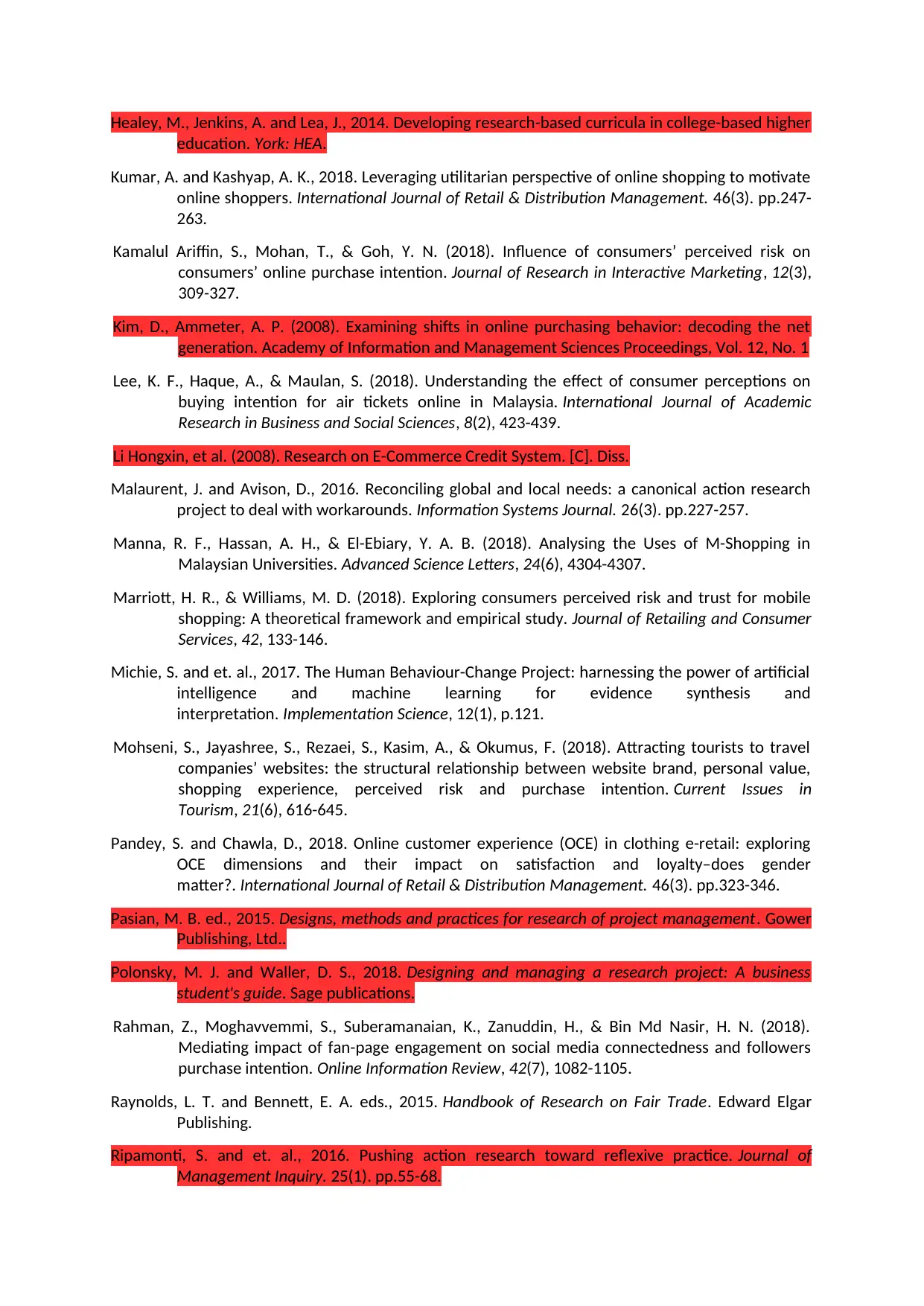
Healey, M., Jenkins, A. and Lea, J., 2014. Developing research-based curricula in college-based higher
education. York: HEA.
Kumar, A. and Kashyap, A. K., 2018. Leveraging utilitarian perspective of online shopping to motivate
online shoppers. International Journal of Retail & Distribution Management. 46(3). pp.247-
263.
Kamalul Ariffin, S., Mohan, T., & Goh, Y. N. (2018). Influence of consumers’ perceived risk on
consumers’ online purchase intention. Journal of Research in Interactive Marketing, 12(3),
309-327.
Kim, D., Ammeter, A. P. (2008). Examining shifts in online purchasing behavior: decoding the net
generation. Academy of Information and Management Sciences Proceedings, Vol. 12, No. 1
Lee, K. F., Haque, A., & Maulan, S. (2018). Understanding the effect of consumer perceptions on
buying intention for air tickets online in Malaysia. International Journal of Academic
Research in Business and Social Sciences, 8(2), 423-439.
Li Hongxin, et al. (2008). Research on E-Commerce Credit System. [C]. Diss.
Malaurent, J. and Avison, D., 2016. Reconciling global and local needs: a canonical action research
project to deal with workarounds. Information Systems Journal. 26(3). pp.227-257.
Manna, R. F., Hassan, A. H., & El-Ebiary, Y. A. B. (2018). Analysing the Uses of M-Shopping in
Malaysian Universities. Advanced Science Letters, 24(6), 4304-4307.
Marriott, H. R., & Williams, M. D. (2018). Exploring consumers perceived risk and trust for mobile
shopping: A theoretical framework and empirical study. Journal of Retailing and Consumer
Services, 42, 133-146.
Michie, S. and et. al., 2017. The Human Behaviour-Change Project: harnessing the power of artificial
intelligence and machine learning for evidence synthesis and
interpretation. Implementation Science, 12(1), p.121.
Mohseni, S., Jayashree, S., Rezaei, S., Kasim, A., & Okumus, F. (2018). Attracting tourists to travel
companies’ websites: the structural relationship between website brand, personal value,
shopping experience, perceived risk and purchase intention. Current Issues in
Tourism, 21(6), 616-645.
Pandey, S. and Chawla, D., 2018. Online customer experience (OCE) in clothing e-retail: exploring
OCE dimensions and their impact on satisfaction and loyalty–does gender
matter?. International Journal of Retail & Distribution Management. 46(3). pp.323-346.
Pasian, M. B. ed., 2015. Designs, methods and practices for research of project management. Gower
Publishing, Ltd..
Polonsky, M. J. and Waller, D. S., 2018. Designing and managing a research project: A business
student's guide. Sage publications.
Rahman, Z., Moghavvemmi, S., Suberamanaian, K., Zanuddin, H., & Bin Md Nasir, H. N. (2018).
Mediating impact of fan-page engagement on social media connectedness and followers
purchase intention. Online Information Review, 42(7), 1082-1105.
Raynolds, L. T. and Bennett, E. A. eds., 2015. Handbook of Research on Fair Trade. Edward Elgar
Publishing.
Ripamonti, S. and et. al., 2016. Pushing action research toward reflexive practice. Journal of
Management Inquiry. 25(1). pp.55-68.
education. York: HEA.
Kumar, A. and Kashyap, A. K., 2018. Leveraging utilitarian perspective of online shopping to motivate
online shoppers. International Journal of Retail & Distribution Management. 46(3). pp.247-
263.
Kamalul Ariffin, S., Mohan, T., & Goh, Y. N. (2018). Influence of consumers’ perceived risk on
consumers’ online purchase intention. Journal of Research in Interactive Marketing, 12(3),
309-327.
Kim, D., Ammeter, A. P. (2008). Examining shifts in online purchasing behavior: decoding the net
generation. Academy of Information and Management Sciences Proceedings, Vol. 12, No. 1
Lee, K. F., Haque, A., & Maulan, S. (2018). Understanding the effect of consumer perceptions on
buying intention for air tickets online in Malaysia. International Journal of Academic
Research in Business and Social Sciences, 8(2), 423-439.
Li Hongxin, et al. (2008). Research on E-Commerce Credit System. [C]. Diss.
Malaurent, J. and Avison, D., 2016. Reconciling global and local needs: a canonical action research
project to deal with workarounds. Information Systems Journal. 26(3). pp.227-257.
Manna, R. F., Hassan, A. H., & El-Ebiary, Y. A. B. (2018). Analysing the Uses of M-Shopping in
Malaysian Universities. Advanced Science Letters, 24(6), 4304-4307.
Marriott, H. R., & Williams, M. D. (2018). Exploring consumers perceived risk and trust for mobile
shopping: A theoretical framework and empirical study. Journal of Retailing and Consumer
Services, 42, 133-146.
Michie, S. and et. al., 2017. The Human Behaviour-Change Project: harnessing the power of artificial
intelligence and machine learning for evidence synthesis and
interpretation. Implementation Science, 12(1), p.121.
Mohseni, S., Jayashree, S., Rezaei, S., Kasim, A., & Okumus, F. (2018). Attracting tourists to travel
companies’ websites: the structural relationship between website brand, personal value,
shopping experience, perceived risk and purchase intention. Current Issues in
Tourism, 21(6), 616-645.
Pandey, S. and Chawla, D., 2018. Online customer experience (OCE) in clothing e-retail: exploring
OCE dimensions and their impact on satisfaction and loyalty–does gender
matter?. International Journal of Retail & Distribution Management. 46(3). pp.323-346.
Pasian, M. B. ed., 2015. Designs, methods and practices for research of project management. Gower
Publishing, Ltd..
Polonsky, M. J. and Waller, D. S., 2018. Designing and managing a research project: A business
student's guide. Sage publications.
Rahman, Z., Moghavvemmi, S., Suberamanaian, K., Zanuddin, H., & Bin Md Nasir, H. N. (2018).
Mediating impact of fan-page engagement on social media connectedness and followers
purchase intention. Online Information Review, 42(7), 1082-1105.
Raynolds, L. T. and Bennett, E. A. eds., 2015. Handbook of Research on Fair Trade. Edward Elgar
Publishing.
Ripamonti, S. and et. al., 2016. Pushing action research toward reflexive practice. Journal of
Management Inquiry. 25(1). pp.55-68.
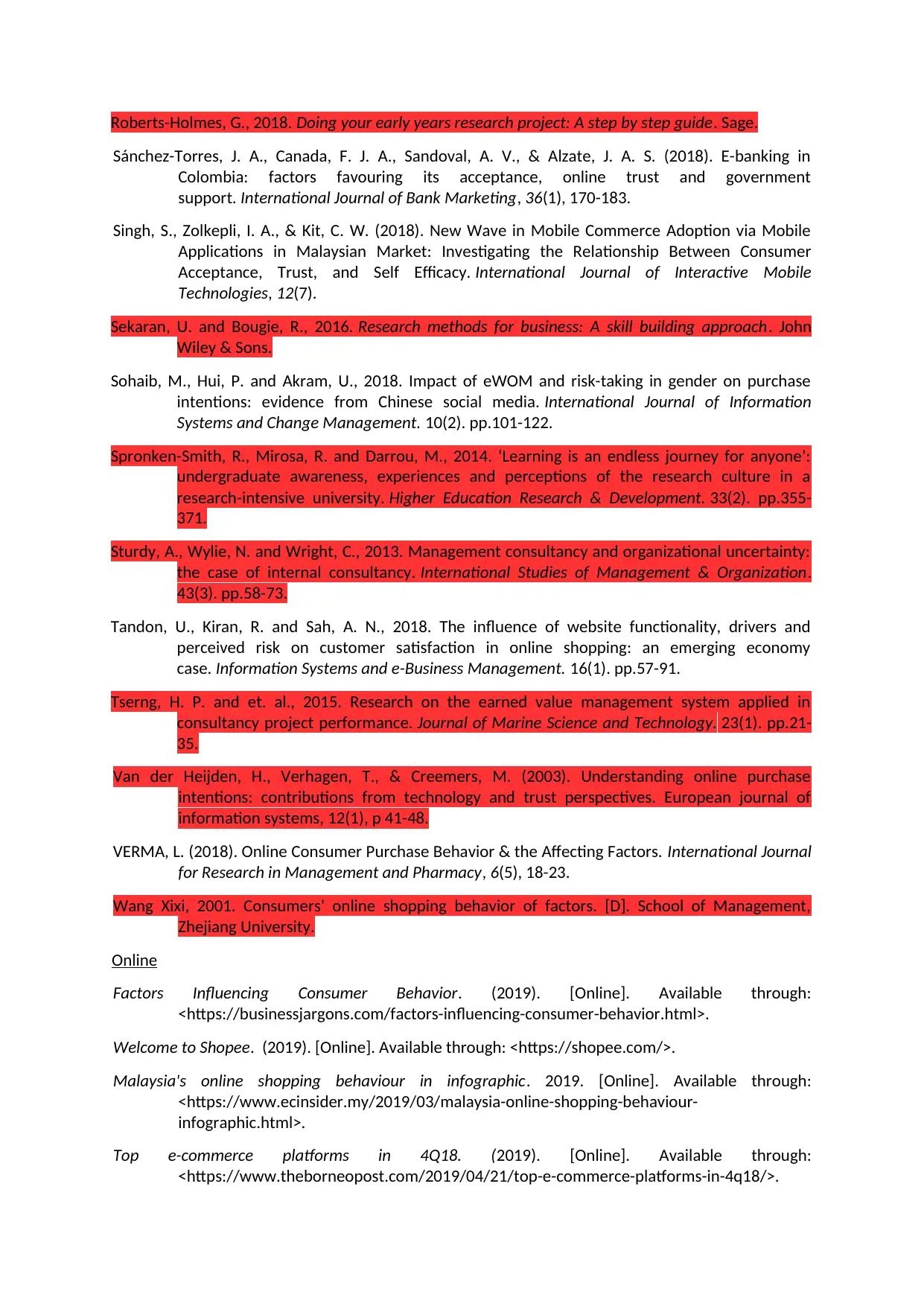
Roberts-Holmes, G., 2018. Doing your early years research project: A step by step guide. Sage.
Sánchez-Torres, J. A., Canada, F. J. A., Sandoval, A. V., & Alzate, J. A. S. (2018). E-banking in
Colombia: factors favouring its acceptance, online trust and government
support. International Journal of Bank Marketing, 36(1), 170-183.
Singh, S., Zolkepli, I. A., & Kit, C. W. (2018). New Wave in Mobile Commerce Adoption via Mobile
Applications in Malaysian Market: Investigating the Relationship Between Consumer
Acceptance, Trust, and Self Efficacy. International Journal of Interactive Mobile
Technologies, 12(7).
Sekaran, U. and Bougie, R., 2016. Research methods for business: A skill building approach. John
Wiley & Sons.
Sohaib, M., Hui, P. and Akram, U., 2018. Impact of eWOM and risk-taking in gender on purchase
intentions: evidence from Chinese social media. International Journal of Information
Systems and Change Management. 10(2). pp.101-122.
Spronken-Smith, R., Mirosa, R. and Darrou, M., 2014. ‘Learning is an endless journey for anyone’:
undergraduate awareness, experiences and perceptions of the research culture in a
research-intensive university. Higher Education Research & Development. 33(2). pp.355-
371.
Sturdy, A., Wylie, N. and Wright, C., 2013. Management consultancy and organizational uncertainty:
the case of internal consultancy. International Studies of Management & Organization.
43(3). pp.58-73.
Tandon, U., Kiran, R. and Sah, A. N., 2018. The influence of website functionality, drivers and
perceived risk on customer satisfaction in online shopping: an emerging economy
case. Information Systems and e-Business Management. 16(1). pp.57-91.
Tserng, H. P. and et. al., 2015. Research on the earned value management system applied in
consultancy project performance. Journal of Marine Science and Technology. 23(1). pp.21-
35.
Van der Heijden, H., Verhagen, T., & Creemers, M. (2003). Understanding online purchase
intentions: contributions from technology and trust perspectives. European journal of
information systems, 12(1), p 41-48.
VERMA, L. (2018). Online Consumer Purchase Behavior & the Affecting Factors. International Journal
for Research in Management and Pharmacy, 6(5), 18-23.
Wang Xixi, 2001. Consumers' online shopping behavior of factors. [D]. School of Management,
Zhejiang University.
Online
Factors Influencing Consumer Behavior. (2019). [Online]. Available through:
<https://businessjargons.com/factors-influencing-consumer-behavior.html>.
Welcome to Shopee. (2019). [Online]. Available through: <https://shopee.com/>.
Malaysia's online shopping behaviour in infographic. 2019. [Online]. Available through:
<https://www.ecinsider.my/2019/03/malaysia-online-shopping-behaviour-
infographic.html>.
Top e-commerce platforms in 4Q18. (2019). [Online]. Available through:
<https://www.theborneopost.com/2019/04/21/top-e-commerce-platforms-in-4q18/>.
Sánchez-Torres, J. A., Canada, F. J. A., Sandoval, A. V., & Alzate, J. A. S. (2018). E-banking in
Colombia: factors favouring its acceptance, online trust and government
support. International Journal of Bank Marketing, 36(1), 170-183.
Singh, S., Zolkepli, I. A., & Kit, C. W. (2018). New Wave in Mobile Commerce Adoption via Mobile
Applications in Malaysian Market: Investigating the Relationship Between Consumer
Acceptance, Trust, and Self Efficacy. International Journal of Interactive Mobile
Technologies, 12(7).
Sekaran, U. and Bougie, R., 2016. Research methods for business: A skill building approach. John
Wiley & Sons.
Sohaib, M., Hui, P. and Akram, U., 2018. Impact of eWOM and risk-taking in gender on purchase
intentions: evidence from Chinese social media. International Journal of Information
Systems and Change Management. 10(2). pp.101-122.
Spronken-Smith, R., Mirosa, R. and Darrou, M., 2014. ‘Learning is an endless journey for anyone’:
undergraduate awareness, experiences and perceptions of the research culture in a
research-intensive university. Higher Education Research & Development. 33(2). pp.355-
371.
Sturdy, A., Wylie, N. and Wright, C., 2013. Management consultancy and organizational uncertainty:
the case of internal consultancy. International Studies of Management & Organization.
43(3). pp.58-73.
Tandon, U., Kiran, R. and Sah, A. N., 2018. The influence of website functionality, drivers and
perceived risk on customer satisfaction in online shopping: an emerging economy
case. Information Systems and e-Business Management. 16(1). pp.57-91.
Tserng, H. P. and et. al., 2015. Research on the earned value management system applied in
consultancy project performance. Journal of Marine Science and Technology. 23(1). pp.21-
35.
Van der Heijden, H., Verhagen, T., & Creemers, M. (2003). Understanding online purchase
intentions: contributions from technology and trust perspectives. European journal of
information systems, 12(1), p 41-48.
VERMA, L. (2018). Online Consumer Purchase Behavior & the Affecting Factors. International Journal
for Research in Management and Pharmacy, 6(5), 18-23.
Wang Xixi, 2001. Consumers' online shopping behavior of factors. [D]. School of Management,
Zhejiang University.
Online
Factors Influencing Consumer Behavior. (2019). [Online]. Available through:
<https://businessjargons.com/factors-influencing-consumer-behavior.html>.
Welcome to Shopee. (2019). [Online]. Available through: <https://shopee.com/>.
Malaysia's online shopping behaviour in infographic. 2019. [Online]. Available through:
<https://www.ecinsider.my/2019/03/malaysia-online-shopping-behaviour-
infographic.html>.
Top e-commerce platforms in 4Q18. (2019). [Online]. Available through:
<https://www.theborneopost.com/2019/04/21/top-e-commerce-platforms-in-4q18/>.
Secure Best Marks with AI Grader
Need help grading? Try our AI Grader for instant feedback on your assignments.

Key insights about Malaysian eCommerce. (2019). [Online]. Available through:
<https://blog.withdipp.com/en/key-insights-about-malaysian-ecommerce>.
10 Online Shopping Personality Traits. (2014). [Online]. Available through:
<https://www.clickz.com/10-online-shopping-personality-traits/46478/>.
Top eCommerce platforms in Southeast Asia. (2019). [Online]. Available through:
<https://www.marketing-interactive.com/top-ecommerce-platforms-in-southeast-asia/>.
Malaysia’s e-commerce industry poised for strong growth in 2H19. (2019). [Online]. Available
through: <https://www.thestar.com.my/business/business-news/2019/07/12/malaysia-e-
commerce-industry-poised-for-strong-growth-in-second-half>.
<https://blog.withdipp.com/en/key-insights-about-malaysian-ecommerce>.
10 Online Shopping Personality Traits. (2014). [Online]. Available through:
<https://www.clickz.com/10-online-shopping-personality-traits/46478/>.
Top eCommerce platforms in Southeast Asia. (2019). [Online]. Available through:
<https://www.marketing-interactive.com/top-ecommerce-platforms-in-southeast-asia/>.
Malaysia’s e-commerce industry poised for strong growth in 2H19. (2019). [Online]. Available
through: <https://www.thestar.com.my/business/business-news/2019/07/12/malaysia-e-
commerce-industry-poised-for-strong-growth-in-second-half>.
1 out of 38
Related Documents
Your All-in-One AI-Powered Toolkit for Academic Success.
+13062052269
info@desklib.com
Available 24*7 on WhatsApp / Email
![[object Object]](/_next/static/media/star-bottom.7253800d.svg)
Unlock your academic potential
© 2024 | Zucol Services PVT LTD | All rights reserved.





